Show HN Today: Discover the Latest Innovative Projects from the Developer Community
 ShowHN Today
ShowHN TodayShow HN Today: Top Developer Projects Showcase for 2025-07-19
SagaSu777 2025-07-20
Explore the hottest developer projects on Show HN for 2025-07-19. Dive into innovative tech, AI applications, and exciting new inventions!
Summary of Today’s Content
Trend Insights
Today's Show HN projects highlight a strong trend toward using AI to solve practical problems, like code documentation, and to enhance existing workflows, from study aids to financial planning. Developers are actively seeking ways to automate tedious tasks and create more efficient tools. Privacy is a significant concern, leading to innovative solutions where data processing happens locally, reducing the risk of data breaches. This shift underscores a renewed emphasis on user control and data security, inspiring developers to build applications that prioritize user privacy. For developers and startups, the opportunity lies in building AI-powered tools that are both helpful and data-conscious, providing a seamless user experience while safeguarding sensitive information. Embrace open-source principles to foster collaboration and accelerate innovation; there is a growing need for tools that empower developers and offer solutions that fit their unique needs. The creators are showcasing a deep understanding of user needs and the power of technology to solve real-world problems, encouraging everyone to find and resolve the everyday problems and to create your own solutions with the technology available to you.
Today's Hottest Product
Name
Context42 – capture your coding style from across your projects
Highlight
This project leverages AI to automatically generate style guides based on your existing codebase. It analyzes your code, identifies patterns, and documents them using AI. The key takeaway is that it helps you maintain coding consistency by adapting to your existing style rather than enforcing rigid rules. Developers can learn to use AI to automate code documentation, saving time and improving team collaboration.
Popular Category
AI
Development Tools
Web Apps
Finance
Popular Keyword
AI
Open Source
Deployment
Privacy
Technology Trends
AI-powered automation for code analysis and documentation
AI for personalized learning and productivity tools
Simplified deployment and infrastructure solutions for developers
Focus on privacy and data security in web applications
Innovative approaches to financial tools, like interest rate calculation
Project Category Distribution
Development Tools & Automation (30%)
AI Applications (20%)
Web Applications & Utilities (30%)
Finance & Productivity (10%)
Games & Entertainment (10%)
Today's Hot Product List
| Ranking | Product Name | Likes | Comments |
|---|---|---|---|
| 1 | Am-I-vibing: Agentic Coding Environment Detector | 57 | 26 |
| 2 | Lorekeep: Personalized Book Recommendation Engine | 19 | 11 |
| 3 | ViralVideoImplant - A Face-Swapping Toolkit for Meme Domination | 22 | 0 |
| 4 | UView – Unity Package Explorer & Modifier | 8 | 0 |
| 5 | Skeuomorphic Scan: A Retro iOS 6.0 Document Scanner | 5 | 2 |
| 6 | mcp-agent: Your Personalized AI Investment & Real Estate Assistant | 4 | 2 |
| 7 | Context42: Gemini AI-Powered Code Style Guide Generator | 3 | 3 |
| 8 | Libre: Anonymous Thought Amplifier | 5 | 0 |
| 9 | TypeSpider: The Typing Web Weaver | 5 | 0 |
| 10 | Klartraum: Neural Rendering Inference Engine | 4 | 0 |
1
Am-I-vibing: Agentic Coding Environment Detector
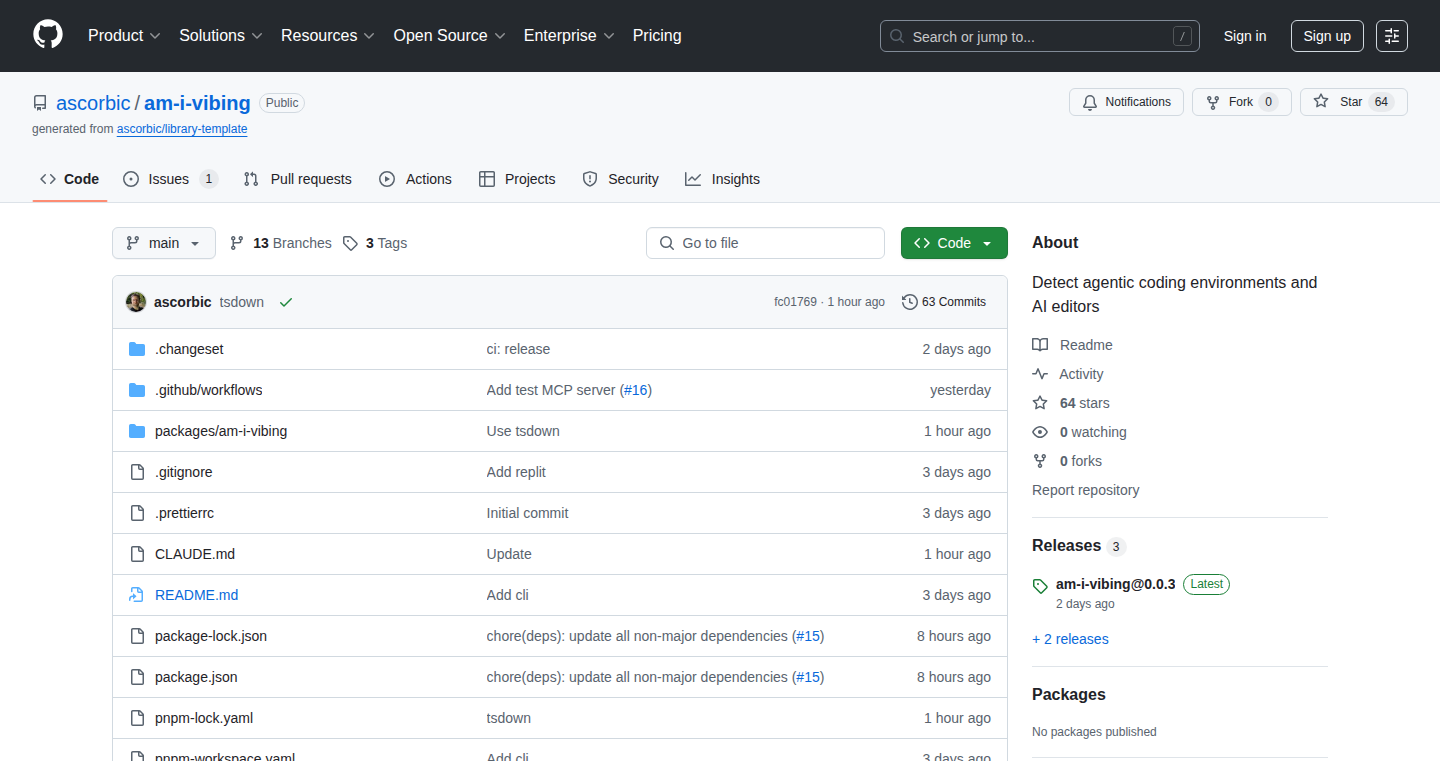
Author
ascorbic
Description
This project, "Am-I-vibing," analyzes your coding environment to determine if it's conducive to "agentic coding" – a style that leverages AI to assist with coding tasks. It aims to identify the presence of tools and setups that facilitate AI-driven code generation, debugging, and overall development. The core innovation lies in its ability to assess the environment's agentic potential, providing insights into how well it supports modern AI-assisted coding practices. This solves the problem of developers lacking an easy way to gauge if their existing setup is optimized for AI-powered coding, which is increasingly important in modern software development.
Popularity
Points 57
Comments 26
What is this product?
Am-I-vibing is essentially a diagnostic tool. It examines your development environment (e.g., your code editor, installed extensions, terminal configuration) to see if it's optimized for using AI coding assistants. It checks for features like AI code completion, automated debugging tools, and seamless integration with AI-powered code generation platforms. So it tells you if you're set up to get the most out of AI in your coding workflow. The innovation is that it automates the assessment of these configurations.
How to use it?
Developers would run Am-I-vibing on their development setup. The tool would analyze the configuration and generate a report indicating the 'agentic score' - how well the environment is set up for AI-assisted coding. It would also highlight potential improvements and recommendations, such as suggesting specific extensions or tools that could enhance the environment's AI capabilities. Think of it as a tech-savvy "checkup" for your coding setup. So you can tweak your settings and get the most out of AI-powered tools.
Product Core Function
· Environment Analysis: Scans the coding environment (editor, terminal, etc.) to identify the presence of AI-related tools and settings. This helps developers understand what AI-related capabilities are already present in their setup. It provides a quick overview of the current state of their environment. So you know what features your coding setup has for AI-assisted coding.
· Agentic Score Calculation: Assigns an "agentic score" based on the analysis, providing a quantitative measure of how well the environment supports AI-driven coding. This gives developers a clear, measurable indicator of their environment's AI readiness. So you get a number that lets you know how ready you are for AI-assisted coding.
· Recommendation Engine: Suggests improvements and potential tools to enhance the environment's agentic capabilities, such as recommending specific extensions, AI models, or coding practices. This is useful for developers seeking to improve their AI workflow. So you get advice on how to improve your environment's AI coding capability.
· Configuration Reporting: Generates a report summarizing the analysis and recommendations, making it easy for developers to understand and implement changes. This provides a concise overview of the environment's state and actionable insights. So you get a simple-to-understand overview of the state of your AI-coding-ready setup.
Product Usage Case
· Identifying AI-Assisted Code Completion: A developer is unsure if their current editor supports AI code completion. They can run Am-I-vibing to check. The tool detects the presence of relevant extensions and provides recommendations. So the developer gets a quick overview of what capabilities are installed on their editor.
· Optimizing Debugging Workflows: A team wants to integrate AI-powered debugging tools into their workflow. Am-I-vibing can analyze the current setup and suggest tools that integrate AI-powered error detection and resolution. So the team is able to find ways to improve their debugging workflows.
· Adopting AI-Powered Code Generation: A developer starting with AI-assisted coding may not know which tools to use. Am-I-vibing can analyze the environment and recommend specific tools and extensions to facilitate AI-driven code generation. So the developer finds the tools that work for their specific environment to jumpstart AI-assisted coding.
2
Lorekeep: Personalized Book Recommendation Engine
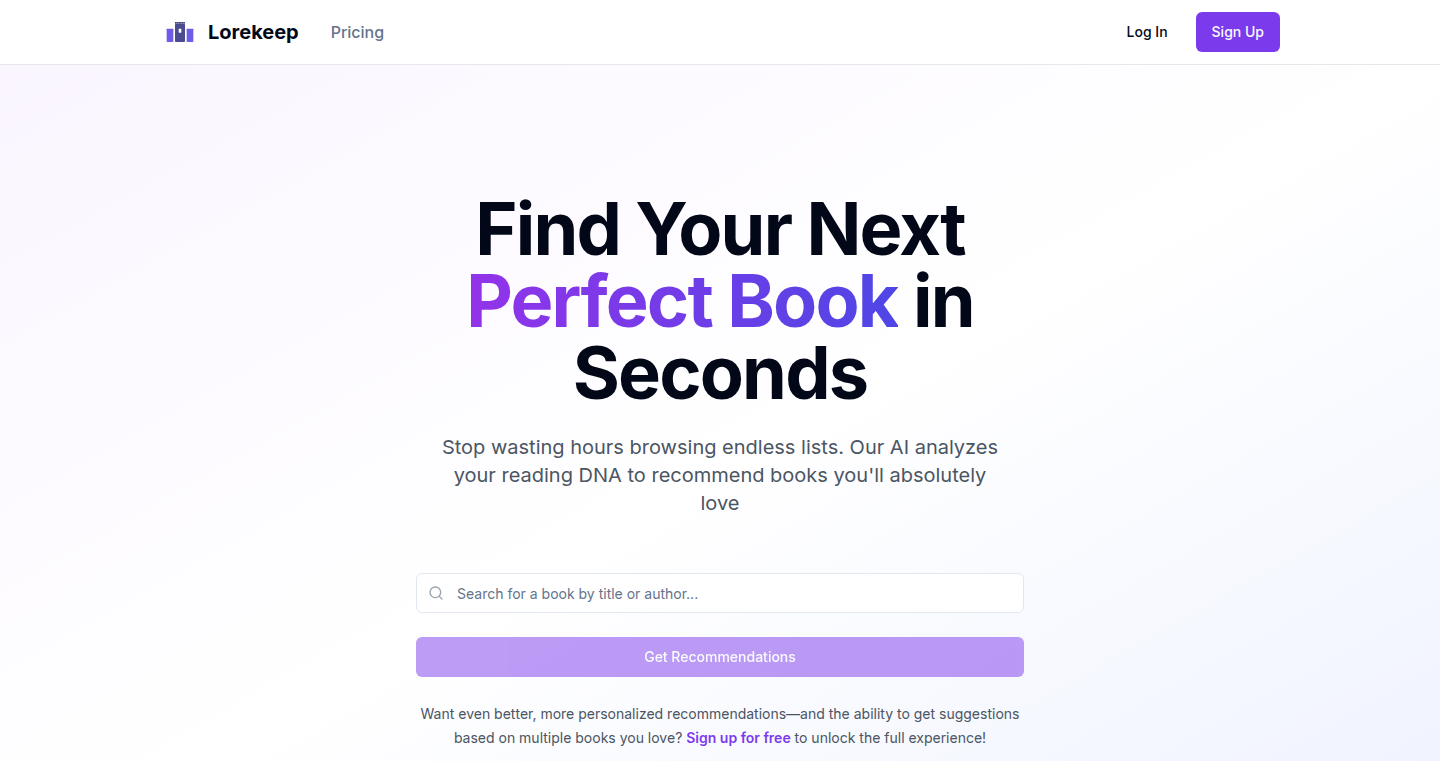
Author
delta234
Description
Lorekeep is a book recommendation engine built to provide better, more personalized book suggestions. It tackles the common problem of generic recommendation systems by focusing on content similarity and individual user preferences. This project uses techniques like content-based filtering, Natural Language Processing (NLP) to analyze book descriptions, and user interaction data to offer highly relevant book recommendations, which is a leap forward from simple 'most popular' suggestions.
Popularity
Points 19
Comments 11
What is this product?
Lorekeep is a smart engine that suggests books you might love. Instead of just showing what's popular, it digs into the actual content of the books. It uses a system that reads the book descriptions (like a very smart reader!) to understand what the book is about. Then, it figures out what you like based on your past book choices and the things you tell it you're interested in. So, if you loved a book about space exploration, Lorekeep will find other books with similar themes or writing styles. This is different because it understands the *meaning* of the book, not just popularity.
How to use it?
Developers can use Lorekeep in their own websites or applications to provide book recommendations to their users. You can integrate it by sending book information (like descriptions and author details) and user preferences to Lorekeep's API. The API will then return a list of recommended books. This is useful for online bookstores, book review sites, or even personal libraries where you want to help users discover new books they'll enjoy. So, if you are a developer, you can easily add a book recommendation feature to your website!
Product Core Function
· Content-Based Filtering: Lorekeep analyzes book descriptions using NLP techniques to understand the subject matter, themes, and writing style. This allows the system to identify books with similar content, even if they aren't from the same author or genre. This is valuable because it helps users find books that match their interests, not just what's popular. So, this helps you find those hidden gems that you might miss.
· User Preference Modeling: The system tracks user interactions, such as books they've read, rated, or marked as favorites. It uses this information to build a profile of the user's preferences. By understanding what a user likes, Lorekeep can provide highly personalized recommendations. This provides a customized experience for the end-user. So, it recommends books that are more likely to be a good fit for you.
· API Integration: Lorekeep offers an API that allows developers to easily integrate the recommendation engine into their own applications. This makes it simple for developers to add book recommendation features to their websites or apps without having to build their own complex recommendation system from scratch. So, you don't have to build this from scratch, it offers an off-the-shelf solution.
Product Usage Case
· Online Bookstore Integration: An online bookstore could integrate Lorekeep to suggest books to its users. When a user views a book, Lorekeep could show related books based on content similarity, author, or genre. This improves the user experience and could increase sales. So, it can help you find more customers and increase sales.
· Personal Library Management: A user could create a personal book library and use Lorekeep to organize and suggest books they may want to read next. The engine could provide recommendations based on what the user has read or what they have on their 'to-read' list. So, you can always have a book available to read!
· Book Review Website: A book review website could use Lorekeep to provide recommendations to its users based on book reviews and ratings. This allows users to discover new books that are similar to those they have already enjoyed, increasing the likelihood of them finding a book they will love. So, you are able to get even more personalized suggestions.
3
ViralVideoImplant - A Face-Swapping Toolkit for Meme Domination
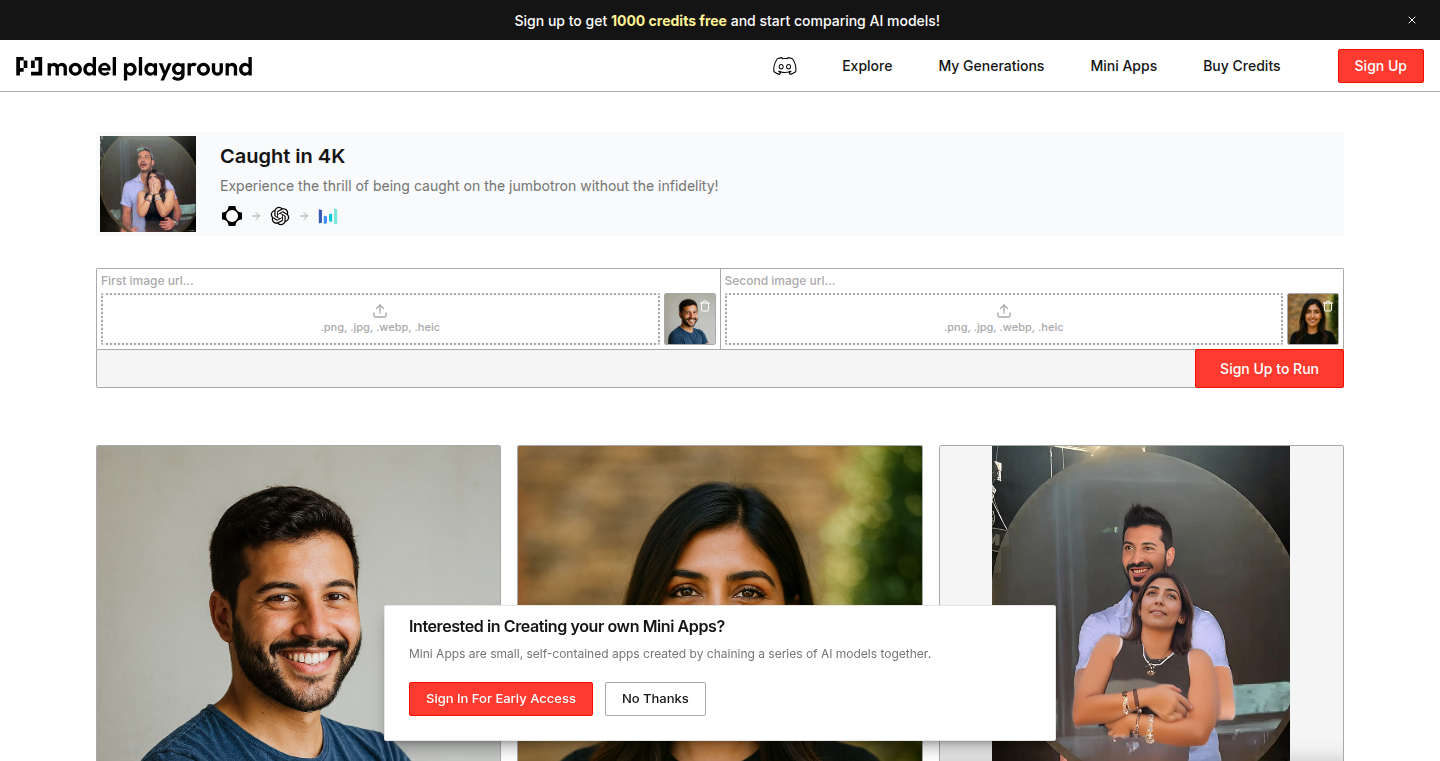
Author
abhi3188
Description
ViralVideoImplant is a project allowing users to seamlessly insert their face into existing videos, specifically targeting viral content like the recent Coldplay cheating video. It leverages deepfake technology and advanced image processing to achieve realistic face swaps. This project tackles the technical challenge of automatically aligning and blending faces within dynamic video environments, opening up possibilities for personalized content creation and meme generation. So this allows you to create funny videos and potentially go viral yourself!
Popularity
Points 22
Comments 0
What is this product?
This project uses deep learning techniques, similar to how sophisticated AI can 'learn' a person's face, to swap faces in videos. The core innovation is the automated process. Instead of manually editing each frame, the system analyzes the original video, identifies faces, and intelligently places your face, matching lighting and angles. This allows anyone to participate in viral content and create entertaining videos easily. So this enables everyone to easily make personalized videos.
How to use it?
Developers would likely interact with ViralVideoImplant through a command-line interface or a scriptable API. The process involves providing the target video, a source image of the user's face, and specifying output parameters. The system then processes the video, performing the face swap and generating a new video file. Potential uses include integrating it into video editing tools or developing applications for personalized content generation on social media platforms. So this gives developers a way to integrate face-swapping into their applications.
Product Core Function
· Automated Face Detection and Alignment: The system automatically locates faces in the target video and aligns the user's face for optimal blending. This reduces the manual effort needed to get the swap right, making it much easier to use. So this simplifies the face-swapping process.
· Realistic Face Blending: ViralVideoImplant attempts to match the lighting, skin tone, and angles of the inserted face with the target video, creating a seamless and believable result. This ensures the face swap looks natural and less 'fake'. So this makes the swapped faces appear more real.
· Video Processing Pipeline: The project creates a full pipeline for processing videos, handling the different steps from analyzing the source video to generating the output. This is efficient and allows for easier application. So this gives a complete solution for face swapping.
· Support for Various Video Formats: The toolkit likely supports a range of video formats to make the tool as widely usable as possible. So this means you can probably use it on the videos you care about.
Product Usage Case
· Meme Creation: A user could quickly swap their face into a popular video clip and create a customized meme to share on social media. So this helps in generating fun, shareable content.
· Personalized Greetings: Individuals could use the tool to insert their face into a pre-recorded message, creating personalized video greetings for friends and family. So this allows for creating personalized video greetings.
· Content Creation for Social Media: Influencers or content creators could leverage the technology to rapidly produce engaging videos for platforms such as TikTok or Instagram. So this gives content creators a new tool for creating content.
4
UView – Unity Package Explorer & Modifier
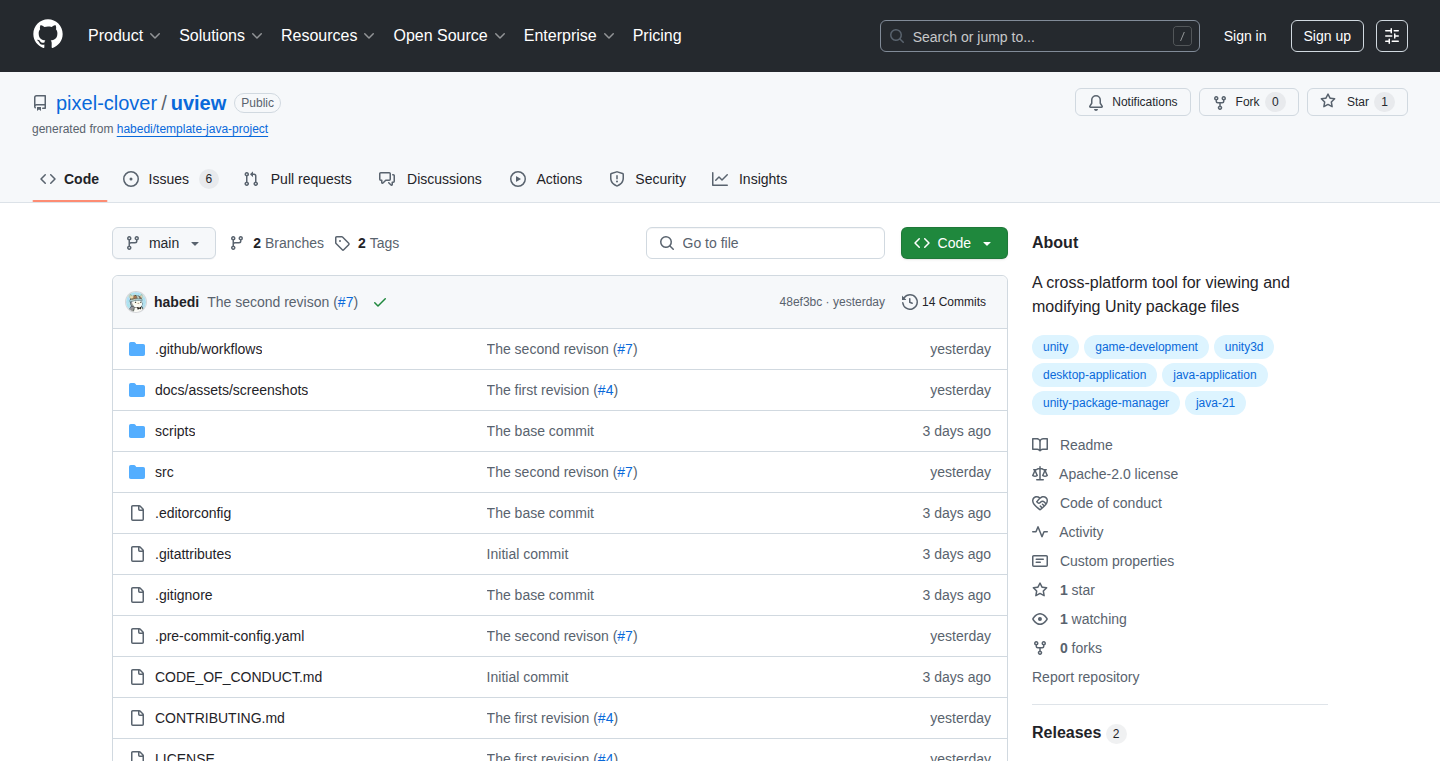
Author
habedi0
Description
UView is a nifty tool that lets you peek inside Unity packages, even without opening the Unity editor. It's like having X-ray vision for your Unity projects. The core innovation lies in its ability to parse and modify package contents directly, bypassing the usual Unity workflow. This solves the problem of needing to launch Unity just to view or tweak a small component, saving developers valuable time and resources.
Popularity
Points 8
Comments 0
What is this product?
UView is a standalone application that understands the internal structure of Unity packages. It can open and display the files within a .unitypackage file, including scripts, assets, and metadata. The cool part? You can also modify these files, potentially changing textures, scripts, or other project elements. So, it gives you a powerful way to manage and manipulate your Unity packages without the overhead of starting up the Unity editor itself.
How to use it?
Developers can use UView by simply pointing it to a .unitypackage file. You can then browse the contents, preview assets, and even make changes to things like text files or configuration data. To integrate it into a workflow, developers can use it as a pre- or post-processing step for Unity projects, scripting changes to packages before or after they're imported into a Unity project. This makes it easy to automate small tasks, or batch modify a set of assets.
Product Core Function
· Package Contents Browsing: Allows developers to explore the internal files and folders within a Unity package. It’s like a file explorer for your packages. Value: Quickly see the content of packages, which is helpful for understanding what’s inside a downloaded asset pack, or seeing the internal structure of your own packages. This saves time compared to opening Unity itself. Application: Diagnosing issues with imported assets, previewing assets before importing.
· Asset Previewing: Displays previews of images, models, and other assets stored within a package. Value: Helps developers quickly identify and evaluate assets without having to import them into a project. This aids in resource selection. Application: Reviewing asset packs from the Unity Asset Store, choosing specific assets within a larger package.
· File Modification: Allows developers to directly edit text-based files (scripts, configuration files, etc.) inside a package. Value: Allows quick tweaks to assets or settings, e.g. quickly modifying settings or fixing errors. Application: Modifying scripts to fix small bugs, changing configuration files to customize settings.
Product Usage Case
· Automating Asset Tweaks: A developer downloads a package containing multiple textures and wants to rename some files. Using UView, they can script the renaming of files directly inside the package before importing them into a project, saving time compared to manually renaming inside Unity. So this saves time!
· Patching Packages: A developer discovers a bug in an asset purchased from the Asset Store. UView allows them to open the package, edit the buggy script, and save it. Now, they can integrate the fixed package in their workflow. So, this streamlines the bug-fixing process.
· Bulk Configuration Changes: A developer needs to adjust the settings in a large number of assets within various packages. Using UView, they can write a script to modify the relevant configuration files across all packages, enabling centralized configuration. So, this allows for efficient batch processing.
5
Skeuomorphic Scan: A Retro iOS 6.0 Document Scanner
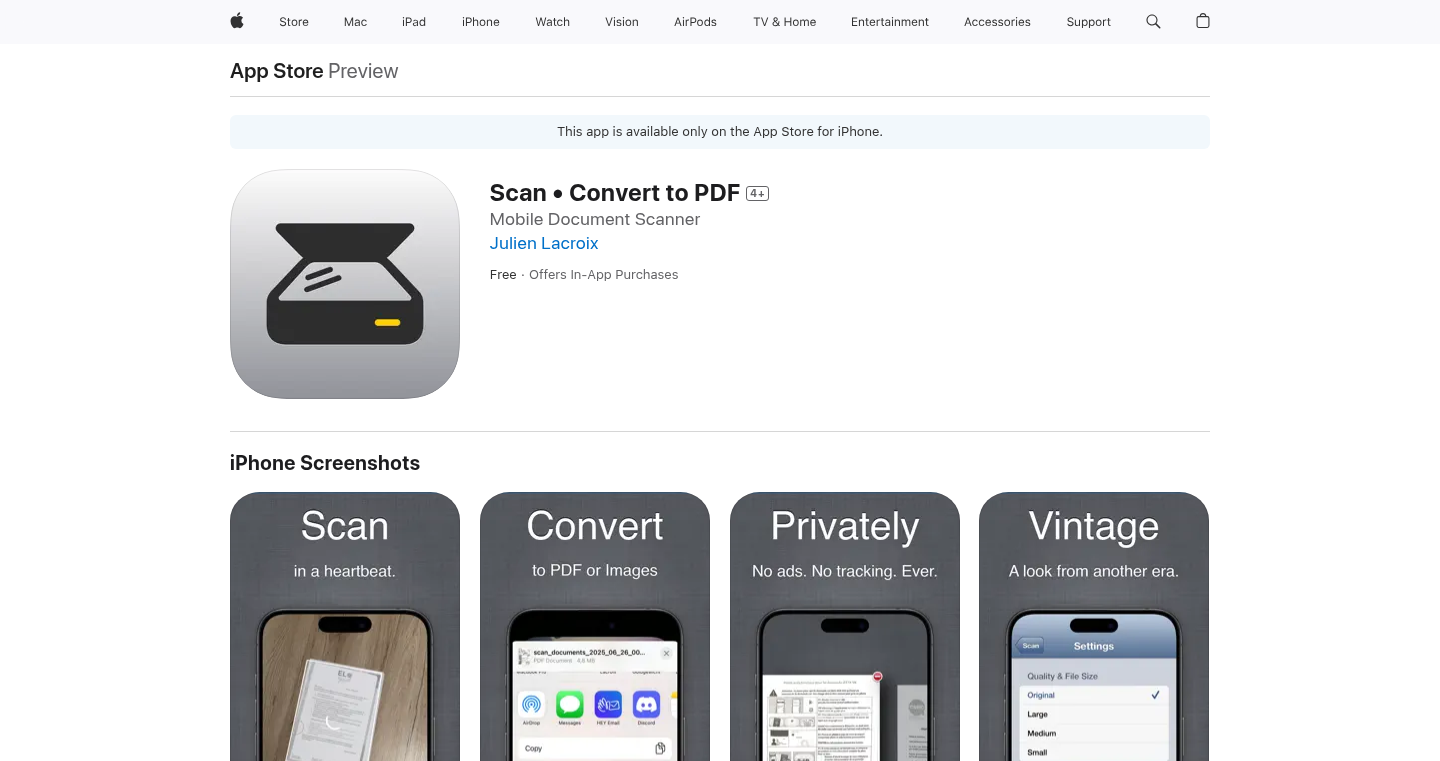
Author
JulienLacr0ix
Description
This project brings back the visual style of iOS 6.0 (think lots of shadows and textures) to a document scanning app. It allows users to quickly scan documents using their phone's camera, just like taking a photo. The core innovation is blending a modern utility (document scanning) with a nostalgic design, offering a unique user experience and a fun dive back into a classic design era. It’s an interesting example of how design choices can influence user perception and potentially offer a different take on common tasks.
Popularity
Points 5
Comments 2
What is this product?
This app works by using the phone's camera to capture images of documents. It then likely uses image processing techniques, probably edge detection and perspective correction, to automatically identify and straighten the document within the image. Finally, it applies a skeuomorphic design, emulating the look and feel of iOS 6.0, to the user interface. So, this project is about bringing a functional document scanner with a retro aesthetic. The innovation is the combination of a practical tool with a distinctive visual style that appeals to nostalgia.
How to use it?
Developers can't directly use this app in their projects, as it's a standalone app. However, this project can inspire developers to think outside the box about user interface design. Developers can learn from the project to understand how design choices can influence user experience. For example, it demonstrates how seemingly outdated design principles can still be engaging. This project showcases how to create a functional app with a unique visual approach, potentially giving developers new ideas for their own projects. So, it's about learning to blend functionality with aesthetic in unexpected ways.
Product Core Function
· Document Scanning: The primary function is to quickly scan documents using the phone's camera. This involves capturing the image, probably using built-in camera APIs. The value is creating a convenient way to digitize physical documents. This is useful for users needing to capture receipts, notes, or any paper-based information, and integrate these to digital formats.
· Image Processing: The app uses image processing to detect document edges, crop, and correct perspective. This ensures a clean, usable scan even if the photo isn't taken perfectly. It adds a lot of value because it automatically improves the quality of scans, making them ready to use with minimal effort. This is crucial for getting accurate scans from a variety of angles.
· Skeuomorphic UI: The most distinctive feature is the UI design that emulates iOS 6.0. This includes textures, shadows, and other visual elements that were common in older versions of iOS. The value here is to provide a nostalgic and unique user experience. This is beneficial for users who appreciate retro design and a different visual approach. It also can increase user engagement by making the app more enjoyable to use.
· Share/Export: The ability to share or export scanned documents in various formats (e.g., PDF, image) is essential for usability. The value is making it easy for users to integrate the scanned documents with other apps or share with others. This makes the scanned content useful and versatile.
Product Usage Case
· Personal archiving: Users can scan receipts or notes for personal records. This makes it easier to organize documents digitally, saving space and time. So, it’s helpful for anyone who needs an efficient way to manage their documents.
· Educational use: Students can scan textbook pages or handwritten notes. This allows students to digitally archive and share their study materials. So, it helps improve study efficiency.
· Business use: Small business owners can use it to scan invoices and other important documents. This simplifies office tasks and organizes documentation. So, it helps companies improve efficiency with document management.
· Design Inspiration: For developers, it showcases how to marry a functional app with an aesthetic design. By going back to older design trends, it provides inspiration for developers who want to bring a new perspective to their app designs. This offers a unique view on design possibilities for developers.
6
mcp-agent: Your Personalized AI Investment & Real Estate Assistant
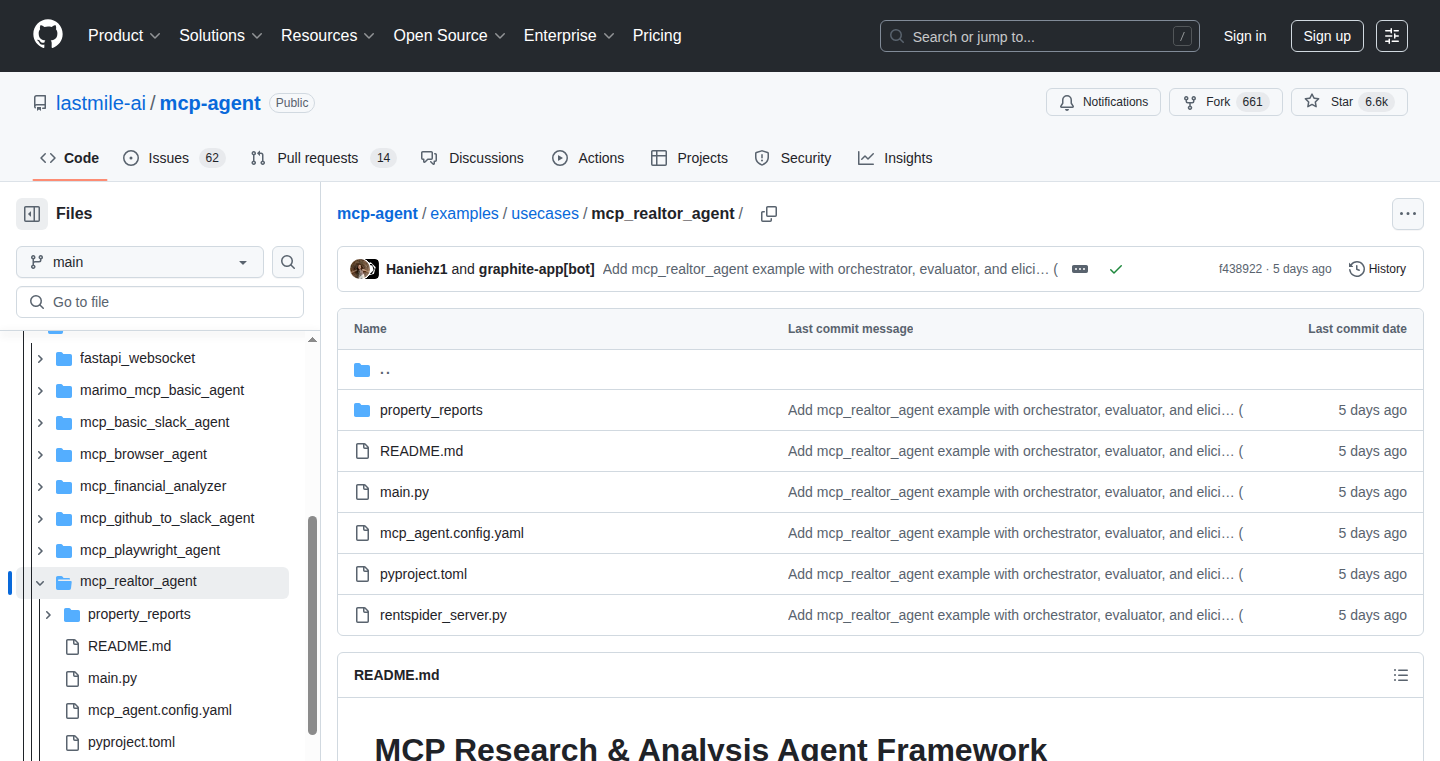
Author
haniehz
Description
This project is an AI agent framework designed to assist with complex decision-making, initially focused on investments and real estate analysis. It leverages a multi-agent system that gathers real-time data, remembers user preferences, and improves over time. The core innovation lies in its modular architecture and model-agnostic design, allowing it to work with various AI models (including local ones) and adapt to different data sources. It solves the problem of sifting through massive amounts of information and making informed decisions based on personalized criteria.
Popularity
Points 4
Comments 2
What is this product?
mcp-agent is a framework that sets up a team of AI helpers (agents) to tackle complicated tasks. Imagine having a smart assistant that continuously gathers market data, analyzes real estate trends, or even remembers your specific investment preferences. It doesn't rely on a single AI model but instead allows you to use different models like GPT-4 or even models running on your own computer. The project breaks down tasks into smaller, manageable parts, using different agents to handle different aspects of the problem, like choosing the right data source, analyzing the information, and making recommendations. The system is designed to learn and get better over time based on your feedback and the results it generates. So, you can get more accurate and tailored help for your decisions.
How to use it?
Developers can use mcp-agent by integrating it into their existing applications or building new tools around it. The framework provides an API, allowing developers to connect it to web applications (like Streamlit), command-line interfaces (CLI), or any platform that can send and receive data. To use it, a developer would define the task, specify the data sources, set up the agents, and then interact with the AI system to get results. For example, you could build a real estate tool that uses mcp-agent to analyze neighborhood data, compare properties, and assess risk factors. Developers can also customize the agents to fit specific needs or preferences.
Product Core Function
· Orchestrator: This component acts as the director, choosing the right agent to complete a specific task or using the correct tool for the job. Value: It streamlines complex processes by intelligently routing tasks to the appropriate agent, ensuring efficiency and accuracy. Application: In real estate analysis, the orchestrator might direct an agent to retrieve property data, then another to analyze school district information.
· EvaluatorOptimizer: This part of the system rates the quality of the results generated by the agents and refines them until they meet the required standards. Value: It ensures the accuracy and reliability of the information, improving the overall quality of decision-making. Application: If the investment agent provides a recommendation, the EvaluatorOptimizer will assess how well it aligns with your risk tolerance, fine-tuning the analysis for better results.
· Elicitation: This module adds a human touch when needed, allowing users to provide feedback or clarification when the AI needs it. Value: It helps the AI to learn and adapt to individual preferences and complex scenarios. Application: If the agent is unsure about a specific investment, Elicitation would prompt you for more information to refine the analysis.
· MCP server: This component exposes the entire framework through an API, making it easy to integrate with other applications and platforms. Value: This modularity and open access mean you can easily use the AI in different ways: building web apps, using it from the command line, or whatever your preference. Application: Allowing you to create a custom investment dashboard that pulls data from the agents and displays it in a user-friendly interface.
· Memory: This feature stores user preferences and outcomes, personalizing the AI's responses over time. Value: It improves the AI's understanding of your unique needs and expectations, leading to more tailored and relevant recommendations. Application: Remember your investment preferences or what neighborhoods you liked for real estate so that future analysis can be more aligned with your tastes.
Product Usage Case
· Real Estate Analysis: mcp-agent can be used to create a real estate application that compares neighborhoods based on factors such as schools, crime rates, and property values. It gathers real-time data from various sources and provides personalized insights. So, you can make a better-informed choice on where to live.
· Investment Portfolio Management: The AI agent can help you build a tool that tracks market data, generates daily reports based on your risk tolerance, and suggests investment opportunities. So, you can save time and make more money.
· Customized Data Analysis: Developers can leverage mcp-agent to build custom solutions that automatically gather, analyze, and visualize data tailored to specific needs. So, it will help with your own custom data work.
7
Context42: Gemini AI-Powered Code Style Guide Generator
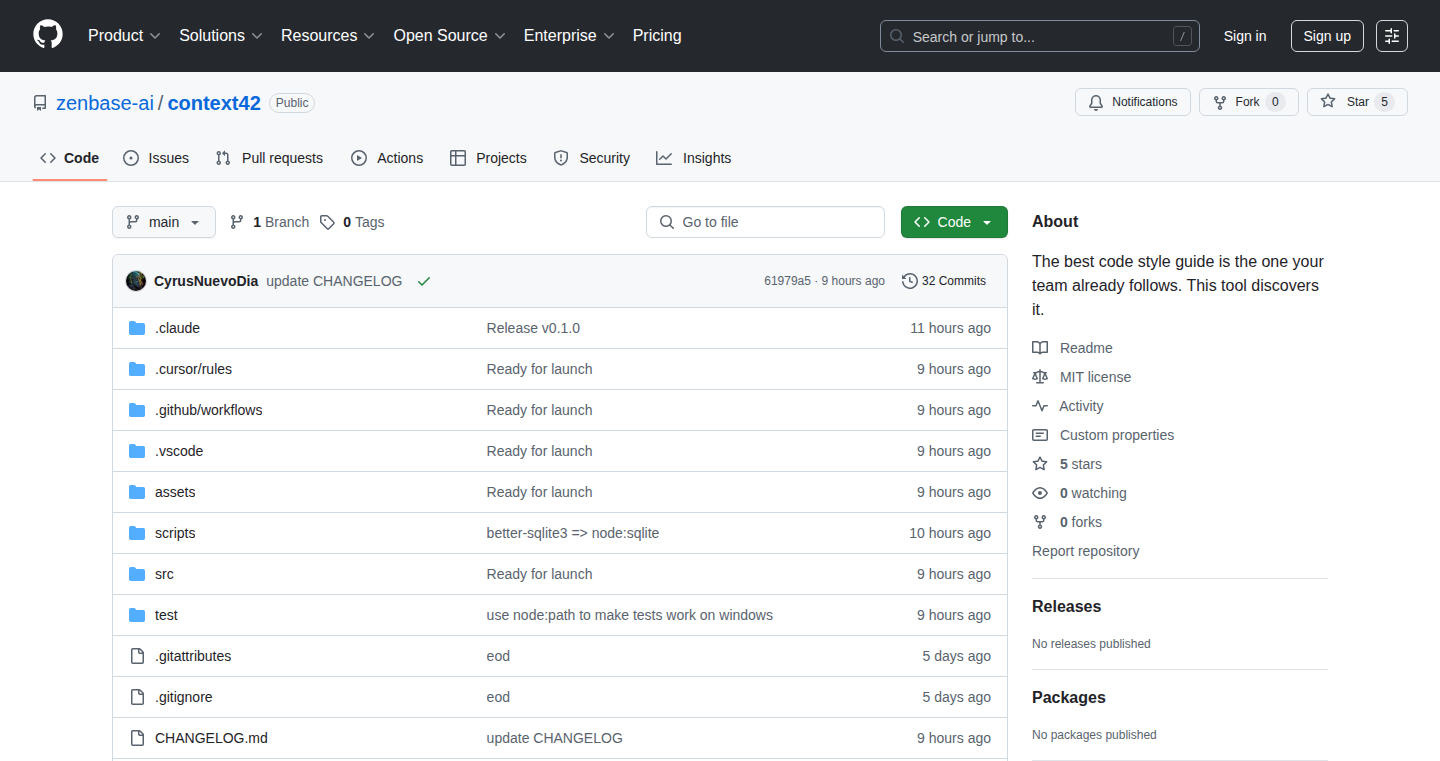
Author
knrz
Description
Context42 is a tool that uses Google's Gemini AI to automatically generate style guides for your codebase based on your existing code. It solves the problem of maintaining consistent coding styles across projects and teams. Instead of manually creating style guides or enforcing rigid rules, Context42 analyzes your actual code and generates documentation that reflects your current practices. This allows for easier onboarding of new developers and helps maintain consistency without unnecessary arguments about code style.
Popularity
Points 3
Comments 3
What is this product?
Context42 works by analyzing your code and using AI to understand your coding style. It doesn't just look at individual lines; it understands your project structure, the different programming languages you use, and how you organize your code. This allows it to generate style guides tailored to each language and project component. It uses techniques like language-aware analysis, dependency-smart processing, and a worker pool pattern to efficiently process large codebases and generate comprehensive documentation. So, this project is a smart assistant that helps developers automatically document their code styles, saving time and improving code consistency.
How to use it?
Developers can use Context42 by pointing it to their codebase. The tool then analyzes the code, leveraging Google's Gemini AI to understand the coding style and generate a detailed style guide. The generated guide can be integrated into the project's documentation or used as a reference for new developers. You can run Context42 in your terminal and it provides real-time progress. You can specify configurations such as the number of concurrent processes and file cleanup, so it’s capable to handle projects of all sizes. For example, you can integrate this tool in your CI/CD pipeline, to ensure your new code conforms to the standard, improving code quality and collaboration within your team.
Product Core Function
· Language-Aware Analysis: Context42 analyzes your code by programming language, generating specific style guides for each. This means your TypeScript code style is kept separate from your Python code style, ensuring accuracy and clarity. This provides a clear and organized view of your coding style.
· Dependency-Smart Processing: The tool analyzes your code in a smart order (child directories before parents), building a comprehensive understanding of your project’s structure. This allows it to identify patterns across your project's architecture, generating more accurate and insightful style guides. This feature guarantees style guides that accurately reflect your entire project.
· Built for Real Codebases: Context42 is designed to handle a variety of projects, big or small. It has configurable concurrency (the number of tasks it can do at once), a resume feature (so you can continue processing even if it's interrupted), and automatic cleanup. This means you can use it on large projects (like monorepos) without worrying about performance or data loss.
· Pragmatic over Prescriptive: Instead of imposing strict rules, Context42 documents your current coding style. This helps onboard new developers and maintain consistency without enforcing rules, so you focus on what you're already doing, not what you think you should be doing.
Product Usage Case
· A software development team uses Context42 to document its code style. When a new developer joins the team, they can use the generated style guide to quickly understand the team's coding conventions, reducing onboarding time and promoting consistent code across the project.
· A company with multiple projects and a large codebase uses Context42 to create and maintain consistent coding standards across all their projects. By analyzing existing codebases, the tool creates style guides that reflect the team's actual practices, simplifying collaboration and improving code readability across all projects.
· A developer working on a personal project uses Context42 to automatically generate a style guide. This allows them to easily track and remember their coding conventions as the project grows, and also simplifies the process of sharing the project with others by including easy-to-follow coding standards.
8
Libre: Anonymous Thought Amplifier
Author
rododecba
Description
Libre is a minimalist, anonymous text posting platform. It strips away all the usual social media baggage: no accounts, no likes, no followers, no comments. It's a simple text box where you can write and publish thoughts without any personal identifiers. The project is built using Firebase, emphasizing speed and ease of management. This addresses the growing fatigue with performative social media and provides a space for unfiltered expression.
Popularity
Points 5
Comments 0
What is this product?
Libre is essentially a digital 'bulletin board' for thoughts. It allows you to instantly share text-based content without creating an account or revealing your identity. The underlying technology leverages Firebase, a platform that handles data storage and real-time updates. This approach is innovative because it prioritizes user privacy and simplicity, contrasting sharply with complex social media architectures. So this offers a safe and straightforward way to share your thoughts without the pressure of self-promotion or the need for external validation.
How to use it?
Developers can use Libre as a model for building similar applications focused on anonymity or creating quick and simple publishing tools. They can study its implementation using Firebase to understand how to build a scalable and easy-to-manage application. The Firebase backend handles data storage, and real-time updates. So this could be used as a starting point for prototyping a new communication tool, or a privacy-focused platform.
Product Core Function
· Anonymous Text Posting: Users can instantly publish text without requiring an account or any personal information. This allows for candid expression without fear of judgment or exposure. This can be useful for brainstorming sessions, gathering feedback on ideas, or simply sharing thoughts without any strings attached.
· Firebase-powered Backend: The use of Firebase simplifies the development process by handling data storage and real-time updates, reducing the need for complex backend infrastructure. This accelerates development and deployment, making it easier to get an application up and running quickly. For developers, this means faster prototyping and easier scaling without managing servers.
· Minimalist Interface: The platform focuses solely on the text box and publishing functionality, eliminating distractions and simplifying the user experience. This focus helps ensure users can focus on their message. This is perfect for quick notes, sharing ideas, or collaborating in a low-key environment.
Product Usage Case
· Prototype Anonymous Feedback Tool: Developers can leverage Libre’s core design to create a quick feedback collection tool for testing or prototyping. Using the same technical framework, developers can quickly integrate a mechanism where users anonymously submit their thoughts, creating a more honest feedback loop without the inherent pressure.
· Simple Note-Taking Application: Developers can use Libre as inspiration to build a quick, privacy-focused note-taking app where users can quickly capture thoughts without worrying about account setup or public visibility. This is suitable for a quick brainstorming session.
· Real-Time Content Sharing Platform: Developers can build a minimal social media platform with a focus on anonymity and simplicity. The underlying architecture can be used to facilitate real-time, anonymous content creation. The core technology is useful in building applications where privacy and speed of information are very important, like quick polling or rapid-fire collaborative work.
9
TypeSpider: The Typing Web Weaver

Author
frydcircuit
Description
TypeSpider is a web-based typing practice tool designed to improve typing speed and accuracy. It strips away the unnecessary features found in many typing tutors, focusing on a clean and distraction-free environment. Built with Vue.js and Tailwind CSS, it's lightweight and responsive, working seamlessly on both desktop and mobile. A standout feature is its on-screen keyboard that highlights keys as you type, making it easier for beginners and aiding in muscle memory development. This project exemplifies a simple yet effective approach to solving a common problem: improving typing skills. So this is a great resource if you want to improve your typing speed and accuracy without being bogged down by unnecessary features.
Popularity
Points 5
Comments 0
What is this product?
TypeSpider is a web application built using modern web technologies (Vue.js for the user interface and Tailwind CSS for styling). Its main innovation is the focus on simplicity and efficiency. It provides a clean interface for practicing typing, offering real-time feedback through a highlighted on-screen keyboard. It tracks typing speed (words per minute) and accuracy. This provides a streamlined experience for users looking to improve their typing skills. So it’s a modern, easy-to-use tool that makes learning to type or improving your typing fun and efficient.
How to use it?
Developers can use TypeSpider directly by visiting its website. While not a library for integration, the project itself serves as a great example of a simple, well-structured Vue.js application. Developers can learn from the project's code (available on the web) how to build responsive and user-friendly web interfaces. It can also inspire developers to create their own learning tools or web applications. So, while you can't directly integrate the tool, you can definitely use it to learn from.
Product Core Function
· Real-time key highlighting: The on-screen keyboard highlights the keys as you type. This aids beginners in learning the keyboard layout and helps build muscle memory by associating visual cues with the physical action of typing. Useful for anyone who needs to quickly memorize the keyboard.
· Words per minute (WPM) and accuracy tracking: TypeSpider monitors your typing speed and accuracy, providing immediate feedback on your progress. This allows users to track their improvement over time and identify areas where they need more practice. Good for users who want to objectively track their typing skills.
· Mobile-friendly design: The application is designed to work smoothly on both desktop and mobile devices. This ensures that users can practice typing anytime, anywhere, providing flexibility in their learning. So you can improve your typing even when you don't have access to a desktop computer.
Product Usage Case
· Educational Setting: Teachers can use TypeSpider to introduce students to touch typing. The visual feedback from the highlighted keyboard makes learning easier, particularly for visual learners. Helps students learn to type without looking at the keyboard.
· Personal Improvement: Anyone wanting to improve their typing speed and accuracy can use TypeSpider. The clean interface and progress tracking make it a great tool for self-improvement. If you want to learn how to type faster and become a better typist, TypeSpider is for you.
· Web Development Learning: Developers can study the Vue.js and Tailwind CSS code to learn from a simple, functional project. It demonstrates best practices for creating responsive web applications. If you are a beginner developer, it is a great resource to improve your skill with clean coding practices.
10
Klartraum: Neural Rendering Inference Engine

Author
fortmeier
Description
Klartraum is a project focused on building a high-performance neural rendering engine, designed to run on embedded devices and VR headsets. The core innovation lies in leveraging Vulkan, a low-level graphics API, for compute-intensive tasks, specifically Gaussian splatting, to achieve real-time rendering. The project aims to create a fast and efficient system for rendering complex 3D scenes, without the need for extensive training or backpropagation. The key technical challenge addressed is the efficiency of running neural network inference on resource-constrained devices, providing a path toward immersive experiences. This project is still early stage but shows interesting potential. So what's this for? If you want to create stunning visuals in VR or on mobile devices without needing huge processing power, this could be the future.
Popularity
Points 4
Comments 0
What is this product?
Klartraum is essentially a tool for rendering 3D scenes using neural networks. It uses a technique called Gaussian splatting, which is a way of representing 3D objects using a collection of Gaussian distributions. Instead of relying on traditional methods like triangle meshes, this approach uses a neural network to process the data and generate the final image. The core innovation is using Vulkan, a powerful graphics API, to perform this computation efficiently, especially on devices with limited resources like VR headsets or embedded systems. So what's the big deal? It allows for very detailed and complex scenes to be rendered in real-time on devices that wouldn't normally be able to handle it. It reduces the performance barrier for high-fidelity virtual experiences.
How to use it?
Developers can potentially use Klartraum as an inference engine to integrate advanced 3D rendering techniques into their projects. They could use it to render detailed virtual environments, create interactive 3D models, or improve the visual quality of their VR/AR applications. The integration process would involve using Klartraum's Vulkan-based kernels to process the neural network data and generate the final images. In the future, this might involve some kind of API. So how can you use this? Think of creating incredibly detailed VR experiences or realistic 3D models that run smoothly even on your phone.
Product Core Function
· Gaussian Splatting Renderer: This is the core technology, responsible for representing 3D objects and scenes. Its technical value is the ability to render complex scenes from a set of gaussian primitives, and the application scene is creating detailed 3D models or virtual environments. So what can this do? It provides a way to render detailed 3D scenes efficiently.
· Vulkan-based Compute Kernels: These are the pieces of code that run on the graphics card (GPU) to perform the heavy lifting of rendering. Their technical value is in offering the efficiency and performance of modern GPUs. The applications is real-time rendering on resource-constrained devices. So, what does this mean for me? It leads to fast and smooth rendering on your phone or VR headset.
· Neural Network Inference: The engine uses neural networks to process and render the 3D data, which represents the innovation. Its value in providing a technique for efficient high-fidelity rendering. The application: It will enable complex rendering without heavy processing requirement in VR/AR or embedded systems. So, it means rendering complex scenes without needing a supercomputer.
Product Usage Case
· VR Applications: Imagine building incredibly realistic VR experiences where users can freely move around detailed environments. Klartraum could enable this by rendering complex scenes in real-time on VR headsets. So, this means stunning VR without the expensive equipment.
· Mobile Augmented Reality (AR): Developers could use Klartraum to create AR applications with high-quality 3D models that are seamlessly integrated into the real world. So, this enables photorealistic objects on your phone.
· Embedded Systems Visualization: Think of being able to visualize 3D models or environments on low-power embedded devices, like those used in robotics or industrial applications. So, this means sophisticated visualizations on devices with limited resources.
11
NativeSwap: Decentralized Cross-Chain Asset Swapping
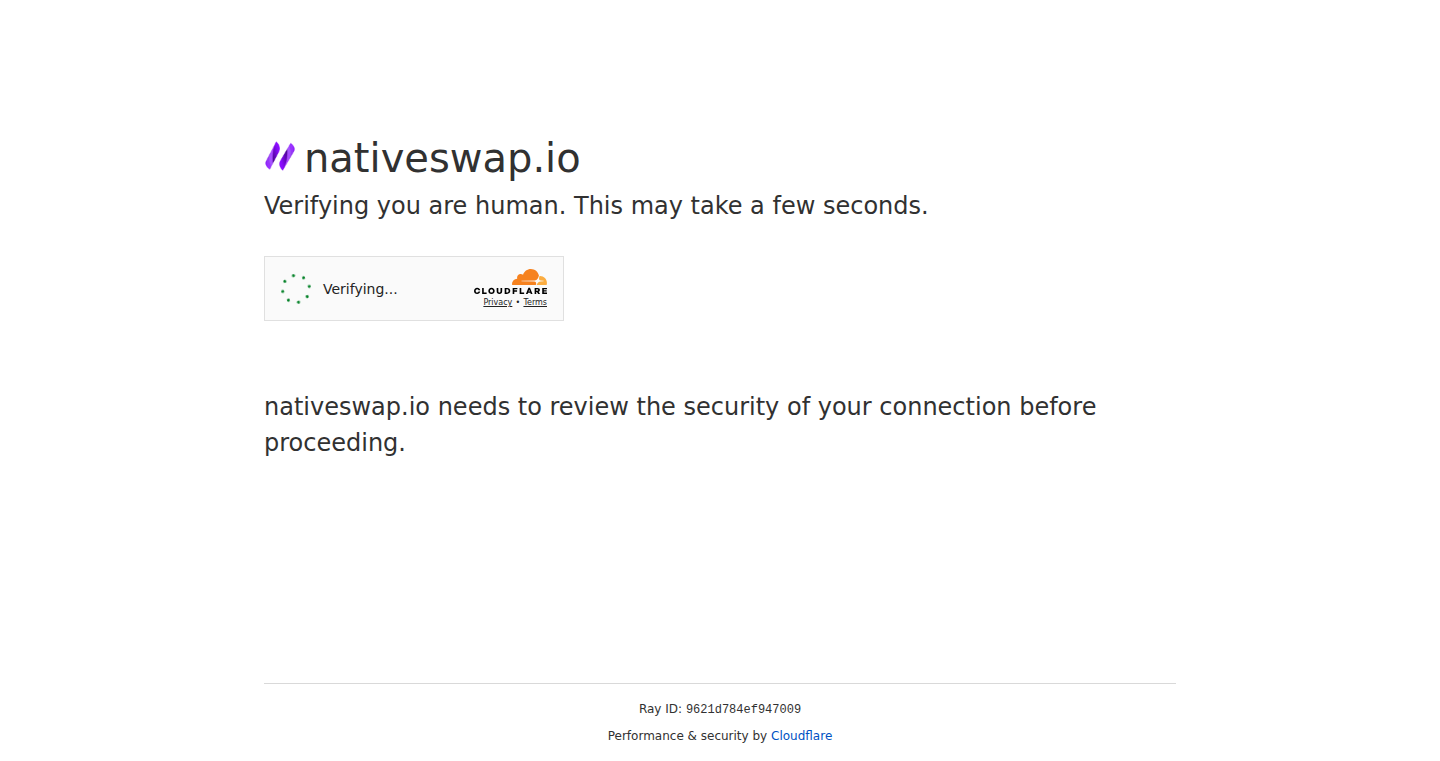
Author
nativeswap
Description
NativeSwap is a platform that allows users to directly swap cryptocurrencies (like Bitcoin and Dogecoin) across different blockchains without using intermediary 'wrapped' tokens or centralized services. It aims to make these swaps cheaper, easier, and safer by leveraging the liquidity of other protocols like ThorChain and Maya Protocol. This addresses the common issues of high fees and security risks associated with traditional cross-chain solutions.
Popularity
Points 3
Comments 1
What is this product?
NativeSwap is a decentralized exchange (DEX) for swapping cryptocurrencies across different blockchains. Instead of relying on 'wrapped' versions of coins or trusting a central entity to manage the exchange, it enables direct swaps of native assets. Think of it like exchanging real dollars for Euros directly, without going through a bank (in this case, a centralized bridge). It taps into other protocols to find the necessary liquidity to perform these swaps. So what? This means more direct, potentially cheaper, and more secure ways to trade your crypto.
How to use it?
Developers can use NativeSwap by integrating it into their applications, wallets, or other financial tools. This could be done through an API or direct integration. Imagine a wallet app allowing users to swap Bitcoin for Dogecoin directly within the wallet interface. Developers will focus on the user experience of cross-chain swaps, abstracting away the complexities of the underlying protocol interactions. So what? It simplifies building cross-chain features in your application, offering users a seamless swapping experience, and opens doors to cross-chain financial services.
Product Core Function
· Direct Native Asset Swapping: Allows swapping cryptocurrencies like Bitcoin, Ethereum, and Dogecoin without using wrapped tokens or centralized bridges. So what? This reduces the risks of using intermediary assets that can be vulnerable to hacks or scams and increases the security of your trades.
· Cross-Chain Liquidity Aggregation: Leverages liquidity from protocols like ThorChain and Maya Protocol to facilitate swaps. So what? This provides access to sufficient liquidity to handle swaps, ensuring trades can be executed efficiently.
· Non-Custodial Swaps: Ensures users retain control of their assets during the swap process. So what? This enhances security by eliminating the need to trust a third party with your funds, mitigating the risk of theft or loss.
· Support for Multiple Blockchains: Supports a wide range of blockchains, including Bitcoin, Ethereum, BNB Smart Chain, and Dogecoin, with more planned. So what? Offers versatility and enables a broader range of cross-chain trading options, expanding the cryptocurrencies that users can trade.
· Streaming Swaps: Supports both regular and streaming swaps. So what? This allows for more flexible and potentially more efficient swap strategies, catering to various user needs, such as automatically rebalancing portfolios or converting assets over time.
Product Usage Case
· Wallet Integration: A cryptocurrency wallet developer integrates NativeSwap to allow users to swap cryptocurrencies directly within their wallet interface, improving user experience. So what? Provides a seamless and user-friendly way to trade different cryptocurrencies within a familiar platform, increasing user retention and satisfaction.
· Decentralized Finance (DeFi) Application: A DeFi protocol integrates NativeSwap to enable users to easily swap assets and participate in cross-chain yield farming or liquidity provision. So what? Creates new opportunities for users to generate returns by accessing a wider range of assets and investment strategies.
· Cross-Chain Payment Systems: A payment system developer uses NativeSwap to enable merchants to accept payments in various cryptocurrencies, regardless of the blockchain used by the customer. So what? Expands payment options, simplifies payment processing, and increases accessibility for both merchants and customers.
· Portfolio Rebalancing Tools: A developer builds a tool that automatically rebalances a user's crypto portfolio across different blockchains using NativeSwap. So what? Provides automated and efficient portfolio management, minimizing manual effort and transaction fees.
12
Beelzebub: LLM-Powered Deception Framework
Author
mariocandela
Description
Beelzebub is an open-source honeypot framework that leverages Large Language Models (LLMs) to create highly realistic and interactive deception environments. Instead of simply mimicking a system, it uses LLMs to generate plausible responses to attacker commands, effectively creating a convincing illusion. This allows security researchers to gather real-world threat intelligence by keeping attackers engaged and diverting them from real systems.
Popularity
Points 4
Comments 0
What is this product?
Beelzebub is a security tool designed to attract and study cyber attackers. It works by setting up a fake system (a 'honeypot') that looks and behaves like a real one. What makes it innovative is its use of LLMs. When an attacker interacts with the honeypot, the LLM generates realistic responses, making the deception much more convincing than traditional honeypots. This allows the framework to collect valuable information about attacker tactics and techniques without exposing actual systems. So, what's in it for you? If you're a security professional, you gain a powerful tool to understand and defend against threats. If you're interested in AI and security, you get to explore how LLMs can be used for creative problem-solving.
How to use it?
Developers can deploy Beelzebub by installing the framework and configuring the LLM interactions. They can then integrate it into their security infrastructure, monitoring the interaction data for insights into attacker behavior. You might use it by setting up an SSH honeypot that looks like a Linux server. When an attacker tries to log in, the LLM generates realistic command responses. Or, you could set up a web server honeypot and have the LLM craft convincing error messages. The framework provides a way to collect detailed data about attacker behavior, offering valuable insights that can improve overall security. So, how can you use it? By deploying it on your network as a decoy, and monitoring the collected data.
Product Core Function
· LLM-Driven Interaction: The core functionality is the use of LLMs to generate dynamic and realistic responses to attacker actions within the honeypot. This goes beyond simple pre-programmed responses, creating a more engaging and convincing deception. This is useful because it allows the honeypot to adapt to different attacker behaviors and gather more detailed information. So, this provides a more effective way to trick attackers and gather more intelligence about how they operate.
· Realistic System Mimicry: The framework mimics entire operating systems, creating an environment that closely resembles a real system. The LLMs are used to simulate plausible behavior and system responses. This is valuable because it makes the honeypot more believable, increasing the likelihood that attackers will spend time interacting with it and revealing their methods. So, this is important for creating a more effective trap that yields useful intelligence.
· Data Collection and Analysis: Beelzebub collects data on attacker activity, including commands executed, files accessed, and other interactions. This data can be used to analyze attacker tactics, techniques, and procedures (TTPs). This is beneficial because it provides actionable insights for improving security posture and defending against real-world threats. So, this is crucial for understanding the attackers' behavior and improving your security.
· Open-Source and Extensible: The project is open-source, allowing security researchers and developers to examine the code, customize the framework, and contribute new features. This collaborative approach fosters innovation and allows for the development of more sophisticated honeypot capabilities. This is helpful because it allows other people to contribute to the project, and it also fosters innovation. So, this allows you to build a better defense and potentially uncover new threats.
Product Usage Case
· SSH Honeypot: Deploying an SSH honeypot that uses LLMs to simulate a Linux server, responding to commands like 'ls' or 'cat' with realistic output. This helps to capture attackers' initial reconnaissance steps. For instance, a developer can learn what tools attackers use to probe systems and how they move around a network. So, you can use it to identify vulnerabilities in your system before they are exploited.
· Web Server Honeypot: Creating a web server honeypot with LLMs to generate realistic error messages and responses to attacker attempts to exploit vulnerabilities. This will show how the attackers attempt to penetrate the server and how they try to escalate privileges. So, it can help identify vulnerabilities in your web applications and improve overall security.
· Threat Intelligence Gathering: Setting up Beelzebub to study and gather information on attackers. Analyzing their actions, identifying new TTPs, and using the data to improve your security posture. This can be used to update security rules, which prevent new threats from happening. So, it helps improve your defenses by offering insights into threats.
13
KarmaWall: Daily Habit Tracker with Public Accountability

Author
SiddharthBasava
Description
KarmaWall is a minimalist web app designed to help users build daily consistency through public accountability. It allows users to post one productive thing they did each day, creating a public wall of small wins. The project is built with Next.js for the frontend, PostgreSQL for the database, and uses OTP (One-Time Password) for authentication. This project focuses on providing a simple, yet effective, solution for habit tracking by leveraging the power of public sharing and the creator's personal experience with habit formation.
Popularity
Points 4
Comments 0
What is this product?
KarmaWall is a web application that encourages users to establish and maintain productive habits by posting a single accomplishment each day. It’s built on Next.js, which allows for fast and efficient web page loading. The data is stored in a PostgreSQL database, ensuring that the information is safely preserved. The project also uses OTP authentication for secure user logins. The innovation lies in its simplicity and the use of public accountability as a motivational factor. So what does this do? It uses the power of showing off your wins to help you build better habits. For you, this translates to better habits and more personal wins!
How to use it?
Users can easily access KarmaWall through a web browser. Once logged in with OTP, they can post their daily accomplishment, contributing to their personal streak and the public wall. This web app can be used by anyone who wants to track their progress and build consistency in their lives. You can use this to help focus on your goals and share those goals with your friends. So, for you, you're building better habits and holding yourself more accountable!
Product Core Function
· Daily Accomplishment Posting: Allows users to post one productive thing they did each day. This encourages consistent reflection on achievements and reinforces positive habits. So what is this? Encouraging you to focus on your wins every day! For you, this is about forming the daily habit of acknowledging your accomplishments.
· Public Wall: Displays all user posts in a public feed, fostering a sense of community and accountability. So what is this? This gives you some public pressure to keep going. For you, this builds momentum and accountability.
· OTP Authentication: Provides a secure and user-friendly login experience. So what is this? This keeps your wins private! For you, this means peace of mind knowing your account is protected.
· Mobile and Desktop Ready: The application is designed to work well on both desktop and mobile devices, ensuring accessibility across different platforms. So what is this? This means you can keep track of your progress anywhere! For you, this means you can use it wherever you want.
Product Usage Case
· Personal Habit Tracking: A user could use KarmaWall to track their daily exercise routine by posting about their workout each day. This helps them stay consistent and motivated. For you, this is about showing your friends how great you're doing!
· Project Management: A project manager can use KarmaWall to share daily progress updates, keeping the team informed and building a sense of shared accomplishment. For you, this can keep your team focused!
· Learning and Skill Development: A student can use KarmaWall to share their study progress or new skills learned each day, fostering a routine and tracking their learning. For you, this allows you to focus on what you're learning every day, helping you form the habit of learning!
14
Pxxl App: Instant Web App & Database Deployment
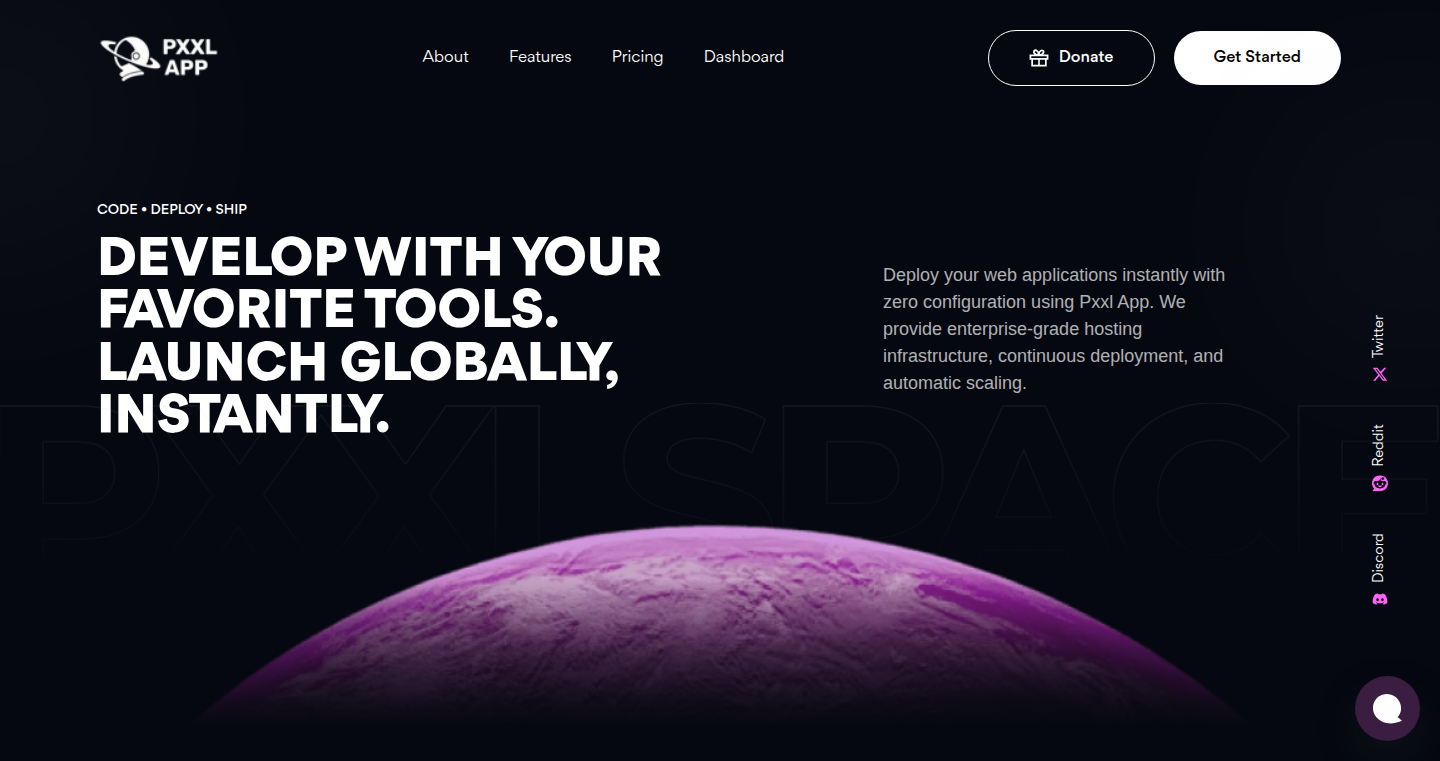
url
Author
robinsui
Description
Pxxl App simplifies deploying web applications and databases. It lets developers deploy websites, APIs, and full-stack apps quickly by linking their Git repository. It supports over 20 frameworks and languages, and provides database management (MongoDB, PostgreSQL, MySQL) directly from a dashboard. It offers features like automatic scaling, global CDN, and zero-downtime updates without manual server configuration. The goal is to eliminate the tedious setup and DevOps work often associated with personal projects, SaaS applications, and client projects.
Popularity
Points 1
Comments 2
What is this product?
Pxxl is a platform-as-a-service (PaaS) solution that automates the complex process of deploying and managing web applications and databases. It uses technologies like containerization (think pre-packaged software environments) and orchestration (managing these containers) to provide instant deployments. When you connect your code repository, Pxxl automatically handles tasks like building your application, setting up servers, and managing traffic. The core innovation lies in its ease of use, reducing the barrier to entry for developers to get their projects online quickly. So this is helpful because you can launch your project faster and focus on code, not infrastructure.
How to use it?
Developers use Pxxl by connecting their Git repository (like GitHub or GitLab). Pxxl then automatically detects the project's framework or language (e.g., Next.js, React, Node.js) and builds the application. You can then manage the deployment and connect to databases (MongoDB, PostgreSQL, MySQL) through a dashboard. This means you can skip the complex server setup and configuration and deploy with a few clicks. So this is helpful because you don't need to be a DevOps expert to get your website live.
Product Core Function
· Instant Deployment: Pxxl allows developers to deploy websites and web applications immediately after connecting their Git repository, saving time and reducing complexity. This eliminates the need for manual server configuration, resulting in faster deployment times and more rapid iterations.
· Multi-Framework and Language Support: Pxxl supports a wide range of programming frameworks and languages including popular ones such as Next.js, React, Node.js, PHP, and Python, enabling a broader range of developers to quickly deploy their projects and avoid the need for custom configurations or workarounds.
· Database Management: Pxxl provides a dashboard for managing databases like MongoDB, PostgreSQL, and MySQL, simplifying the database setup, configuration, and maintenance process. This allows developers to focus more on application development and less on managing infrastructure.
· Automatic Scaling and Global CDN: Pxxl provides automatic scaling to handle increased website traffic and a global Content Delivery Network (CDN) for faster content delivery to users around the world. So this means you website will be faster and can handle lots of visitors without you doing anything.
· Zero-Downtime Updates: Pxxl enables zero-downtime updates, which allows developers to update their web applications without interrupting service. This minimizes disruption and ensures a positive user experience during deployment, making website maintenance smoother.
Product Usage Case
· Personal Portfolio Websites: Developers can create a showcase page using Pxxl to display their projects and social media links. It reduces the complexity involved in hosting and managing a portfolio website. This helps showcase your skills and attract potential clients or employers, enhancing your online presence.
· SaaS Applications: Software as a Service (SaaS) developers can deploy their applications using Pxxl to benefit from instant deployment, scaling, and database management features. This makes it easier to launch a software product, focusing on its core functionality and user experience, rather than on infrastructure setup.
· Client Projects: Web developers who build websites for clients can utilize Pxxl to quickly deploy and manage client projects, streamlining the process and saving time. This helps reduce the time needed to bring client projects live, improving the efficiency and profitability of a development business.
15
TinyTransformers: Single-File Transformer Implementation
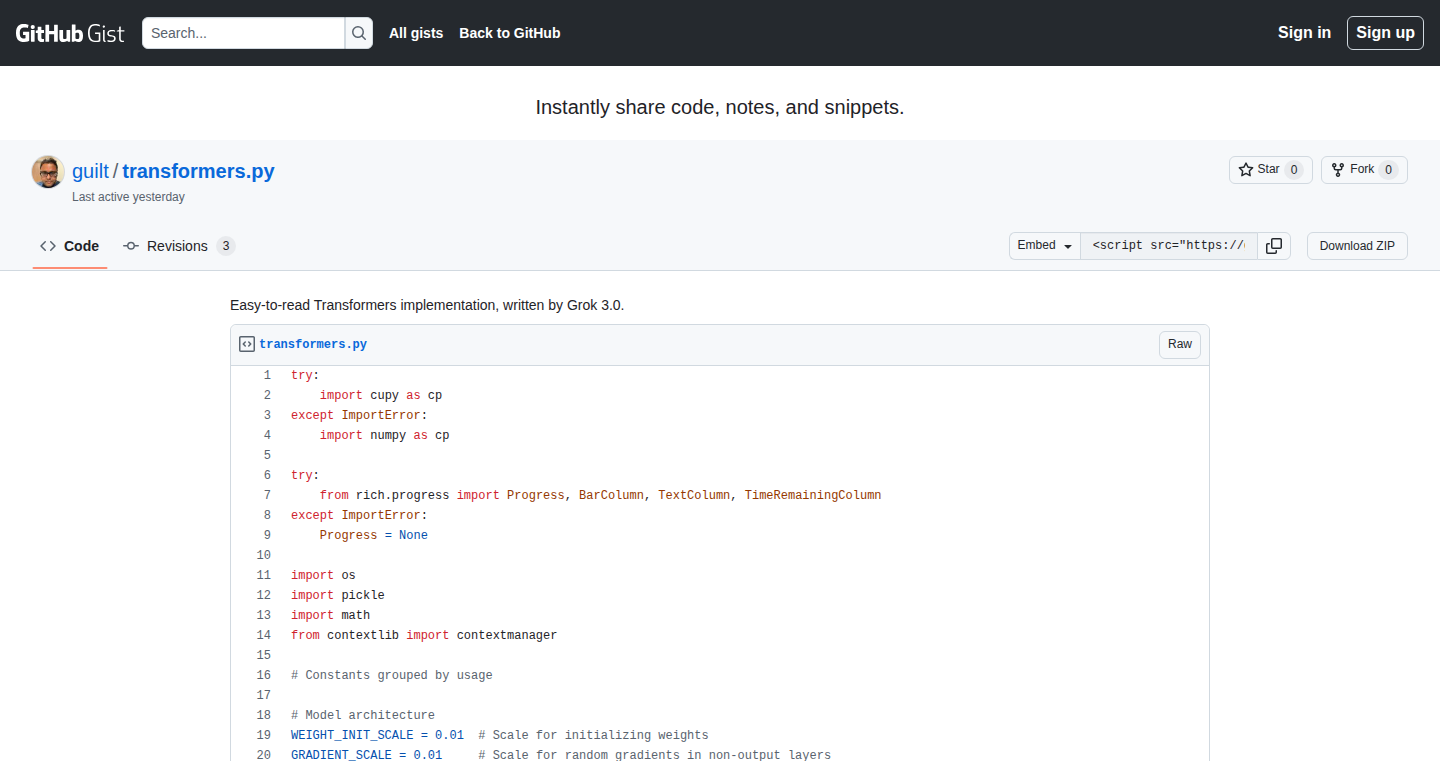
Author
vkaku
Description
A single-file implementation of the transformer architecture, a groundbreaking model behind technologies like GPT and other large language models. This project allows developers to understand and experiment with transformers in a simplified, self-contained manner. The focus is on making the core components of transformer models accessible and easy to modify. The project addresses the need for a more transparent and customizable way to explore and learn about transformer models, removing the complexities often associated with large-scale, production-ready implementations.
Popularity
Points 2
Comments 1
What is this product?
This project is a self-contained implementation of the transformer architecture, meaning all the code needed to run a basic transformer model is contained in a single file. The key innovation here is the simplification and accessibility of a complex model, making it easier for developers to understand the underlying principles and experiment with different configurations. It allows you to see exactly how these models work without wading through a lot of extra code. This is particularly useful for understanding how models like GPT process information. So what? It helps you truly grasp how cutting-edge AI technologies function.
How to use it?
Developers can use this single-file implementation as a learning tool, a starting point for their own projects, or a playground for experimenting with different transformer components. You can integrate it into your own projects by importing the single file or adapting the code as needed. It's a fantastic way to dive into natural language processing (NLP) or other machine learning tasks. So what? You can build your own custom NLP models without being intimidated by large frameworks.
Product Core Function
· Attention Mechanism: Implements the core attention mechanism of transformers, allowing the model to focus on different parts of the input sequence. This is the secret sauce for understanding context. So what? You can understand how a model decides what information is important.
· Encoder and Decoder Layers: Provides the building blocks for the transformer architecture, including the encoder and decoder layers. These layers are crucial for processing and generating sequential data. So what? You can build systems that translate languages or generate text.
· Simplified Training Loop: Includes a basic training loop to train the transformer model on a given dataset. It is a good introduction to the concept. So what? You can easily train the model on your own data to do specific tasks.
Product Usage Case
· Educational Tool: Use the single-file implementation in a classroom or workshop to teach the fundamental concepts of transformers. So what? Students can easily learn about this advanced technology.
· Customization and Experimentation: Modify the architecture, parameters, and training process to explore different configurations and optimize the model for a specific task. So what? You can create models tailored to your unique needs.
· Rapid Prototyping: Use it as a starting point for prototyping NLP applications, such as text summarization or sentiment analysis. So what? You can quickly test out your ideas and build innovative solutions.
16
EmojiFavicon: Browser-Based Favicon Generator
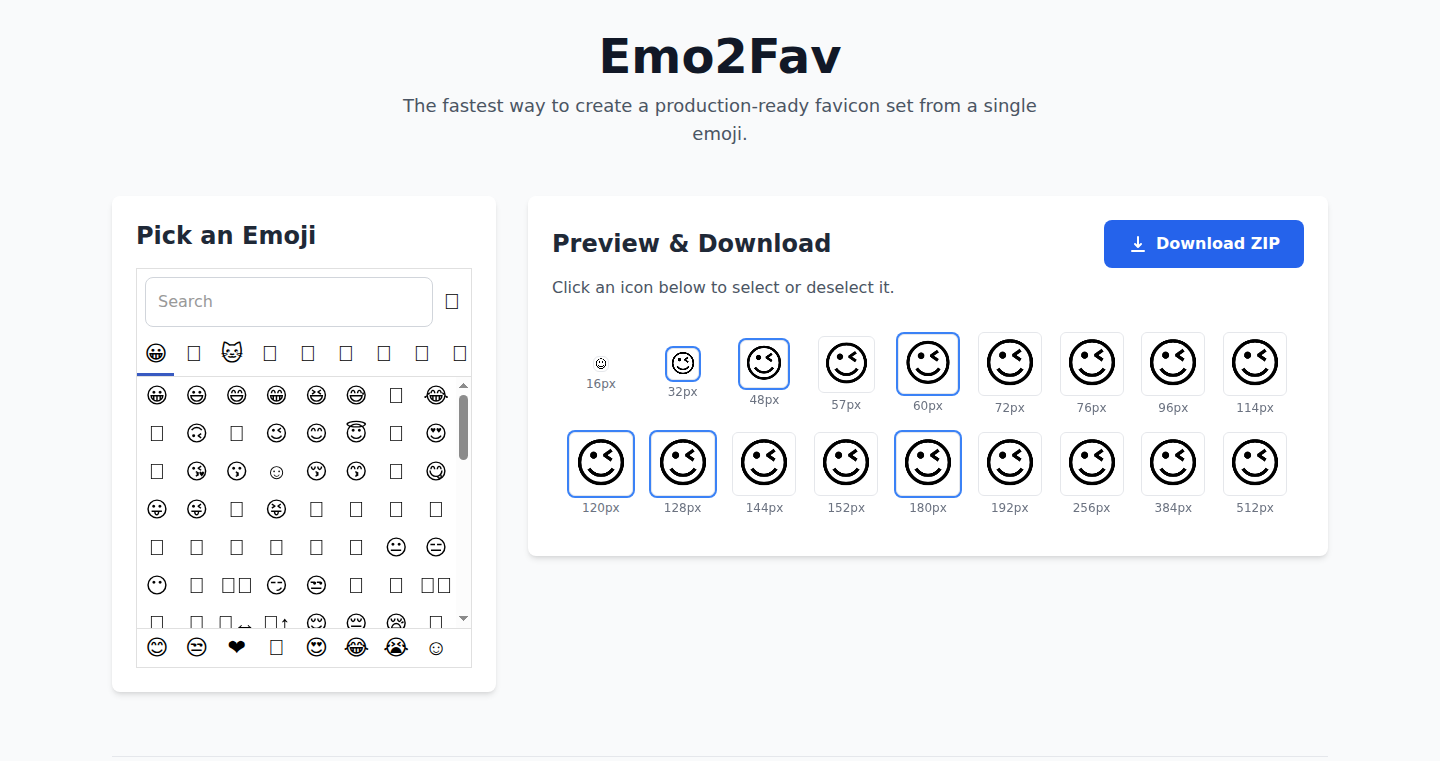
Author
sardor_ubaydiy
Description
EmojiFavicon is a web application that lets you create favicons (the small icons that appear in your browser tab) directly from emojis. It solves the common problem of needing a quick and easy way to generate favicons without relying on complex image editing software. The innovation lies in its simplicity and accessibility, allowing anyone to create visually appealing favicons with just a few clicks, using the universally understood language of emojis. So what's the value? It provides a quick and easy method for website owners and developers to create unique, eye-catching favicons, improving the user experience and brand identity.
Popularity
Points 1
Comments 2
What is this product?
EmojiFavicon uses the power of the browser and the readily available Unicode emoji set to generate favicons. The core technology involves rendering the selected emoji onto a canvas element (a drawing surface within a webpage). Then, the canvas content is converted into the necessary formats for a favicon (typically .ico or .png) and made available for download. This streamlines the process, eliminating the need to manually design, resize, and convert images. So, basically, it's a simplified, code-based image editor tailored for favicons.
How to use it?
Developers can use EmojiFavicon by simply visiting the website, selecting an emoji from the provided list, and downloading the generated favicon file. They can then integrate this file into their website's HTML by adding a link tag in the <head> section of their HTML code. This approach is particularly valuable for quick prototyping, personal projects, or any scenario where a unique and easily created favicon is desired. In short, just go to the website, select your emoji, download, and paste a line of code into your website's header.
Product Core Function
· Emoji Selection and Rendering: The core function is the selection of an emoji and its rendering onto a canvas element. This utilizes the browser's ability to display Unicode characters (emojis) and its drawing capabilities. Value: Allows users to visually choose their favicon, making it intuitive and creative. Application: Quickly create a visual representation of a website, making it more easily recognizable.
· Image Conversion and Download: The selected emoji rendered on the canvas is then converted into a favicon image format (like .ico or .png) which is offered for download. Value: Provides the user with a ready-to-use image file, making it easy to implement the favicon. Application: Simplifies the process of generating the favicon, avoiding any image editing complexities and technical overhead.
· Cross-Browser Compatibility and Optimization: The application implicitly ensures that the generated favicon works correctly across different browsers and devices, and is optimized in size and format. Value: Guarantees the favicon displays correctly. Application: Ensures your website's branding is consistent across all platforms.
· User-Friendly Interface: Provides a simple and intuitive interface with an emoji picker. Value: Makes it accessible even for non-technical users. Application: Easily create and customize favicons without any technical skills.
Product Usage Case
· Personal Blogs: A blogger wants to create a distinctive favicon to improve their blog's branding. By using EmojiFavicon, they can quickly choose an emoji that represents their blog's content and generate a favicon in minutes, without the need for specialized design skills. So it helps in creating visual identity.
· Prototyping Websites: A developer wants to quickly test a website's design with a custom favicon. Using EmojiFavicon, they can rapidly generate and implement an emoji-based favicon during the prototyping phase, focusing on the functionality and layout before committing to a permanent favicon. It saves time and effort.
· Simple Web Applications: A web developer building a small web application needs a unique favicon. EmojiFavicon allows them to easily generate a visually appealing favicon that complements the app's branding, even without any prior graphic design expertise. It promotes visual appeal.
· Educational Projects: Students learning web development can use EmojiFavicon to quickly create favicons for their projects, making the process more accessible and engaging. It is a simple way to create visuals.
17
DOMTranslator: Effortless DOM Text Node Translation
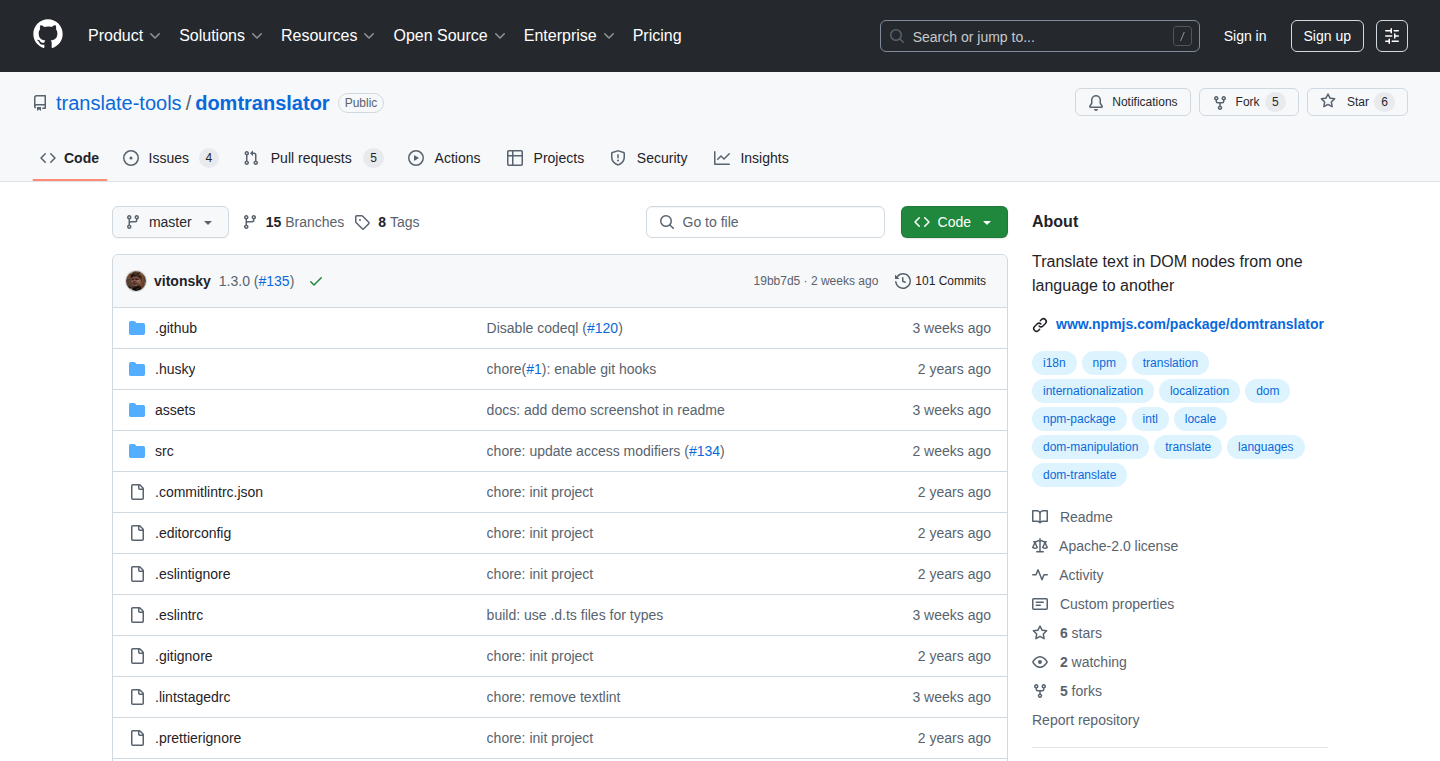
Author
vitonsky
Description
DOMTranslator is a JavaScript package designed to simplify the process of translating text nodes within a Document Object Model (DOM). It elegantly addresses the common problem of dynamically translating website content without requiring complex manual modifications. The core innovation lies in its ability to automatically identify and translate text nodes, making multilingual website support easier and more efficient. It leverages advanced DOM manipulation techniques and potentially integrates with translation APIs, abstracting away the intricacies of language processing and localization. So, it allows you to quickly make your website available in different languages.
Popularity
Points 3
Comments 0
What is this product?
DOMTranslator is like a smart translator specifically for the text on your website. It automatically finds all the text elements on your webpage (the DOM) and translates them into your desired language. It works behind the scenes, using the power of programming to make your website multilingual without you having to manually translate everything. This is a simple yet powerful way to solve the complex problem of website localization. It uses techniques like DOM traversal (going through the structure of your webpage) and potentially connects to translation services like Google Translate to do the actual translation. So, you can easily reach a global audience.
How to use it?
Developers can use DOMTranslator by simply including the package in their JavaScript code and calling its translation functions, usually specifying the target language. You would typically target the DOM elements to translate and call the function to translate the targeted elements. It integrates easily with existing web development workflows and frameworks, such as React, Vue, or Angular. The package offers a simple API for specifying translation sources (like a dictionary or API) and selecting the appropriate language. So, it's quick to install and ready to go, saving you lots of manual work.
Product Core Function
· Automated Text Node Detection: This feature automatically identifies all text nodes within a DOM, eliminating the need for manual selection. This is valuable because it accelerates the translation process and reduces the chances of missing any text content. Application scenario: translating large web pages or applications with dynamic content.
· Language Selection & Integration: DOMTranslator enables easy configuration to specify the target language for translation. Application scenario: creating a multilingual website.
· Translation API Integration: The package likely integrates with popular translation APIs (e.g., Google Translate, DeepL), streamlining the translation workflow. This feature provides real-time translation capabilities. Application scenario: providing instant translation of content for users.
· DOM Manipulation: the package updates DOM to the new language by overwriting or updating it. This means it allows to make the changes directly on the website displayed to the user. Application scenario: updating a static HTML page on the fly.
Product Usage Case
· Multilingual Blogs: A blogger could use DOMTranslator to instantly translate their blog content into multiple languages, expanding their readership globally. This solves the problem of manual translation, which can be time-consuming.
· E-commerce Websites: An e-commerce site could automatically translate product descriptions and website copy into different languages, making their products accessible to international customers. This helps in increasing sales.
· Web Applications: Developers building web applications can leverage DOMTranslator to offer multilingual support without needing to write complex translation logic. This reduces development time.
· Dynamic Content Websites: Sites that frequently update their content, such as news websites or content aggregators, can use DOMTranslator to translate dynamic updates as they appear. This guarantees freshness.
18
Notetube: AI-Powered Active Learning for YouTube

Author
AzharKhann
Description
Notetube is a web application designed to transform passive YouTube consumption into active learning. It addresses the common problem of scattered knowledge and poor retention in self-directed learning. The core innovation lies in layering organizational tools with AI. The organizational layer allows users to structure their learning by creating collections and tracking progress, while the AI layer automatically generates detailed notes, summaries, quizzes, and provides a chat interface for concept clarification. This approach aims to improve knowledge retention and facilitate deeper understanding of YouTube content. So this helps me to actually learn something from all those YouTube videos I watch.
Popularity
Points 3
Comments 0
What is this product?
Notetube leverages AI to analyze YouTube videos and generate comprehensive notes, summaries, quizzes, and provides a chat interface for instant help. Technically, it likely uses a combination of technologies: speech-to-text (STT) to transcribe the audio, natural language processing (NLP) to understand the content, and potentially machine learning (ML) models to summarize and generate quizzes. The organizational aspect uses database structures and UI/UX design to organize learning materials effectively. The innovative part is integrating these technologies to create a structured learning environment around the typically unstructured content found on YouTube. So this helps me to absorb information more efficiently.
How to use it?
Users can access Notetube by signing up with their Google account. Once logged in, they can paste YouTube video links. The AI then processes the video and generates notes, summaries, quizzes, and provides a chat interface for instant help. Users can organize the notes and build structured collections for specific topics or courses. Technically, developers can potentially integrate this into their own projects by utilizing Notetube’s API (if provided) or by studying its underlying techniques (STT, NLP, and ML models) to build similar tools. This is useful if I want a better way to digest and use YouTube educational content.
Product Core Function
· Automatic Note Generation: Transcribes the video content and generates detailed notes, saving time and effort for the user. Application: Useful for students, professionals, and anyone who needs to quickly grasp the key information from a video lecture or tutorial.
· Summary Generation: Provides concise summaries of the video content, allowing users to quickly grasp the main points without having to watch the entire video multiple times. Application: Ideal for reviewing material or getting a quick overview of a topic.
· Quiz Generation: Creates personalized quizzes based on the video content to test and reinforce learning. Application: Excellent for self-assessment and improving knowledge retention.
· Chat Interface: Provides a chat interface that allows users to ask questions and get instant help on unclear concepts. Application: Enhances the learning experience by providing immediate clarification and support.
· Learning Progress Tracking: Enables users to track their learning progress with dashboards. Application: Helps users visualize their learning journey and stay motivated.
Product Usage Case
· Online Education: Students can use Notetube to create structured notes, summaries, and quizzes for online courses hosted on YouTube. This allows them to actively engage with the content, improve retention, and prepare for assessments. For instance, I can take my online course and ensure that I actually remember what was taught.
· Professional Development: Professionals can use Notetube to stay updated on industry trends, technical skills, or business strategies by processing and organizing YouTube content. This helps them quickly learn and apply new knowledge to their work. So this makes it easy to stay current in my industry.
· Tutorial Consumption: Developers can use Notetube to learn coding techniques, frameworks, or tools from YouTube tutorials. By generating notes and summaries, and creating quizzes, they can solidify their understanding and apply the learned concepts effectively. This lets me easily learn new tech skills.
19
Countdown: A Probabilistic Game Engine
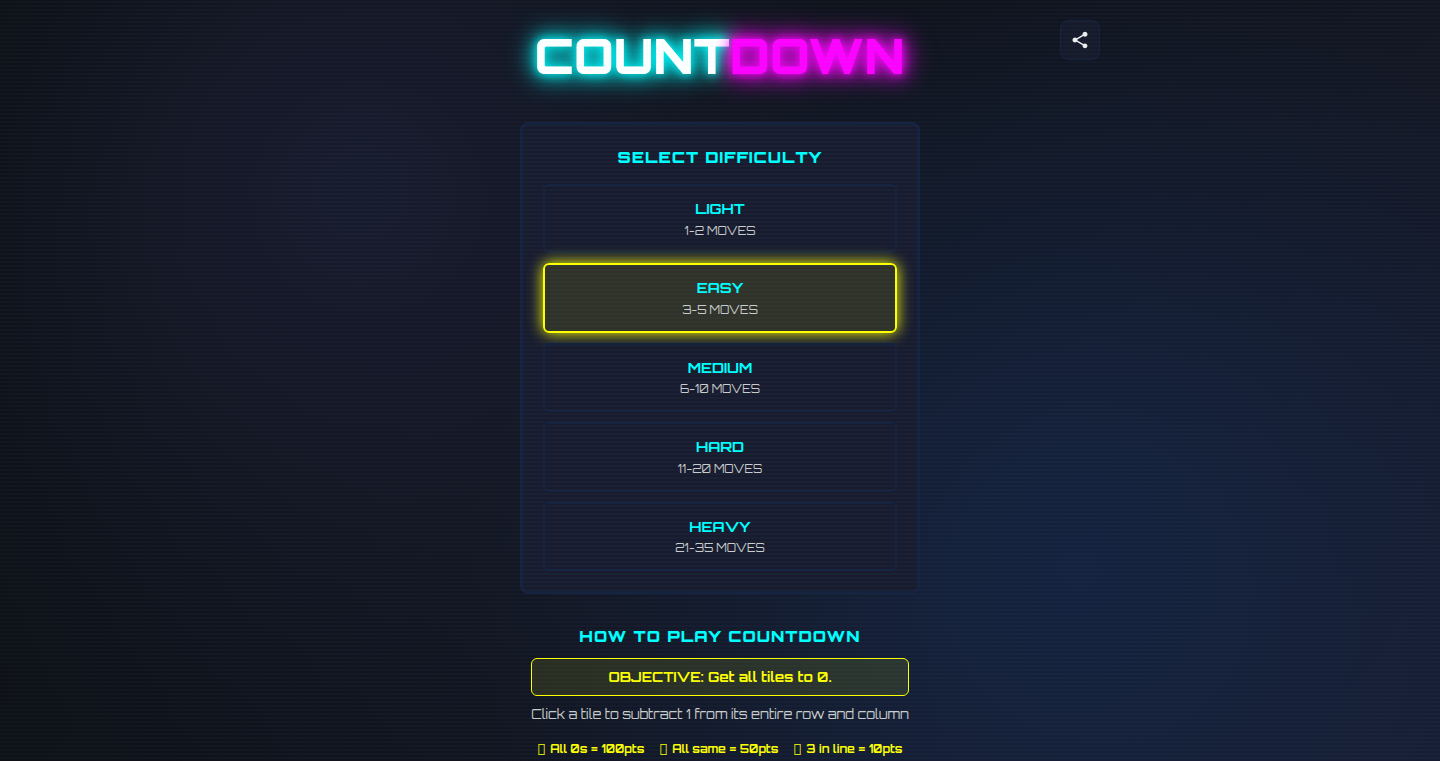
Author
magikMaker
Description
This project is a new game called 'Countdown' built with a probabilistic engine. It uses techniques from artificial intelligence and game theory to create a challenging and engaging game experience. The core innovation lies in its ability to predict and adapt to the player's moves, offering a dynamic and unpredictable gameplay that goes beyond traditional game mechanics. This game uses probability to give it more dimensions.
Popularity
Points 2
Comments 1
What is this product?
This is a number game that is powered by a custom-built game engine. It uses probabilistic models – think of it like a smarter version of guessing or predicting. The engine analyzes the player's past moves and calculates the probability of future moves, creating a dynamic and adaptive opponent. This means the game gets more challenging as you play, constantly learning and adjusting. So this allows for a more interesting and less predictable experience.
How to use it?
Players can access and play the game through a web interface or a downloadable application (if available). Developers could potentially integrate this probabilistic game engine into their own projects, perhaps building more complex games, simulations, or even AI-powered educational tools. The basic integration would involve calling the engine's API and feeding in player inputs to receive the engine's probabilistic response or action. So this opens up possibilities for personalized and adaptive experiences.
Product Core Function
· Probabilistic Prediction: The engine predicts the player's next move by analyzing the previous moves. This is done through probabilistic models, providing a dynamic experience.
· Adaptive Difficulty: The game engine adjusts the difficulty based on the player's skill level and game style, making the gameplay challenging.
· Real-time calculation: The game makes the calculation in real time, which makes the game very reactive and responsive to the players' actions.
· Game Logic: The game engine is responsible for handling the core gameplay logic, determining game state, and applying game rules. This is essential for creating an enjoyable game.
Product Usage Case
· A game developer could use the engine to create a more engaging opponent AI in a strategy game, where the AI can proactively anticipate a player's moves and offer a dynamic challenge. It creates a more life-like opponent.
· An education company could use the probabilistic game engine to build learning games. This allows the game to adjust to student's skill and adapt the teaching style dynamically. This will improve the effectiveness of the teaching.
· Researchers could experiment with different AI strategies by analyzing data from how players play. It gives a great sandbox to try new ideas and see how it works.
20
SnookerGameEx: Real-time Multiplayer Snooker with Elixir
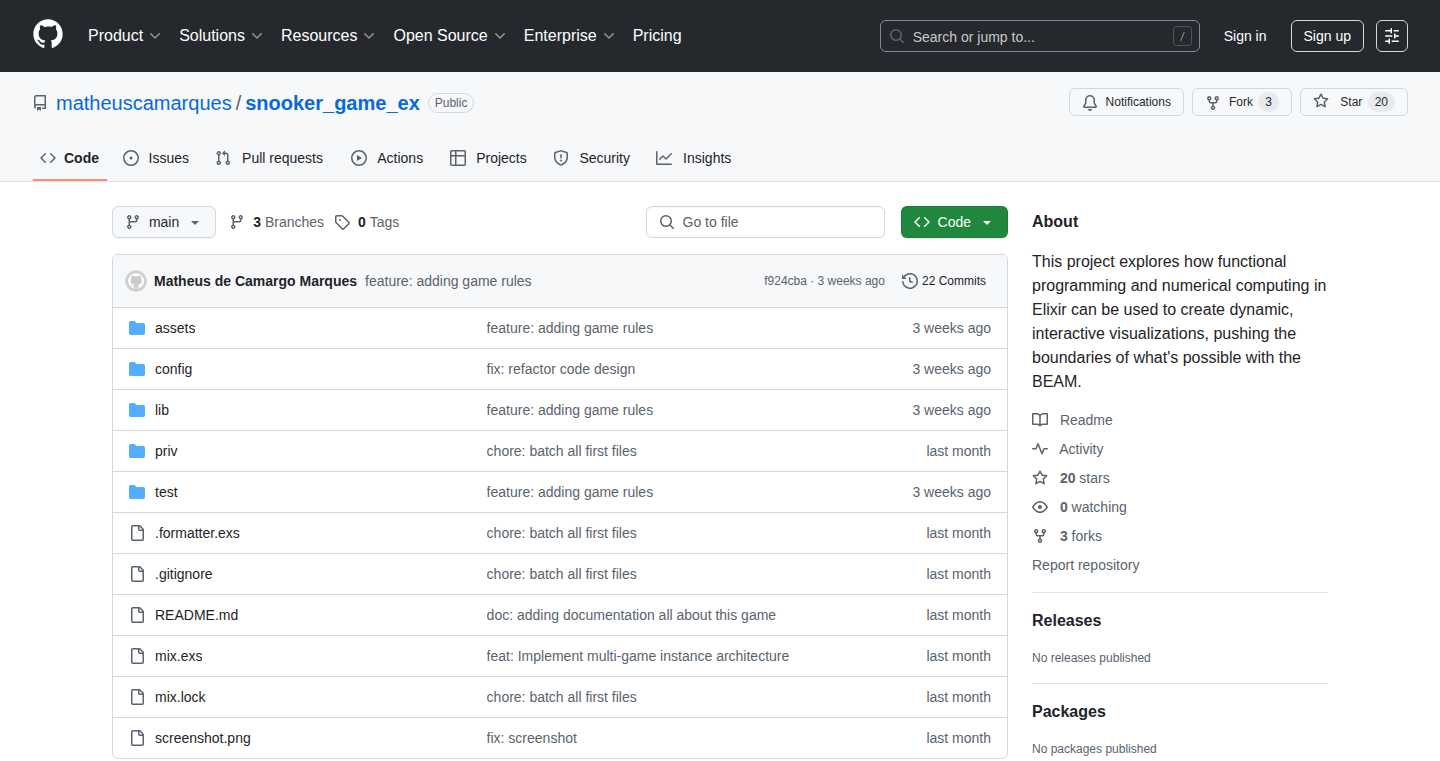
Author
matheusosan
Description
SnookerGameEx is a real-time multiplayer snooker game built using Elixir, a functional programming language known for its ability to handle concurrency and fault tolerance. This project showcases how Elixir can be used to build interactive and dynamic applications, particularly those requiring real-time updates and multiple users. The core innovation lies in its use of the BEAM (Erlang Virtual Machine) and Elixir's concurrency features to manage the game state and user interactions in real-time. So what? This approach allows for a smooth, responsive gameplay experience even with multiple players connected simultaneously.
Popularity
Points 3
Comments 0
What is this product?
SnookerGameEx is a snooker game that runs in real-time, allowing multiple players to compete against each other. It's built using Elixir, leveraging the BEAM (Erlang Virtual Machine) for its powerful concurrency capabilities. This means the game can handle many players simultaneously without slowing down. The key innovation here is applying functional programming principles and the BEAM's concurrency features to create a responsive and fault-tolerant multiplayer game. This demonstrates how Elixir can be used for building applications that require real-time interaction and scalability. So what? It proves Elixir is a viable technology for building complex, interactive applications beyond typical web services.
How to use it?
Developers can use the SnookerGameEx code as a learning resource to understand how to build real-time multiplayer applications with Elixir. The codebase demonstrates how to manage game state, handle user input, and synchronize data between multiple clients. Developers can adapt the game's architecture and codebase to build their own real-time applications, such as chat applications, collaborative tools, or other interactive games. So what? By studying this project, developers can learn practical techniques for building their own scalable real-time applications.
Product Core Function
· Real-time Multiplayer Gameplay: The game supports multiple players interacting simultaneously, with each player's actions reflected in real-time for all connected players. Technical Value: This demonstrates Elixir's concurrency capabilities, enabling applications to handle multiple concurrent users seamlessly. Application Scenario: Building collaborative tools or interactive multiplayer games.
· Game State Management: The game maintains a consistent state of the snooker table, including the position of balls, player turns, and scores. Technical Value: This showcases how to manage complex data within a functional programming paradigm, ensuring data integrity and accuracy. Application Scenario: Developing any real-time collaborative applications with a shared state.
· User Input Handling: The game efficiently processes user inputs, such as cue movements and shots, ensuring responsive gameplay. Technical Value: This demonstrates techniques for handling user interactions in a real-time environment, minimizing latency and maximizing responsiveness. Application Scenario: Designing user interfaces for real-time interaction in any application.
· Network Synchronization: The game synchronizes game data between all connected clients, providing a consistent view of the game for each player. Technical Value: This highlights methods for building robust networking solutions, essential for creating multiplayer applications. Application Scenario: Creating any real-time applications where data needs to be consistently displayed among multiple clients.
Product Usage Case
· Real-time Chat Application: Imagine building a chat app where messages are sent instantly to all users, without any delay. This project can serve as a foundation for building such a system, demonstrating how to manage user connections and send messages in real-time. So what? You could build a fast and responsive chat application.
· Collaborative Document Editor: Similar to Google Docs, imagine a real-time document editor where multiple users can edit the same document simultaneously, seeing changes reflected instantly. SnookerGameEx's architecture provides a blueprint for handling real-time synchronization and user interactions in such a scenario. So what? You could make a collaborative tool where people can work together simultaneously.
· Interactive Education Platforms: Picture an educational platform where students can interact with simulations and quizzes in real-time. The game's real-time capabilities and concurrency management could be applied to building such interactive learning experiences. So what? You could develop educational tools that are engaging and interactive.
21
Microverse: A Tiny macOS System Monitor
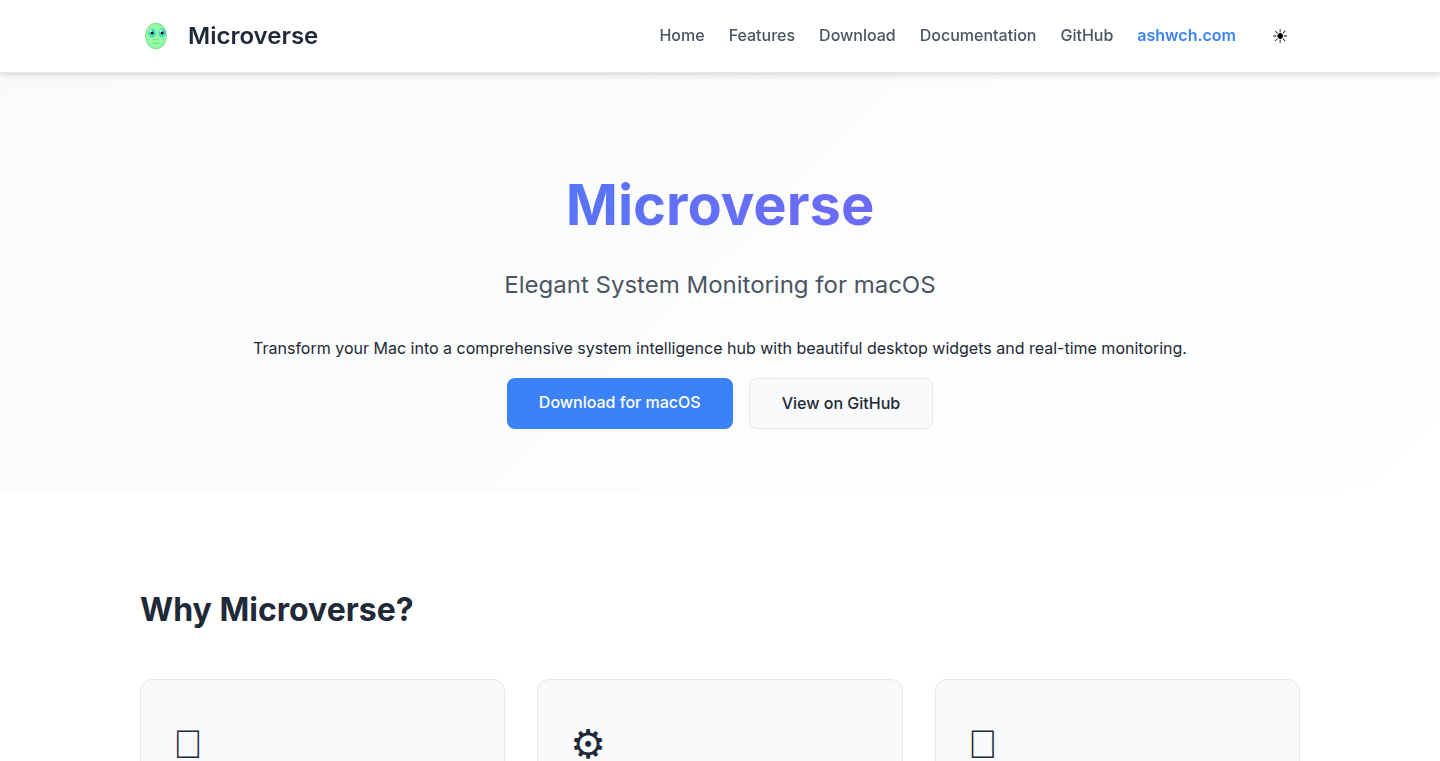
Author
ashwch
Description
Microverse is a lightweight system monitor for macOS designed to track battery health, CPU usage, and memory consumption with minimal resource impact. It achieves this by utilizing direct IOKit/mach calls (low-level system communication) and adaptive refresh rates. The project's innovation lies in its ability to provide detailed system information without significantly affecting the computer's performance, addressing the common problem of resource-intensive monitoring tools.
Popularity
Points 3
Comments 0
What is this product?
Microverse is a small program that keeps an eye on your Mac's performance, like how much battery life you have left, how busy your computer's brain (CPU) is, and how much memory it's using. It's special because it uses very little of your computer's resources (less than 1% of the CPU and less than 50MB of memory). It does this by talking directly to the core of the Mac's operating system using something called IOKit/mach calls, which is like speaking the computer's secret language. Also, it updates the information only when needed, saving even more resources. So what? This means it doesn't slow your computer down while giving you important info.
How to use it?
Developers can use Microverse as a utility to monitor their own system resources while developing or testing applications. They can quickly identify performance bottlenecks or resource-intensive processes. You can download it from the provided link. As it's open source, developers can also look at the code to understand how it works, and even modify and improve it for their own needs. The project is built with SwiftUI, allowing for easy integration of desktop widgets. So what? You can easily see how your computer is doing while you work, and even build your own monitoring tools based on this example.
Product Core Function
· Battery Health Monitoring: Displays real-time battery status and health information. This allows developers and users to keep track of their battery performance and potential issues. This provides insights into battery degradation and overall system health. So what? You know how your battery is doing, helping you avoid unexpected shutdowns.
· CPU Usage Monitoring: Tracks CPU usage, identifying processes that are consuming the most processing power. This is valuable for diagnosing performance issues and optimizing applications. So what? It helps you find out which programs are slowing down your computer.
· Memory Usage Monitoring: Monitors memory consumption, helping to understand how much RAM is being used by different applications. This is critical for identifying memory leaks or resource-intensive applications. So what? You can ensure your computer isn't running out of memory and slowing down.
· Adaptive Refresh Rates: Dynamically adjusts the frequency at which system information is updated, minimizing the impact on system resources. This means the monitor updates more frequently when the information changes rapidly. So what? It gives you up-to-date info without slowing things down.
· Direct IOKit/Mach Calls: Uses direct calls to the macOS kernel for efficient data retrieval, minimizing overhead. This gives more accurate and faster system data collection with low resource impact. So what? Information is gathered faster and with less impact on your computer’s speed.
Product Usage Case
· Software Development: A developer is working on a resource-intensive application. Using Microverse, they can monitor CPU and memory usage to identify and resolve performance bottlenecks in their code. So what? The developer can optimize their software more efficiently.
· System Optimization: A user experiences slow performance on their Mac. They use Microverse to pinpoint a specific application consuming excessive resources, allowing them to close it and improve system responsiveness. So what? Users can actively improve computer performance.
· Battery Life Analysis: A user wants to understand the impact of different applications on their MacBook's battery life. They use Microverse to monitor battery health and CPU usage while running various programs, identifying battery-draining applications. So what? Users can identify battery usage patterns.
· Widget Integration: A user enjoys customizing their desktop. They use the provided desktop widget styles to display the system information in a visually appealing and easily accessible manner. So what? The user has real-time performance data at a glance.
22
Rulesync: Kiro-Powered Data Synchronization
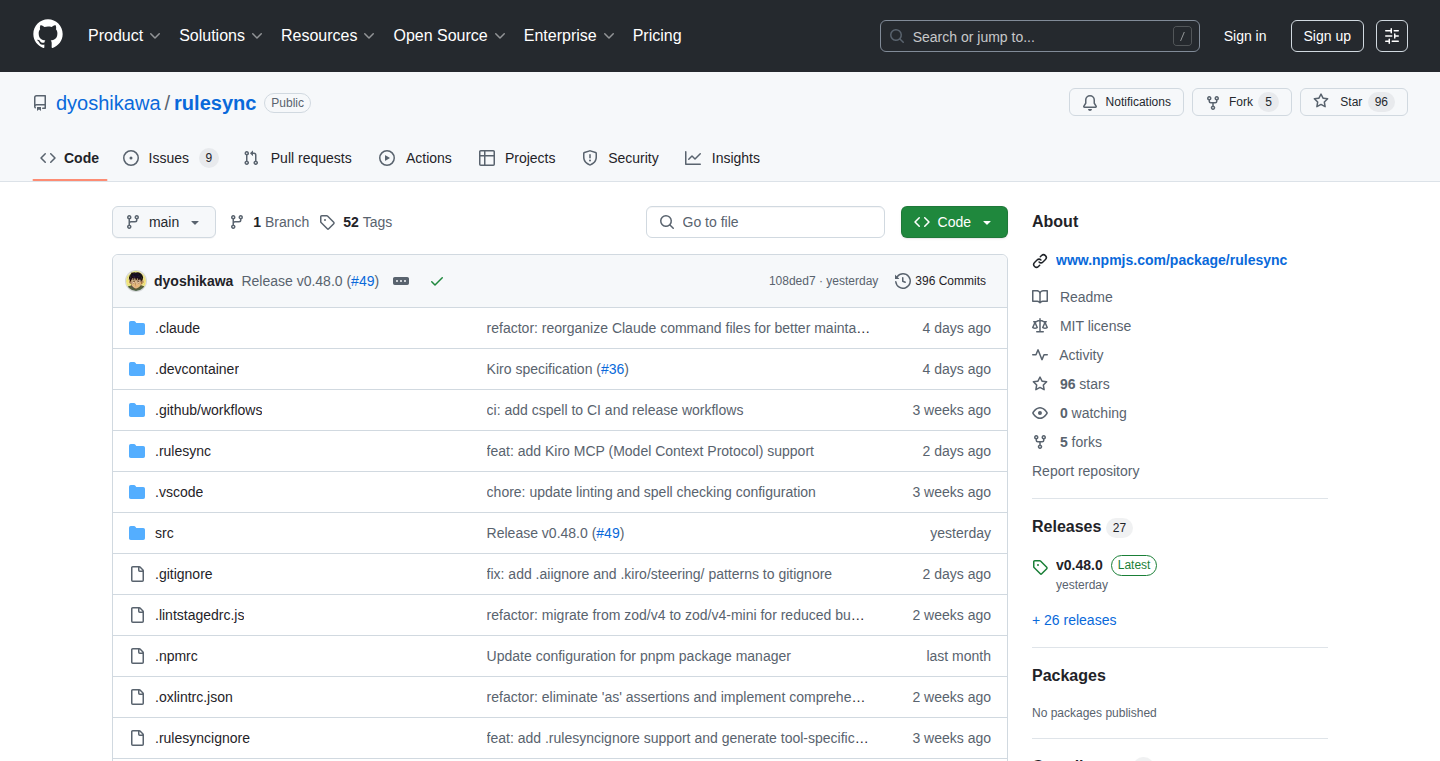
Author
dyoshikawa
Description
Rulesync is a tool designed to synchronize data between systems, using Kiro as the underlying technology to define and manage the synchronization rules. The innovation lies in leveraging Kiro's features to simplify the process of data integration, offering a declarative approach to describe data transformations and synchronization logic. It addresses the common challenge of keeping data consistent across different platforms, databases, or applications. So this is a useful tool if you need a simple way to sync different systems data.
Popularity
Points 2
Comments 0
What is this product?
Rulesync allows you to define rules for how data should be transferred and transformed between various systems. It utilizes Kiro, a potentially new technology or framework, to make the rules easier to write and maintain. Instead of writing complex code to move and manipulate data, you specify what you want to happen in a more straightforward way. The advantage is that this simplifies complex data synchronization tasks. So this is a useful tool if you need a simple way to sync different systems data.
How to use it?
Developers can use Rulesync by defining their data synchronization rules using Kiro. These rules could specify how data from a database should be formatted and sent to another system, or how data should be merged from multiple sources. The user provides configuration files or code snippets describing the mapping, transformation, and destinations. Once set up, Rulesync runs automatically, ensuring that the data is kept up-to-date and consistent. So if you have to work with syncing databases and platforms, this is an useful approach.
Product Core Function
· Declarative Rule Definition: Defining data synchronization logic using Kiro, providing a higher-level, easier-to-understand way of specifying transformations. So, it simplifies the way you tell the system what to do, making it easier to understand and modify synchronization tasks.
· Data Transformation: Implementing the ability to transform data during synchronization. This involves mapping fields, changing formats, or applying calculations to the data before it reaches its destination. So, it ensures that the data fits the needs of the target system, regardless of its original format.
· Real-time Synchronization: Enabling synchronization to happen in real-time or near real-time, ensuring that the data is always up-to-date. So, it eliminates delays and ensures the most current information is available.
Product Usage Case
· E-commerce Platform Integration: Synchronizing product data, customer information, and order details between an e-commerce platform and an inventory management system. This could keep the product catalogs and customer records up-to-date across different systems. So, it solves the problem of keeping customer data synchronised
· Data Warehouse Updates: Populating a data warehouse from multiple source databases, making sure that the data warehouse contains the most recent and accurate data. So, it means you can keep your insights up-to-date by syncing data with a data warehouse.
· Customer Relationship Management (CRM) Integration: Synchronizing lead data and contact information between different CRM systems or integrating a CRM with other marketing automation tools. So, this will allow the marketing teams to make better use of the information they have.
23
DigestionFlow: Real-time Digestion Tracker

Author
YaccoHakon
Description
This project is a real-time digestion tracker app created by a developer to monitor their own digestive process. The technical innovation lies in the use of a personalized data collection approach, potentially involving a combination of self-reported data and sensor integration (though details are absent in the Show HN). It addresses the technical challenge of accurately tracking complex biological processes and provides insights into personal health. It emphasizes the power of building tools to address specific problems, reflecting the core hacker philosophy.
Popularity
Points 2
Comments 0
What is this product?
DigestionFlow is a personal health tracking app built by the developer. It likely uses data input methods to monitor the user’s digestive health in real-time. The innovation lies in its individualized approach, focusing on a highly specific problem and building a custom solution to gain insights. It’s a data-driven approach to understanding your body better. So this lets you analyze the data you personally record. This means you can better understand your health issues.
How to use it?
The developer would likely use DigestionFlow by manually inputting data points, potentially including information about food intake, symptoms, and other relevant metrics. Depending on the implementation, the app may also integrate with external sensors. Developers could adopt this approach by building similar applications to analyze other biological data, experiment with data collection methods, or create custom health tracking solutions. The developer could potentially use this data to find patterns in the data, which can improve their health. So you can create your own custom health tracking tool.
Product Core Function
· Real-time data logging: The core function is to log data about the user's digestion in real-time. This involves creating an interface or method for the user to input information about their eating habits and digestive health. This creates a detailed record of what’s happening. So this helps you see what affects your digestive system.
· Personalized data analysis: Analyzing the collected data to find correlations and patterns related to digestion. This could involve developing algorithms or using existing tools to visualize the data and identify potential triggers or issues. So this lets you find patterns to understand digestive issues.
· Customizable data input: Creating a flexible interface to accommodate different data types, such as food logs, symptoms, and other related information. This ensures that the application can adapt to the user's specific needs and data preferences. So you can build your own dashboard to log any info that you want.
· Data visualization: Presenting the collected data through intuitive charts and graphs to facilitate understanding. This visual representation makes the data easier to interpret, allowing the user to identify patterns and trends quickly. So you can turn your data into pretty charts.
Product Usage Case
· Personal health monitoring: A user struggling with digestive issues can manually input data, analyze the data, and identify specific foods or habits that trigger problems. This would help the user be aware of the correlation between food and health problems. So you can improve your diet with this knowledge.
· Development of custom health tracking solutions: Developers can use the codebase or design principles to build similar applications for other personal health metrics, like sleep tracking or fitness data analysis. So you can modify this code to track anything.
25
Flowchart AI: Turn English into Flowcharts
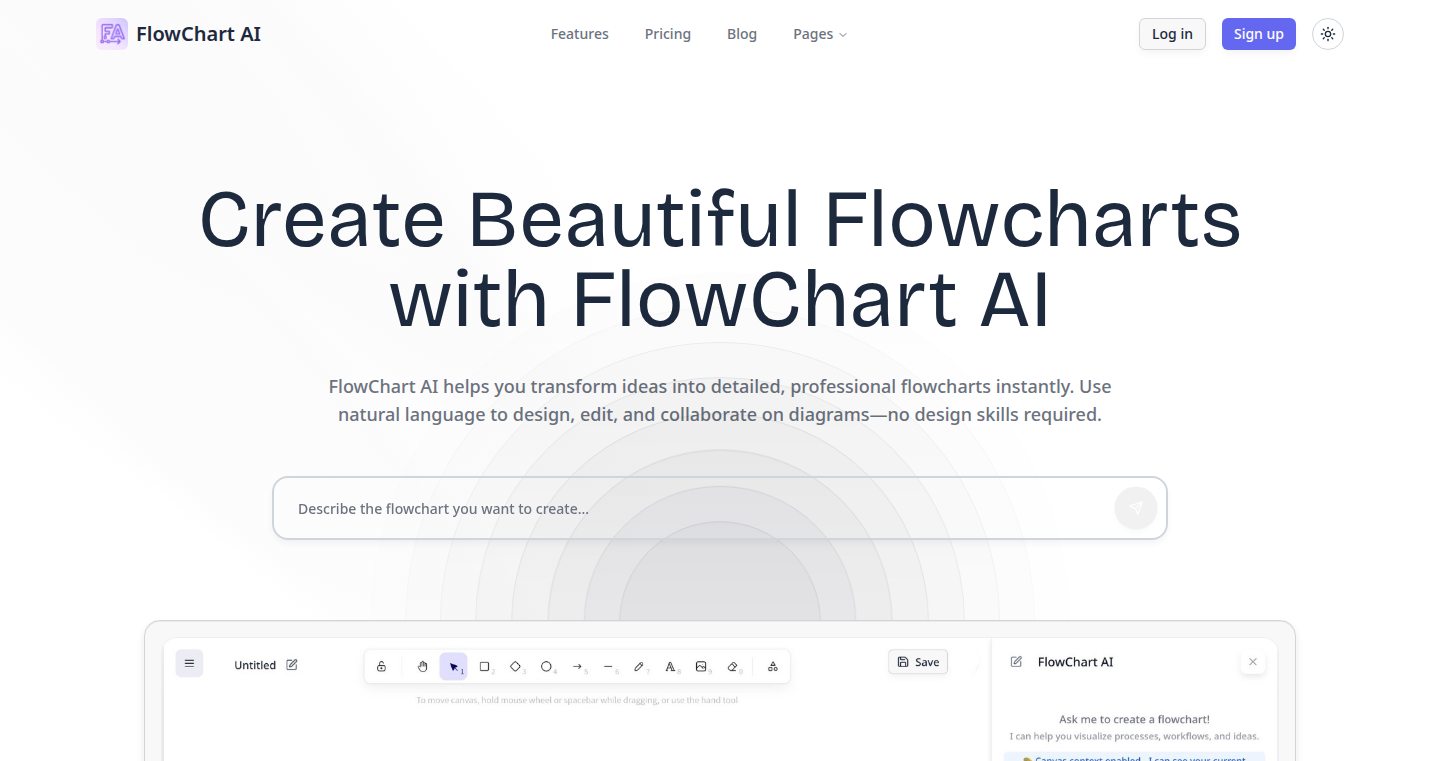
Author
tanchaowen84
Description
Flowchart AI is a tool that uses artificial intelligence to transform plain English descriptions of processes into interactive flowcharts. It addresses the common problem of needing to visualize complex procedures quickly, especially during code reviews and product planning. Instead of manually drawing flowcharts, users can simply describe the steps in natural language, and the AI generates an editable flowchart. This project highlights the power of combining natural language processing with visual representation, streamlining workflow documentation and communication.
Popularity
Points 2
Comments 0
What is this product?
This project leverages a large language model (Gemini 2.5 Flash) to understand and interpret English text describing a process. It then uses this understanding to automatically generate a flowchart. The generated flowchart is editable, allowing users to refine and customize the visualization. It provides a user-friendly interface built with Next.js and TypeScript. The backend uses Vercel Serverless Functions and stores user data (if applicable) in Supabase and Cloudflare R2 for storage. So this is useful because it saves developers and product managers time and effort by automating the flowchart creation process. Instead of spending hours drawing, you can get a starting point in seconds, and then modify it.
How to use it?
Developers can use Flowchart AI by simply inputting a step-by-step description of a process in English into the provided interface. The tool then generates a corresponding flowchart that can be edited and used. For example, a developer can describe a code review process, and Flowchart AI will create a visual representation of the steps involved, like checking for errors, merging the code, etc. This can then be embedded in documentation, shared with teammates, or used to clarify complex procedures during product planning. If you are working on a project, you can use Flowchart AI to easily document your process flow, share it with your team members, and get everyone on the same page. You can also integrate the tool into your workflow by self-hosting the open-source version. So this is useful because it can be integrated into any workflow that requires visual representation of processes.
Product Core Function
· Natural Language to Flowchart Generation: The core function is to transform English descriptions into flowcharts. This leverages the power of AI (Gemini 2.5 Flash) to understand the context and generate the visual representation. This is useful because it dramatically reduces the time and effort required to create flowcharts, especially for complex processes.
· Editable Flowcharts: The generated flowcharts are editable, allowing users to customize them, add details, and refine the visual representation to match their exact requirements. This is useful because it ensures the flowchart accurately reflects the intended process and can be easily adapted to different scenarios.
· Frontend Interface: The frontend, built with Next.js and TypeScript, provides a user-friendly interface for inputting text, viewing the generated flowchart, and editing it. This is useful because it makes the tool easy to use and accessible to anyone, regardless of their technical expertise.
· Export in .excalidraw format: Currently supports exporting diagrams in .excalidraw format, which is a great option for collaborating and further editing. This is useful because it allows for flexible usage and sharing of generated flowcharts.
· Integration with Google Authentication: Users can log in with Google (via BetterAuth) for daily usage. This is useful because it provides a secure and convenient way for users to access the tool with some usage limits, which are helpful for managing resources and ensuring the sustainability of the service.
Product Usage Case
· Code Review Documentation: A developer can use Flowchart AI to describe the steps involved in a code review process (e.g., code inspection, testing, merging). The tool generates a flowchart that clearly visualizes these steps, improving communication and understanding among team members. This allows everyone on the team to be on the same page. So this is useful because it makes the code review process more efficient and transparent, especially for distributed teams.
· Product Planning and Process Mapping: Product managers can use Flowchart AI to map out user flows, customer journeys, or product development processes. For example, by describing the steps a user takes to complete a purchase, they can generate a flowchart that visualizes the entire process. This can then be used to identify bottlenecks, optimize the user experience, and improve product design. So this is useful because it simplifies complex product planning and helps teams visualize and improve the overall user experience.
· Technical Documentation: Technical writers can use Flowchart AI to create visual representations of complex technical processes, such as system architectures or data pipelines. By describing the steps and components, they can generate flowcharts that are easily understood by both technical and non-technical audiences. So this is useful because it makes it easier to explain and understand complex technical concepts, leading to better documentation and knowledge sharing.
26
Paravia.wasm: A WebAssembly Revival of Santa Paravia en Fiumaccio

Author
MrGilbert
Description
This project brings the classic 1978 resource management game "Santa Paravia en Fiumaccio" to the modern web using WebAssembly. It's a C# rewrite of a C port of the original game, now playable directly in your web browser. The core innovation lies in transpiling the game logic written in C# into WebAssembly, enabling it to run efficiently in the browser. This approach allows a classic game to be experienced by a new audience without requiring any plugins or installations. The project highlights the power of WebAssembly in reviving legacy software and making it accessible on modern platforms.
Popularity
Points 2
Comments 0
What is this product?
This is a recreation of the old text-based resource management game "Santa Paravia en Fiumaccio," originally from the 70s. The project takes the game's code, written in C#, and converts it into WebAssembly, a special format that web browsers can run quickly and efficiently. So, it's an old game, but it runs in your web browser. The innovation is in how it's been adapted for modern web use using WebAssembly. This means you can play a classic game without needing to download anything or install special software.
How to use it?
Developers can use this project to learn how to bring old code to the web. They can examine the C# source code, see how it's compiled into WebAssembly, and use this as a template to convert their own older programs. The code is available on GitHub under a permissive license (GPL 2), meaning you can download it, modify it, and reuse it for your own projects. You could integrate the game into your own website or use its core logic to build your own resource management games. The key is understanding how WebAssembly allows you to run code written in other languages directly in the browser.
Product Core Function
· Game Logic Conversion: The core functionality is the successful conversion of the original game logic, initially written in older programming languages and adapted to C#, into WebAssembly. This demonstrates how existing applications can be made compatible with modern web browsers. This is valuable because it allows us to keep older games alive and accessible, allowing them to run within any modern browser.
· WebAssembly Integration: The project uses WebAssembly to run the game code in the browser. WebAssembly provides a near-native execution speed, delivering a smooth gaming experience. This is useful because it allows you to run complex applications in a web browser with speed close to native applications, without the need for external plugins.
· Cross-Platform Compatibility: This project is inherently cross-platform because WebAssembly is supported by all major web browsers. This ensures the game works consistently on different devices (desktops, laptops, phones, etc.) and operating systems. This is valuable because it ensures the game can reach a wider audience without needing any special settings or separate versions for different devices.
Product Usage Case
· Retro Game Preservation: Developers can use the techniques shown here to preserve and revitalize other classic games written in older languages like C or C++. By porting them to WebAssembly, these games can be kept alive and playable on the web for future generations. For example, you can take a classic game you loved and recreate it to be playable within modern browsers.
· Educational Tool: The project can serve as an educational resource for developers who want to learn about WebAssembly and cross-platform development. They can study the code to understand how to convert their own software into a format that works in web browsers. This is extremely useful for learning about how to run software that originally only worked on a desktop or specific machine in a web environment.
· Browser-Based Game Development: The project serves as a demonstration of how to build complex games that can run in the browser using WebAssembly. This encourages developers to explore this approach and create new browser-based games without relying on traditional plugins or browser-specific technologies. It can provide insights on how to run games in a browser without needing to install additional software.
27
Canyoulook.at - Daily Photo Challenge with AI Image Recognition

Author
boo-ga-ga
Description
Canyoulook.at is a web app that challenges users to find specific objects in their surroundings or photo galleries. It uses AI, specifically Llama-3.2-11B-Vision-Instruct and MiniLM-L6-v2, to analyze images and determine if a user's photo matches the daily challenge. This project showcases how to use AI to create an interactive game and highlights the power of combining different AI models for image analysis and comparison. So this means you can have some fun with AI!.
Popularity
Points 2
Comments 0
What is this product?
This project is an interactive web app that combines image recognition AI with a daily challenge format. It works in two modes: a pre-selected daily challenge and a user-created challenge mode. The app takes your photo, generates a description using Llama-3.2-11B-Vision-Instruct (a type of AI that 'sees' and describes images), and then compares the description to the challenge using MiniLM-L6-v2 (another AI that helps compare texts). This setup allows the app to tell if the photo you took matches the challenge. So this means you can play a fun image-based game with your friends or family.
How to use it?
Developers can integrate this technology into their own projects in several ways. They could use the Llama-3.2-11B-Vision-Instruct and MiniLM-L6-v2 models via APIs (provided by DeepInfra.com in this case) for image recognition, content moderation, or even create their own interactive games or educational tools. The project's code (if available) can serve as a starting point for understanding how to build a simple AI-powered application. So this means you can borrow the techniques to create your own unique AI applications.
Product Core Function
· Daily Challenge Generation: The app provides a new challenge every day. This feature leverages the power of AI to generate unique prompts, keeping the game fresh and engaging. It uses a combination of LLM (Llama-3.2-11B-Vision-Instruct) and similarity comparison to assess images. So this means you don't need to think of new game every day, AI is doing it for you.
· User-Created Challenges: Users can create and share their own challenges with friends, increasing user engagement and providing a social element. This highlights the flexibility of the underlying AI models. So this means you can share fun challenges with your friends and family, which makes the experience interactive.
· Image Analysis with Llama-3.2-11B-Vision-Instruct: The core of the app uses Llama-3.2-11B-Vision-Instruct to analyze images. This model provides a text description of what's in the photo, making it understandable for comparison. So this means AI will understand your image and make its description to compare with the prompts.
· Challenge Verification with MiniLM-L6-v2: The app uses MiniLM-L6-v2 to compare the image descriptions generated by Llama-3.2-11B-Vision-Instruct with the challenge prompts. This determines if the user's photo matches the challenge. So this means it helps to check if the image descriptions match the challenge or not.
· Result Sharing: After the image reveal, the app allows users to share their results, inspired by Wordle. This increases user engagement and sharing. So this means you can share your results with your friends and play a social game.
Product Usage Case
· Creating an Educational App: A developer could modify the code to create an educational app where students take photos and the app provides feedback on what they see in the images. For example, this might be used in an app to teach kids to identify plants and animals. So this means you can use it to teach children about different objects.
· Building a Content Moderation Tool: The AI image recognition could be used to create a tool that automatically flags inappropriate content in user-generated images. This could be integrated into social media platforms or online forums. So this means you can automatically detect inappropriate images.
· Developing a Search Engine for Images: The image recognition technology could be used to develop a more intelligent image search engine, allowing users to search by describing the content of an image rather than just using keywords. So this means you can search a image just by giving the description.
· Designing Interactive Games: The core technology can be adapted to create various interactive games that involve image recognition. For example, a scavenger hunt game, where users are given a prompt and have to find a matching item in their environment and submit the photo. So this means you can play many games with your friends.
28
MoM-Gateway: A Gateway for Blending AI Coding Assistants
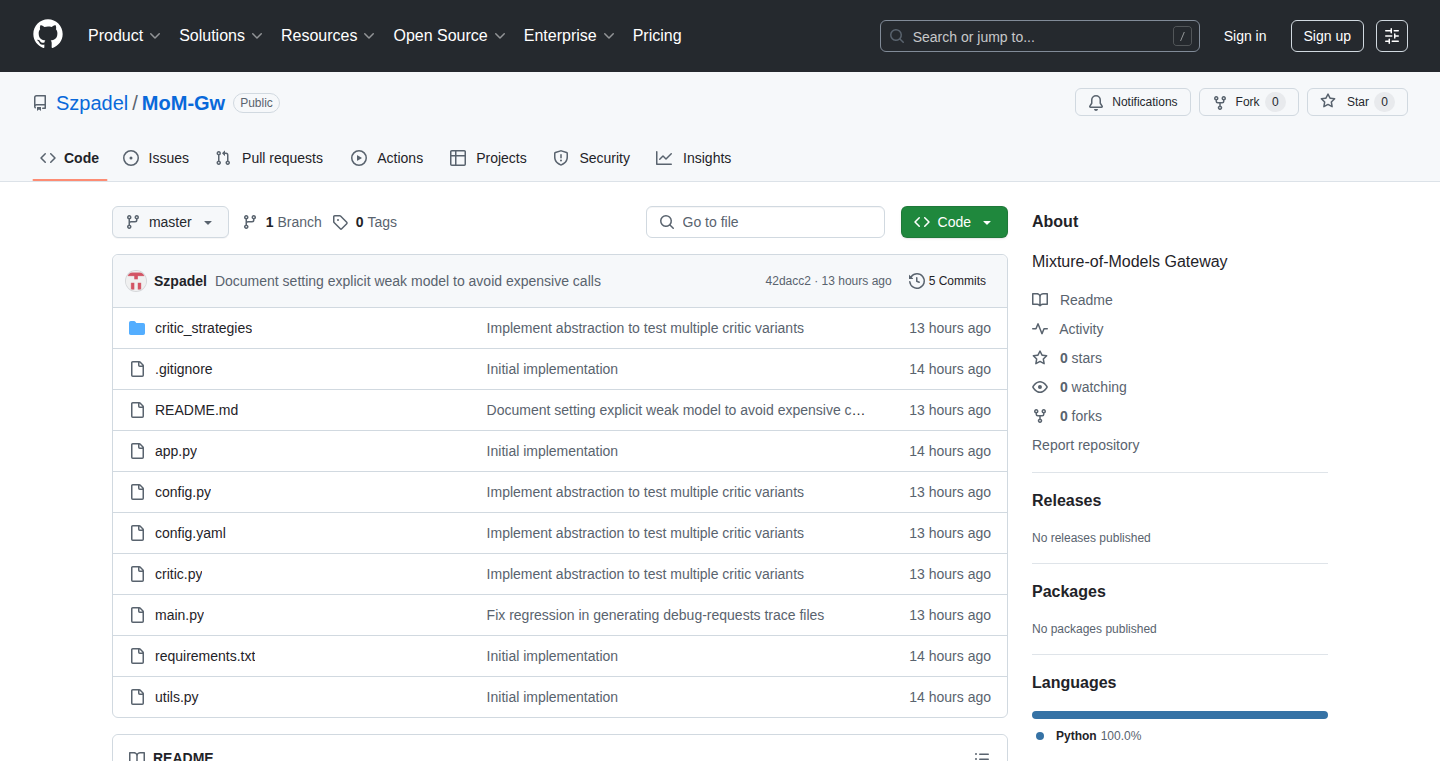
Author
Szpadel
Description
This project introduces a 'Mixture-of-Models' (MoM) gateway designed to improve the accuracy of AI coding assistants. The core innovation is simple: instead of relying on a single AI model, the gateway queries multiple AI models simultaneously and then intelligently combines their answers. This approach leverages the strengths of different models, leading to more accurate and reliable code suggestions. It addresses the problem of inconsistent or incorrect code generation often seen with single-model solutions.
Popularity
Points 2
Comments 0
What is this product?
This project is a gateway that acts as an intermediary between a developer's coding environment (like an IDE or an AI coding assistant such as aider) and multiple AI code generation models. The key innovation is its 'mixture-of-models' approach. When a developer asks for code, the gateway doesn't just pass the request to one AI. Instead, it sends the request to several AI models in parallel. Then, it merges and synthesizes the responses received from all models to produce a combined, often more accurate, answer. So what? This can help you write better code faster and with fewer errors. It's like having multiple expert programmers working together on your code.
How to use it?
Developers would integrate this gateway into their existing coding workflows. For example, if you use a tool like 'aider', you could configure the gateway to become the central point for your coding model requests. Developers would configure their coding assistant to communicate with the MoM gateway, instead of a single AI model. The gateway then handles the requests to multiple models, and then it returns a combined response back to the assistant, which then displays the final, improved code suggestion. So what? This simplifies the selection and integration of multiple models, making it easier to test and compare different model performances, and enabling you to improve the output of your existing tools. The goal is to make the coding assistant work smarter.
Product Core Function
· Parallel Request Dispatch: The gateway sends the same coding request to multiple AI models simultaneously. Value: This dramatically reduces the time it takes to get a response compared to querying models sequentially. Application: Improves the responsiveness and efficiency of AI-assisted coding tools. So what? It speeds up your coding and gives you answers quicker.
· Response Aggregation: The gateway receives multiple answers from different AI models and intelligently combines the responses. Value: This combines the strengths of different models, mitigating individual model weaknesses and improving overall accuracy. Application: Ensures more reliable and accurate code suggestions, reducing the chances of bugs. So what? You will get better and more reliable coding suggestions.
· Model Agnostic Interface: The gateway can interface with various AI coding models without requiring changes to the developer's existing tools. Value: Allows developers to easily switch between different AI models or test multiple models to find the best fit for the project. Application: Offers flexibility and control over the AI tools used in the development pipeline. So what? You get to easily try out and compare multiple AI models, with minimal setup.
· Configurable Model Selection: The gateway allows selection of which AI models to use. Value: Enables experimentation with different model combinations based on performance and specific needs. Application: Tailors the AI-assisted coding experience to different programming languages, coding styles, or project requirements. So what? You can customize your AI assistance to fit your project requirements perfectly.
Product Usage Case
· Debugging Assistance: When a developer asks for assistance with a bug, the gateway can consult several AI models. One model might suggest a fix, another might identify the root cause, and the gateway combines these answers to create a more effective debugging solution. Application: Dramatically reduces debugging time and increases the quality of solutions. So what? You spend less time fixing bugs.
· Code Generation from Comments: If a developer writes comments explaining the desired functionality, the gateway can generate code using various AI models. Each model generates a different version of the code. The gateway can then combine these versions or provide a ranked list of the best suggestions. Application: Automates code generation based on human-readable instructions. So what? It helps write code from the comments you write.
· Refactoring Suggestions: When refactoring existing code, the gateway could use AI models for refactoring the code into a better one. Then, the gateway can aggregate the suggestions for improved code design and performance. Application: Helps identify potential code improvements to the user. So what? You will have code that is easier to read, maintain, and improve the performance.
· Comparative Analysis: The gateway can be used to compare the outputs of different AI models. For example, if a developer is unsure which model to use, the gateway can query several models and present their different code suggestions side-by-side, allowing for direct comparison. Application: Provides developers with insights into the capabilities of different AI models. So what? This allows you to select the best model for your specific coding project.
29
MatchmakingEx: Real-time, Scalable Matchmaking Engine with Elixir
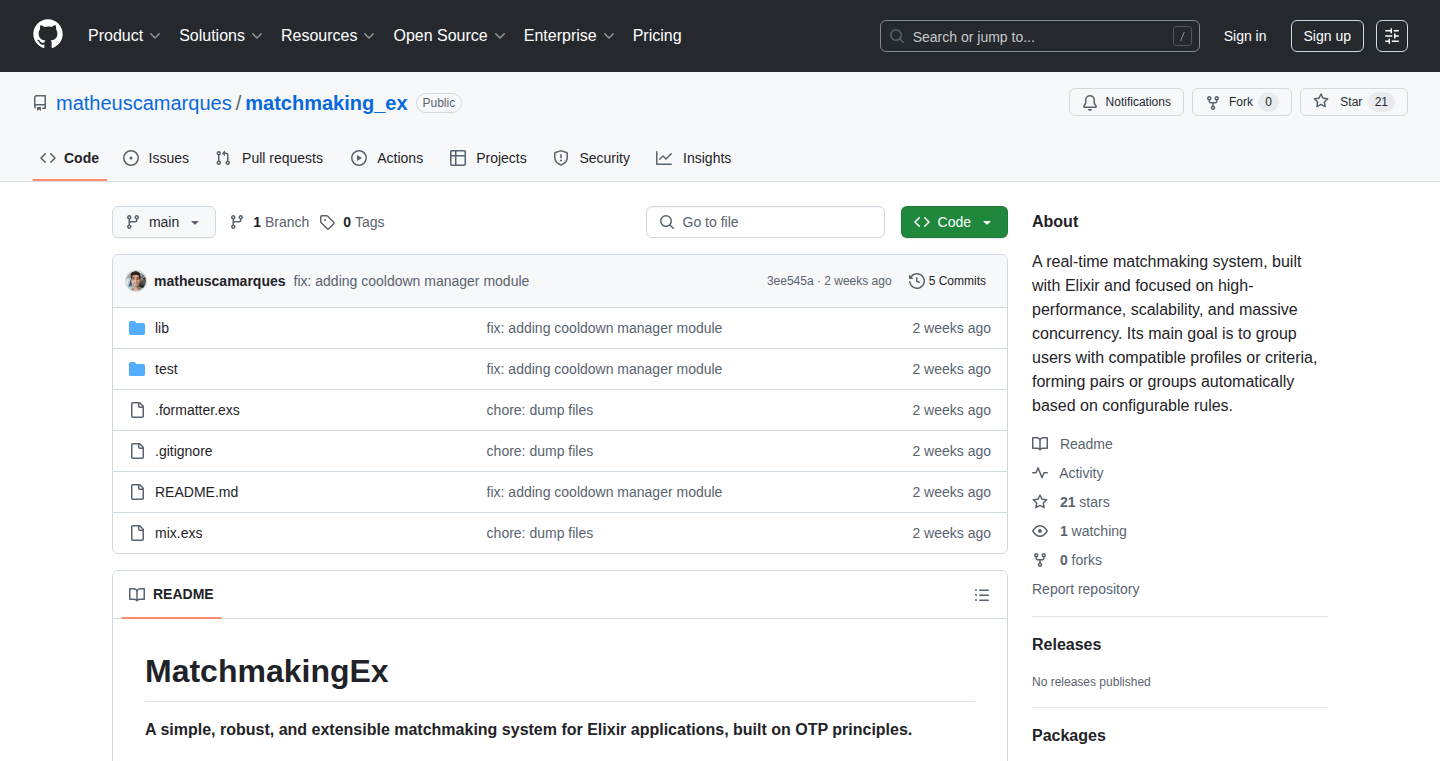
Author
matheusosan
Description
MatchmakingEx is a real-time matchmaking system built using Elixir and OTP principles. It's designed for high performance, scalability, and massive concurrency, meaning it can handle a huge number of users simultaneously. It automatically groups users based on configurable rules, allowing for efficient and dynamic pairing or grouping. So, it solves the challenge of efficiently connecting users based on specific criteria in real-time applications like games or social platforms.
Popularity
Points 2
Comments 0
What is this product?
MatchmakingEx uses Elixir, a programming language known for its ability to handle many tasks at once (concurrency) and its resilience. The core innovation lies in leveraging Elixir's OTP framework, a set of tools and best practices for building fault-tolerant, distributed applications. This allows MatchmakingEx to manage large numbers of users and matchmaking requests without slowing down. It works by defining matching rules (e.g., skill level, interests) and then efficiently pairing or grouping users who meet those rules. So, it's like a smart, high-speed dating service for users in any online application.
How to use it?
Developers integrate MatchmakingEx into their applications via an API. They define the criteria for matching (e.g., game mode, player skill), feed user profiles into the system, and then retrieve groups of compatible users. This system is particularly useful in online games, social platforms, dating apps, and any application that requires automatic grouping or pairing of users based on specific attributes. So, it's plug-and-play, easily integrated and managed within your own application.
Product Core Function
· Real-time Matching: Matches users instantly based on defined criteria. This provides instant feedback and improves user experience in real-time applications. The application scenario is in online games needing quick player pairing, or social platforms wanting to connect users with shared interests.
· Configurable Rules: Allows developers to customize matching rules to suit specific needs, such as skill level, geographic location, or other preferences. This supports flexible and personalized grouping, which is essential for a range of applications, from multiplayer gaming to collaborative work tools.
· High Scalability: Designed to handle a large number of concurrent users and matchmaking requests. This prevents performance bottlenecks as the user base grows, making it suitable for applications expecting a large number of users. Applications like large-scale multiplayer games and popular social networks will benefit from this.
· Fault Tolerance: Built with Elixir's OTP, ensuring that the system continues to function even if some parts fail. This ensures high availability, which is critical for user experience and is required by applications that cannot afford downtime such as real-time interaction applications.
· Asynchronous Operation: Leveraging Elixir's concurrency model to process matchmaking requests asynchronously. This improves responsiveness and avoids blocking the main application thread. So, it’s critical for maintaining a smooth user experience, especially when dealing with many simultaneous requests.
Product Usage Case
· Online Multiplayer Games: Imagine a new battle royale game. MatchmakingEx could quickly group players of similar skill levels and geographic regions, providing faster and fairer matches. So it solves the problem of waiting times and unbalanced teams.
· Social Networking Platforms: A platform for connecting people with shared interests uses MatchmakingEx to group users based on interests, location, and other criteria, fostering more meaningful connections. The product enhances user engagement and helps users connect to their own groups.
· Dating Applications: Dating apps use MatchmakingEx to recommend potential matches based on compatibility scores and preferences, improving the accuracy and efficiency of the matching process. Therefore, it increases the likelihood of successful pairings and user satisfaction.
· Collaborative Software: Project management tools using MatchmakingEx to match users according to their skills to relevant projects. It streamlines team formation and helps to ensure appropriate allocation of resources.
30
Chimera-QxD: Low-Resource LLM Inference with Quantization and Mixture-of-Modules
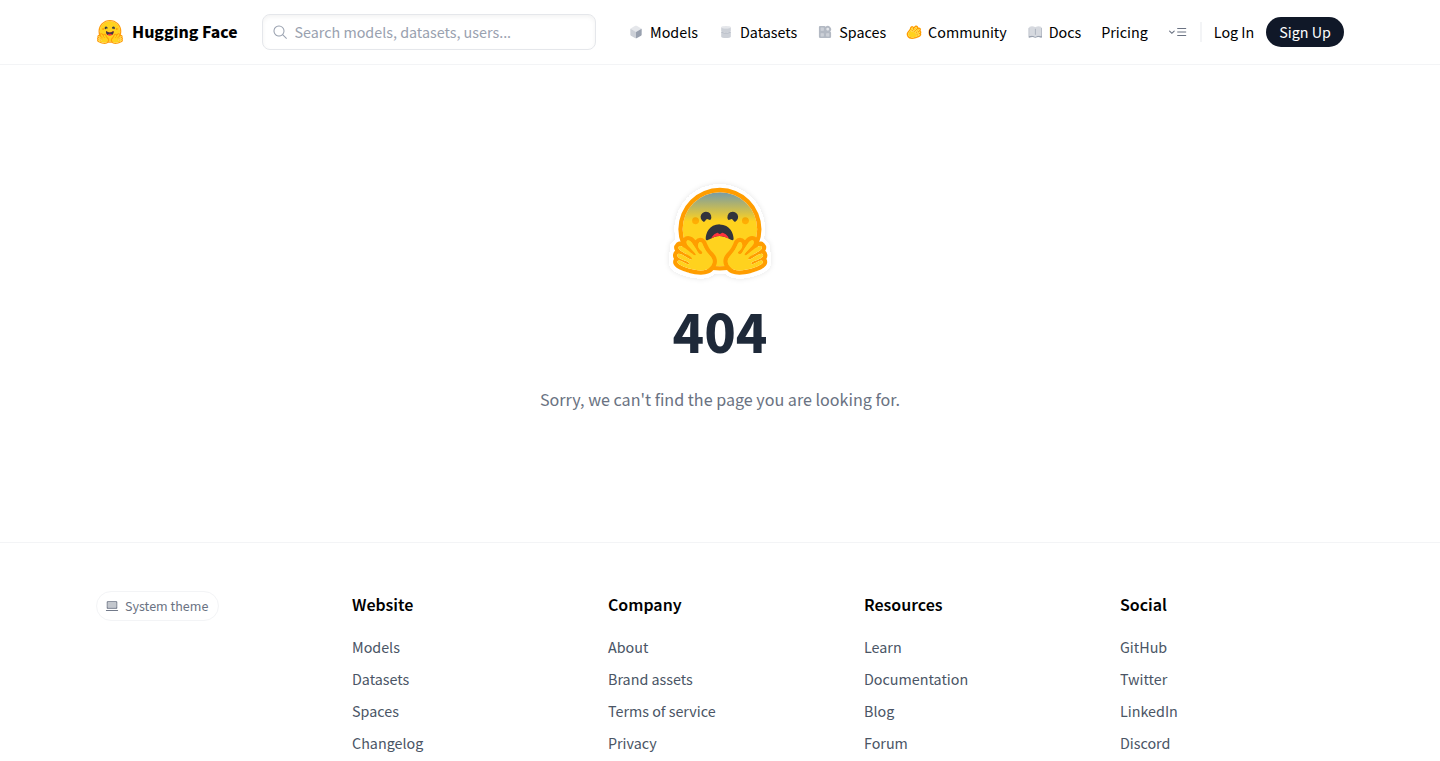
Author
dclavijo
Description
Chimera-QxD is a project focused on running large language models (LLMs) more efficiently, especially on devices with limited memory and processing power. It achieves this through two main techniques: quantization and Mixture-of-Modules (MoM). Quantization reduces the memory footprint of the model by using fewer bits to represent its parameters, making it smaller and faster. MoM allows the model to activate only specific parts (modules) based on the input, reducing the computational load. This combination allows running a 1.5B parameter model (Qwen2-l22_28) on resource-constrained hardware, enabling more accessible and faster inference.
Popularity
Points 2
Comments 0
What is this product?
Chimera-QxD is a system that makes large language models run faster and use less memory. Think of it like this: a regular LLM is a huge, complex book. Quantization is like summarizing the book to make it smaller, and MoM is like only reading the chapters that are relevant to your question. It uses a technique called quantization to compress the model and Mixture-of-Modules (MoM) to activate only necessary parts, resulting in faster and more efficient processing. So, this allows you to run powerful language models even on your phone or older computers. So, this is great for developers looking to integrate LLMs into applications that need to be lightweight and fast.
How to use it?
Developers can integrate Chimera-QxD by first loading the quantized model (in this case, Qwen2-l22_28 with 1.5B parameters) using the provided code and inference library. Then, they can input text prompts, and the system will process them using the optimized model. The project may provide tools and scripts to perform quantization and MoM configuration. The use case is deploying LLMs in edge devices or applications that require faster response times and reduced resource usage. So, this allows you to create applications that can understand and respond to user input quickly, even on devices with limited resources.
Product Core Function
· Quantization: This reduces the size of the model by compressing its parameters. The value is smaller model sizes lead to faster inference and lower memory usage. This is useful for deploying LLMs on devices with limited storage and processing power.
· Mixture-of-Modules (MoM): MoM allows activation of only a subset of the model's components based on the input data. The value is reduced computational cost, leading to faster processing times. This is particularly useful for tasks where only certain parts of the model are relevant.
· Model Optimization: The project focuses on optimizing the Qwen2-l22_28 model for these techniques. The value is the ability to run a large language model, which normally requires significant hardware, on less powerful devices. This opens doors for new applications where LLMs could not be deployed before.
· Inference Library: Provides the necessary tools to run the optimized model. The value is ease of use and faster model deployment. Developers can focus on application logic instead of low-level model optimization.
Product Usage Case
· Mobile App Development: Integrating the optimized model into a mobile application that provides text generation or question-answering capabilities. This allows the app to run smoothly on user's smartphones without needing to connect to a remote server for LLM processing.
· Edge Computing: Deploying the model on edge devices like smart speakers or industrial robots. The model can process voice commands or respond to queries locally, providing real-time responses without relying on cloud connectivity.
· Resource-Constrained Environments: Use in environments with limited computational resources, such as research projects or educational tools, making LLMs more accessible for these use cases. For example, a language learning app running on an old laptop can still provide interactive lessons.
31
OpenCode VSCode Integration: Seamless Code Exploration
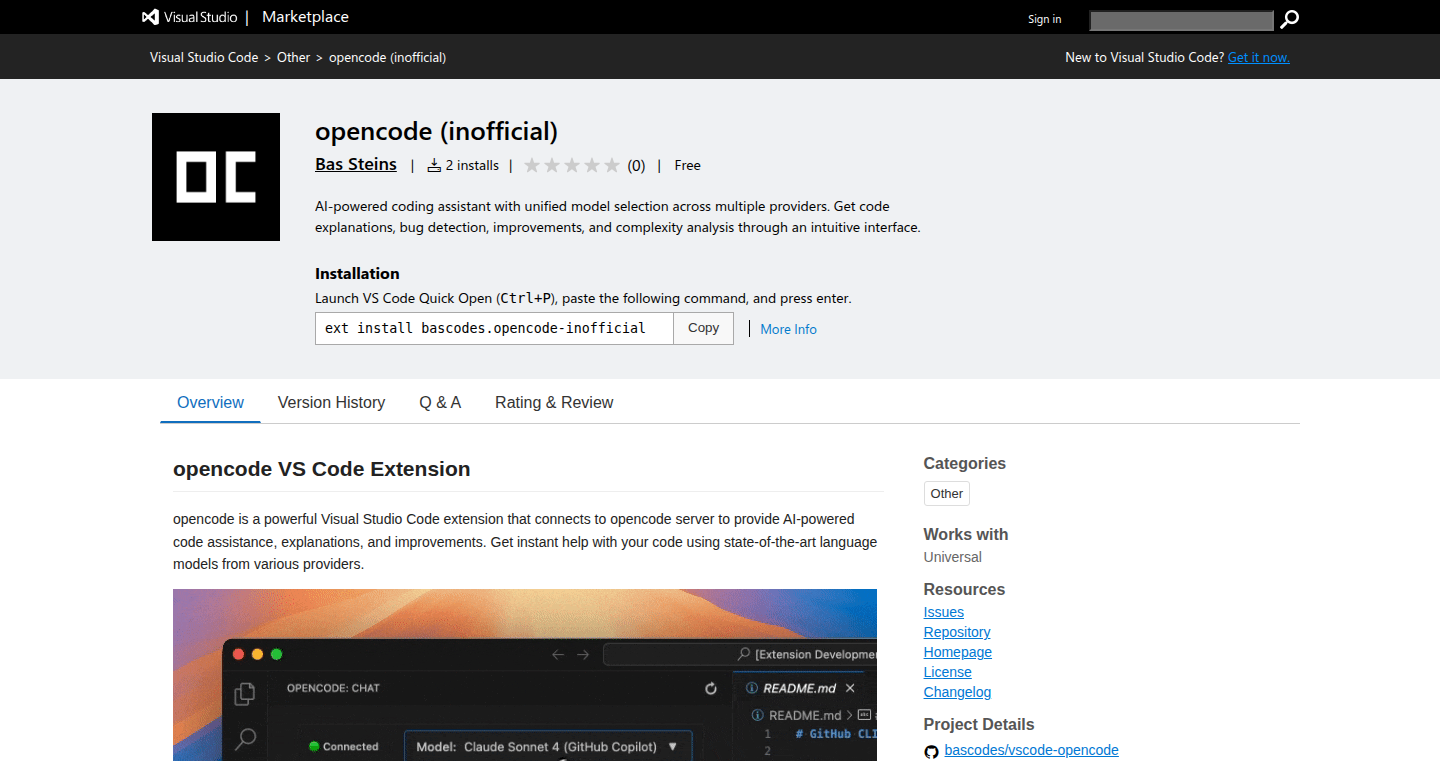
Author
sebst
Description
This project integrates OpenCode, a code search and analysis platform, directly into VSCode. It allows developers to quickly search and understand code from various projects, accelerating the development process. The core innovation lies in providing contextual code understanding within the familiar VSCode environment, addressing the challenge of navigating large and complex codebases without leaving the editor.
Popularity
Points 2
Comments 0
What is this product?
This is a VSCode extension that brings the power of OpenCode's code search and analysis capabilities directly into your code editor. Imagine being able to search across multiple code repositories, understand function calls, and explore code relationships without switching applications. It uses advanced indexing and search algorithms to help you quickly find and understand the code you need. This helps you understand the code's dependencies and how different parts of the code interact with each other.
How to use it?
Developers install the extension in VSCode. Once installed, they can use it to search for code, analyze code structures, and explore dependencies, all within the VSCode interface. Developers can search by keywords, function names, or code snippets. It integrates directly into your workflow so you don't have to jump between different tools.
Product Core Function
· Integrated Code Search: Allows developers to search code across projects and repositories directly within VSCode. This is valuable because it saves time and effort by eliminating the need to switch between different tools or browser tabs. So this saves you time and keeps you focused.
· Contextual Code Understanding: Provides insights into function calls, dependencies, and code relationships. This helps developers understand how different parts of the code interact, making it easier to debug and maintain the code. So you can easily understand how the code works.
· Rapid Code Exploration: Enables quick navigation through large and complex codebases. Developers can jump to function definitions, understand where a variable is used, and explore related code snippets. It helps speed up the development process. So this lets you explore large projects more efficiently.
· Enhanced Code Analysis: Helps developers identify potential code issues, such as unused variables or outdated dependencies. This enhances code quality and makes it easier to maintain your code over time. So this helps you improve your code.
Product Usage Case
· Large Project Navigation: A developer working on a large open-source project can quickly find where a specific function is defined and used, understanding its dependencies and interactions with other parts of the codebase. This facilitates easier navigation of the code. So you can easily get around complex code projects.
· Code Debugging: A developer debugging a software system can use the extension to understand how a variable is used and identify potential issues in its interaction. This speeds up the debugging process. So you can fix bugs faster.
· Code Review: A developer reviewing code from a team member can quickly understand code relationships, identify potential issues, and provide more informed feedback. This improves code quality and team collaboration. So you can better understand code reviews.
· Learning New Codebases: A new developer on a project can use the extension to quickly understand the structure and organization of the codebase, as well as how different components interact. This accelerates the learning curve. So it helps you quickly get up to speed on a new project.
32
NoteSpark: AI-Powered Study Companion
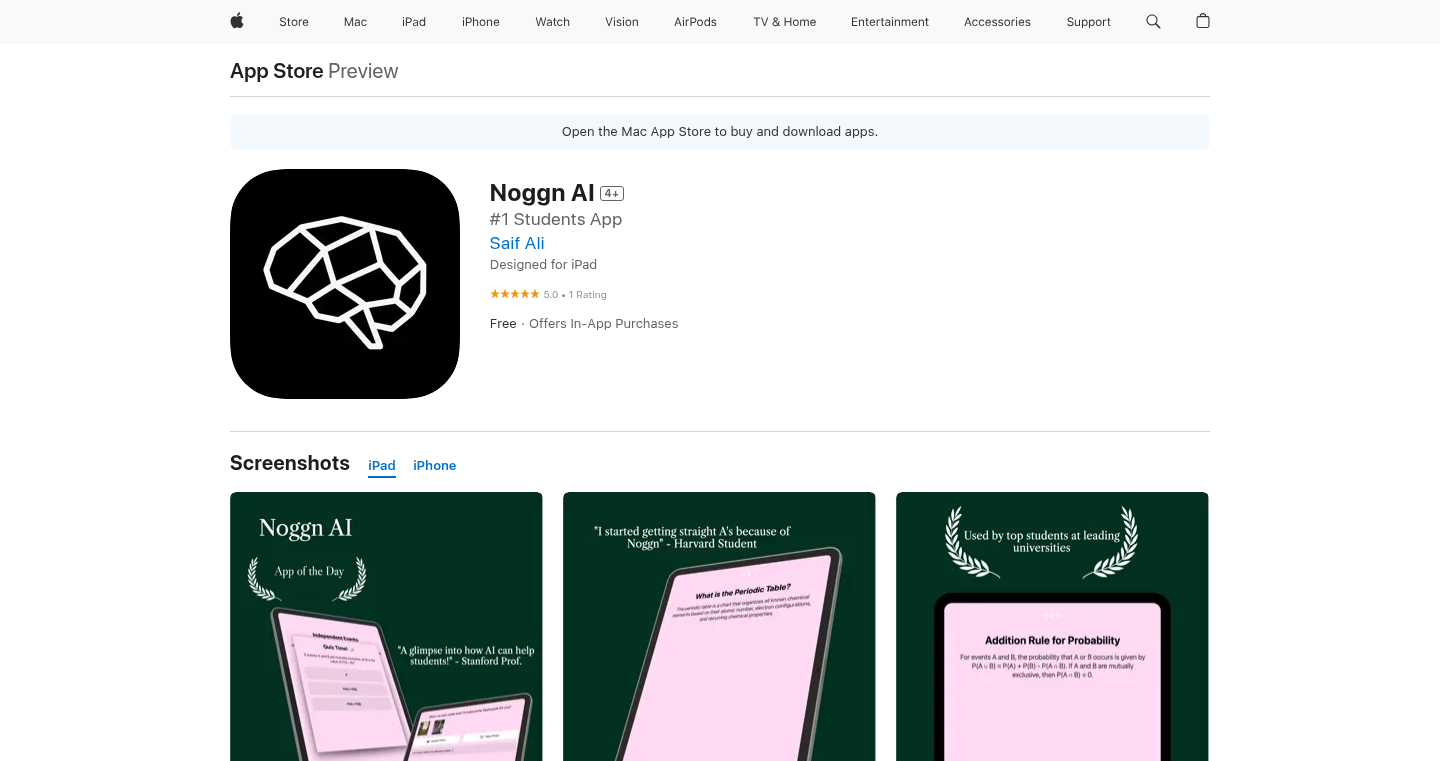
Author
iboshidev
Description
NoteSpark is a study application that transforms your notes (images or text) into flashcards and quizzes, leveraging the power of GPT-4o. It aims to solve the problem of inefficient study habits by automating the creation of learning materials from raw notes. The core innovation lies in its AI-driven note analysis and content generation, allowing users to quickly create study aids. So this automates the tedious process of creating flashcards and quizzes, saving you time and effort.
Popularity
Points 2
Comments 0
What is this product?
NoteSpark uses advanced AI (GPT-4o) to understand your notes, whether they're images of handwritten text or typed notes. It then intelligently generates flashcards and quizzes based on the content. Think of it as having a personal study assistant that automatically creates study materials for you. The innovative part is using AI to understand and process information, making the learning process more efficient and targeted. So, it's like having a smart study buddy that does the hard work for you.
How to use it?
To use NoteSpark, you'd typically upload images of your notes or paste text into the app. The AI engine will analyze the content and generate flashcards and quizzes. The app is intended to be used by students of any level. You might integrate this into your existing study routine or use it to quickly review lecture notes. This means it simplifies the preparation for any test or exams.
Product Core Function
· AI-Powered Note Analysis: The core function is analyzing input notes (images or text) using GPT-4o. This allows it to understand the content, identify key concepts, and build a structure suitable for creating flashcards and quizzes. This is valuable because it saves students from manually reading, understanding, and preparing study materials.
· Automated Flashcard Generation: Automatically creates flashcards from your notes. This involves extracting important information and generating question-answer pairs. Flashcards make it easy to quickly review key concepts. It can dramatically speed up study time by eliminating the need to create flashcards manually.
· Quiz Generation: Generates quizzes to test your understanding. These quizzes help you reinforce your knowledge and identify areas where you need more practice. Quizzes help you assess your comprehension, which ensures that you master the learning materials effectively.
· Image and Text Input Support: The app accepts both image-based notes and text-based notes. This flexibility caters to a wider range of users, allowing them to use the app regardless of how they take notes. This allows for diverse note-taking styles, and you can use the app even if you use handwritten notes.
Product Usage Case
· For students preparing for exams: Upload lecture notes from class as images. NoteSpark turns these into flashcards and quizzes for quick review before the exam, saving hours of manual work. So, if you have a tough exam, this is a great way to reduce study time.
· For language learners: Input vocabulary lists or grammar notes into the app. The app can generate flashcards and quizzes to help in memorization and understanding of the language. This helps you create an interactive learning experience which is more effective than traditional memorization.
· For those who want to reinforce concepts in any subject: Copy and paste textbook chapters into the app, generating quizzes and flashcards to review the content quickly. This helps you reinforce the ideas in the textbook effectively.
· For professionals studying for certifications: Use it to process notes and create flashcards and quizzes to prepare for the certification exams efficiently. This will help to streamline the studying experience.
33
Project 5QL: Reimagining SQL Interactions
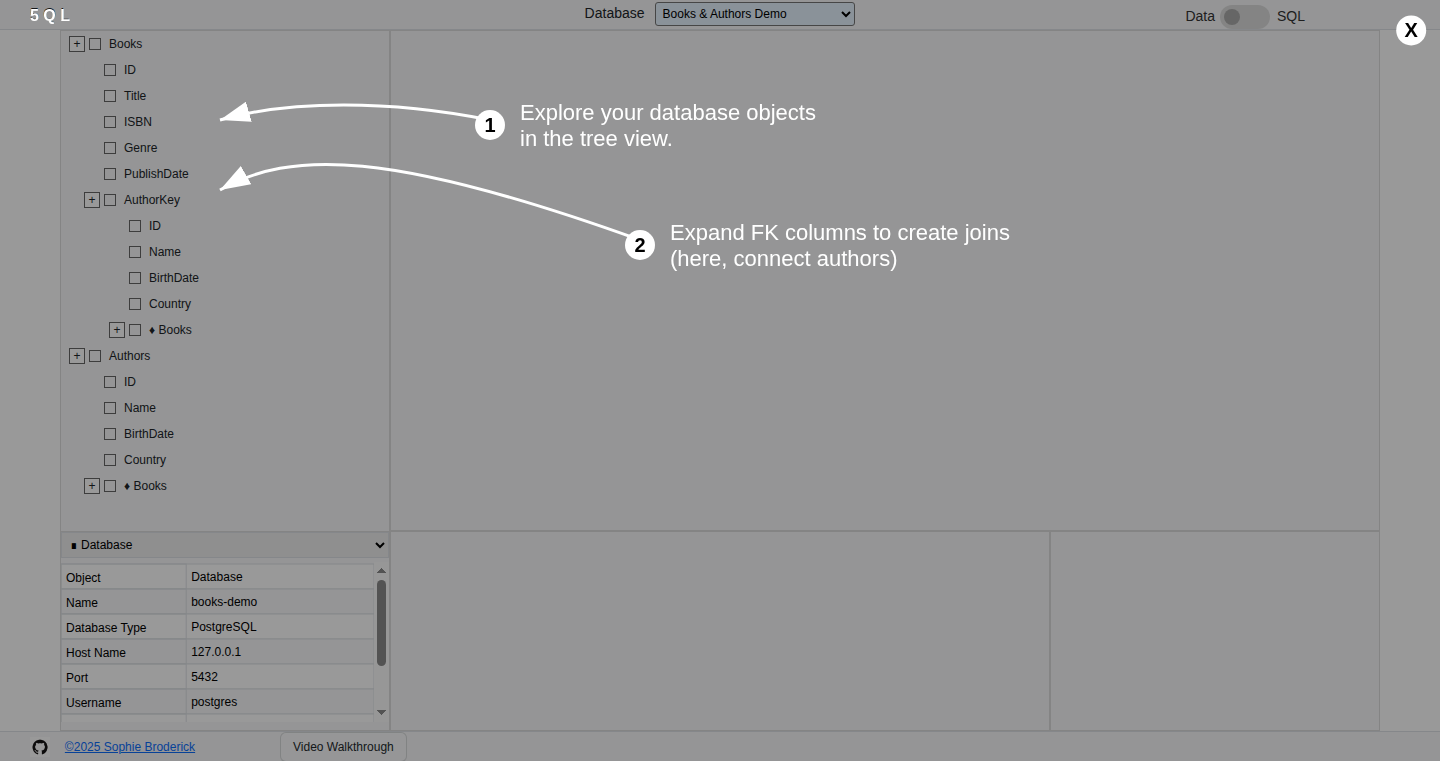
url
Author
SophieBroderick
Description
Project 5QL offers a novel approach to interacting with SQL databases, aiming to simplify and streamline the process. It moves beyond traditional SQL query writing, focusing on a more intuitive and potentially automated way of database interaction. This could involve natural language processing to translate user requests into SQL, or a more visual interface for query building. The innovation lies in abstracting away the complexities of SQL syntax, making database management more accessible to a wider audience, even those without extensive SQL knowledge. This project tackles the challenge of SQL query complexity and the steep learning curve associated with it.
Popularity
Points 2
Comments 0
What is this product?
Project 5QL is essentially a new way to talk to your database. Instead of writing complex SQL queries, it aims to let you interact with your data in a simpler manner. The core innovation here is the potential use of technologies like natural language processing (think of it as talking to your database) or a visual query builder (think of drawing the query instead of typing it). So this helps people who aren't database experts to get the information they need. So this project is valuable because it provides a new way to access and manage database information.
How to use it?
Developers could use Project 5QL in various ways. For example, they could integrate it into an application to allow users to query the database using plain English. They might use it as a tool to speed up their own database interactions, avoiding the need to manually write and debug SQL queries. Integration could involve calling an API or utilizing a library that translates simpler instructions into the appropriate SQL commands. The value for developers is that it could save them time and effort when working with databases, especially in applications where end-users need direct access to data. So this helps developers to create more intuitive, user-friendly applications and streamline database interaction.
Product Core Function
· Automated Query Generation: The core function is likely the ability to generate SQL queries automatically, either based on user input (like natural language questions) or through a visual interface. Value: Dramatically reduces the time and effort required to write and debug SQL queries. Application: In applications where users need to query data on the fly, or when you're dealing with a lot of complex data retrieval.
· Simplified Data Retrieval: Provides an easier method to retrieve data, allowing users to focus on the information they want instead of the technicalities of SQL syntax. Value: Makes data access easier and accessible to non-technical users. Application: Building dashboards, reports, or other applications that rely on data visualization and quick information retrieval.
· Abstraction of Database Complexity: Shielding users from the intricacies of SQL, promoting a more intuitive approach to database interaction. Value: Broadens the user base capable of accessing and manipulating database information. Application: Creating internal tools for data analysis, allowing non-technical teams to make data-driven decisions.
Product Usage Case
· Building a Customer Relationship Management (CRM) system. Using Project 5QL, developers could create a front-end that allows sales teams to query customer data in natural language, such as 'Show me all customers in California who purchased over $10,000 last year.' So this means employees without database knowledge could get their answers faster and more easily.
· Creating data visualization dashboards. Developers could use Project 5QL to build interactive dashboards that let users explore data by simply asking questions. So the process of generating charts and reports becomes much simpler and more dynamic.
· Developing internal data analysis tools. Data analysts could employ Project 5QL to rapidly experiment with different queries and find insights, instead of being slowed down by the need to repeatedly write and debug SQL code. So it accelerates the speed of data exploration and discovery.
34
AutoShorts: The AI-Powered Viral Video Generator

Author
pekingzcc
Description
AutoShorts is a fascinating project that automatically creates short, viral-style videos from a given video input, all with a single click and without requiring any text prompts. It tackles the challenge of automating video content creation, a time-consuming process, by leveraging advanced AI techniques. This includes automatic scene detection, smart content selection, and optimized video editing for platforms like TikTok and YouTube Shorts. It demonstrates an innovative approach to content repurposing and democratizes video production, making it accessible to creators of all technical backgrounds. So, what's the big deal? It saves creators tons of time and effort in producing engaging video content.
Popularity
Points 1
Comments 1
What is this product?
AutoShorts uses artificial intelligence to analyze a source video, identify the most engaging segments, and then automatically edit them into short, attention-grabbing videos. The innovation lies in its 'no-prompt' approach, meaning users don't need to write any descriptions or instructions. The AI does all the work. It understands the video content, chooses the best parts, and then formats the video for popular short-form video platforms. Its key technology includes computer vision for scene analysis, natural language processing for content understanding, and automated video editing algorithms. So, what's in it for you? It's a one-stop solution to turn long videos into engaging short videos in an instant, effectively repurposing existing content.
How to use it?
Developers can use AutoShorts by providing a video file or URL as input. The system then processes the video and outputs a ready-to-upload short video, tailored for platforms like TikTok or YouTube Shorts. The integration is as simple as providing an API endpoint or a web interface. The developer doesn't need any deep understanding of video editing or AI. A practical scenario: a company can automatically generate dozens of short clips from a webinar recording, quickly amplifying its reach. So how does it help? Easily repurposes long-form videos into engaging short-form content.
Product Core Function
· Automated Scene Detection: The system intelligently identifies distinct scenes within the source video, enabling a breakdown of the content into manageable segments. This uses computer vision to analyze the video's visual changes and audio cues. What does it mean? The tool can automatically break down a long lecture into several parts to capture the attention of audience.
· Smart Content Selection: Using AI, the tool selects the most interesting and engaging parts of the video. It analyzes factors like visual impact, audio quality, and audience engagement metrics to select the best snippets for the short videos. So what does it mean to you? Ensures the created videos are more likely to grab the viewer's attention and go viral.
· Automated Video Editing: Once the best segments are selected, AutoShorts automatically edits them together, adds transitions, text overlays, and even music to create polished short videos. It optimizes the video format for different social media platforms. Why does it matter? This takes away the tedious manual work of cutting, trimming, and editing videos.
Product Usage Case
· Educational Content Repurposing: An online course provider uploads a long lecture series. AutoShorts can be used to create numerous short, engaging clips from the lectures, which they can then use to promote the course on social media. This means higher engagement from the audience and increased student enrollment.
· Marketing Content Optimization: A marketing team has a long product demonstration video. They use AutoShorts to create multiple short videos highlighting different product features. The result is higher brand visibility and increased lead generation.
· Personal Content Enhancement: A vlogger has a long travel vlog. AutoShorts can automatically transform the vlog into several fast-paced, exciting short videos to keep audience more engaged and increase the number of views.
35
Framer.zone: A Curated Directory for Framer Resources

Author
yc-azran
Description
Framer.zone is a directory built to help users of the Framer web design tool find high-quality templates, plugins, and tips. It solves the problem of scattered and hard-to-find resources within the Framer ecosystem, providing a centralized and curated hub. The innovation lies in its focus on community-driven content, making it easier for Framer users to discover and share valuable assets, thereby accelerating their project development. So this helps you save time and improve your Framer projects.
Popularity
Points 1
Comments 1
What is this product?
Framer.zone is essentially a search engine and library specifically for resources related to the Framer web design tool. It works by collecting and organizing templates, plugins, tutorials, and other useful materials created by the Framer community. The core technology behind it is likely a combination of web scraping, content curation, and a database for storing and indexing the resources. It is an effort to create a centralized platform. This curation process differentiates it from a generic search, ensuring quality and relevance for users. So this gives you a central place to find the best Framer resources.
How to use it?
Developers and designers using Framer can browse Framer.zone to find templates for specific design needs, plugins to enhance their Framer projects, and tutorials to learn new techniques. Users can submit their own Framer templates, plugins, or guides to the directory, expanding the resource pool. The use case includes directly integrating templates into their projects, using plugins to extend Framer's capabilities, and learning from tutorials to improve their design skills. So this allows you to discover and utilize resources quickly to make your own projects.
Product Core Function
· Template discovery: Allows users to search and find pre-built Framer templates for various website and design projects. This saves time and provides a starting point for rapid prototyping, allowing designers to focus on customization rather than starting from scratch. So this helps you kickstart your design.
· Plugin directory: Provides a catalog of plugins that extend Framer's functionality. These plugins can automate tasks, add advanced features, and improve the overall design workflow. So this gives you extra power to build cool designs.
· Tutorials and guides: Curates tutorials and guides for learning Framer, assisting users in improving their skills and mastering the tool. These resources help users learn new design skills and solve complex design problems. So this helps you learn.
· Community contribution: Allows users to submit their own Framer work (templates, plugins, tutorials) to the platform, promoting a collaborative environment. This benefits the entire Framer community. So this enables sharing and collaboration.
· Curated content: The platform manually reviews and organizes the resources to ensure quality and relevance, which is different from general search. So this brings only the best Framer resources to you.
Product Usage Case
· A web designer needs a landing page template quickly: They can browse Framer.zone, find a suitable template, and customize it to fit their client's brand, saving hours of design work. So this helps you speed up the design process.
· A developer wants to add a dynamic form to a Framer website: They search Framer.zone for a plugin that supports form submission, then integrate the plugin into their project to capture user data, without writing custom code. So this lets you do more without writing code.
· A designer is struggling with a specific Framer feature: They search Framer.zone for tutorials and guides that explain the feature in detail, helping them understand how to use it correctly. So this helps you get unstuck and solve problems.
36
LLM-Powered Code Snippet Performance Benchmark
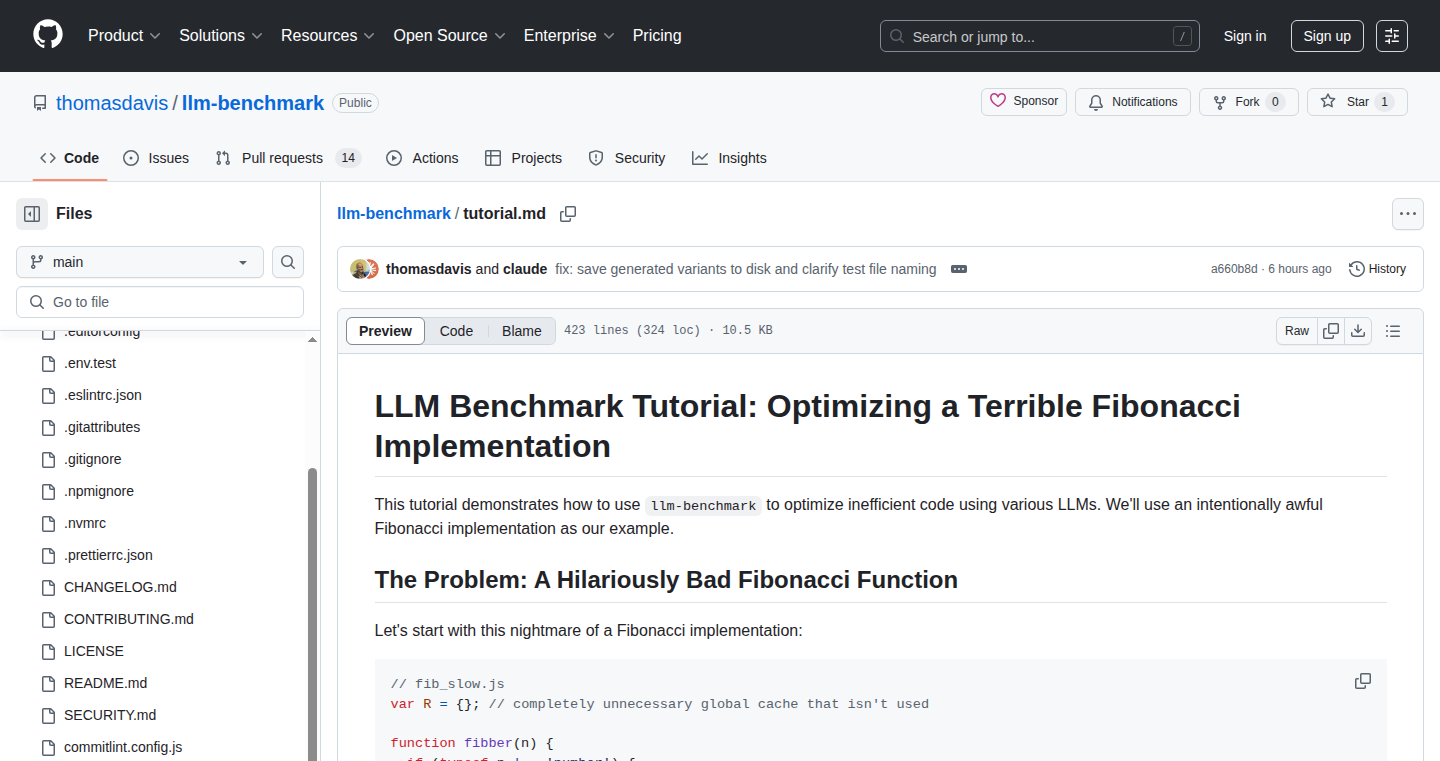
Author
thomasfromcdnjs
Description
This project benchmarks the performance of code snippets by leveraging the power of multiple Large Language Models (LLMs). It allows developers to compare and analyze the execution speed and efficiency of different code implementations, particularly focusing on potential performance improvements. The core innovation lies in automating performance testing across various LLM-generated code variations, providing data-driven insights for optimization. It solves the problem of manually comparing code performance, which can be time-consuming and subjective.
Popularity
Points 1
Comments 1
What is this product?
This project is a tool that uses multiple LLMs to automatically test and compare the performance of different versions of code snippets. It's like having multiple expert code reviewers, each offering a different approach to the same problem. The project measures how quickly and efficiently each code snippet runs, helping developers identify faster and better-performing solutions. The core innovation is the use of LLMs to generate variations of code and then benchmark them, automating a previously manual process.
How to use it?
Developers can provide a code snippet and the project will generate alternative versions using multiple LLMs. It then runs performance tests (like measuring execution time) on each version. The results, including performance metrics and potential optimizations, are presented in an easy-to-understand format. You could integrate this into your CI/CD pipeline to automatically compare code snippet performance on every commit.
Product Core Function
· Code Generation with Multiple LLMs: The system uses different LLMs (e.g., GPT models) to generate multiple versions of a given code snippet. This allows for exploring different approaches to the same problem. So what? This provides a wider range of potential solutions and uncovers optimizations you might not have thought of.
· Automated Performance Testing: The tool runs performance tests on each generated code snippet. This could include measuring execution time, memory usage, or other relevant metrics. So what? This removes the need for manual testing, saving time and ensuring consistent measurements.
· Comparative Analysis and Reporting: The results are compiled into a comparative report, highlighting the performance differences between the code snippets. This includes visualizations, ranking, and suggestions for optimization. So what? This helps you quickly identify the most efficient code and understand the trade-offs between different solutions.
· Integration with Existing Workflows: The project can potentially be integrated into existing development workflows, such as CI/CD pipelines, allowing for automatic performance testing with every code change. So what? This ensures that performance is continuously monitored and optimized throughout the development process.
Product Usage Case
· Optimizing Web Application Code: Imagine you're building a web application and want to optimize a critical function. You can use this tool to generate and benchmark different versions of the function, finding the fastest and most efficient implementation. So what? This improves the user experience by reducing loading times and increasing responsiveness.
· Benchmarking Database Queries: If you're working with databases, this tool can help you compare different query methods for speed and efficiency. So what? This leads to faster data retrieval and reduced server load.
· Improving Code Efficiency in Scientific Computing: Scientists and researchers often use code snippets for complex calculations. This tool helps them find more performant code, accelerating their research and improving accuracy. So what? This can significantly reduce computational time and cost.
37
CS2 Crosshair DailyUpdater: A Dynamic Crosshair Database
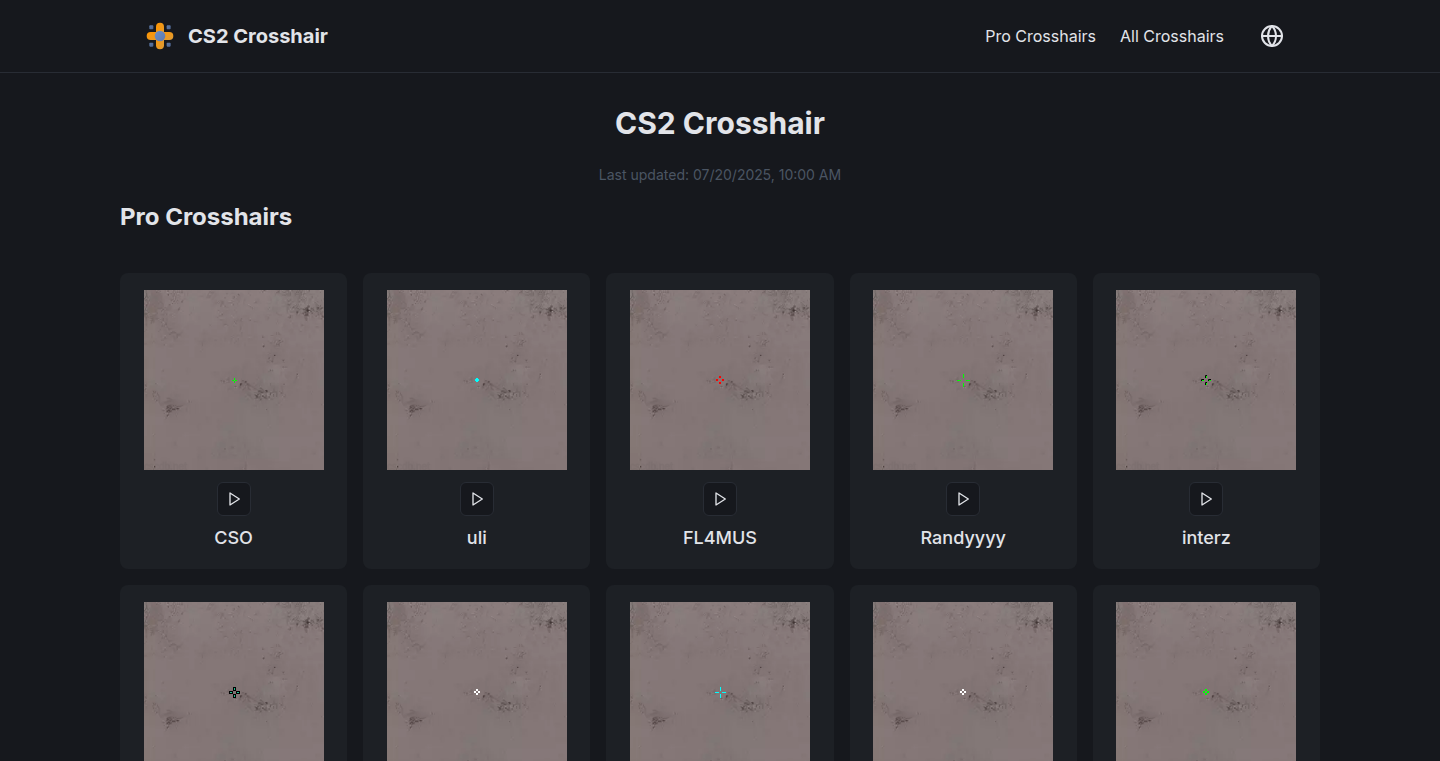
Author
valorantPanda
Description
This project is a daily-updating database for Counter-Strike 2 (CS2) crosshairs. It automatically scrapes and analyzes crosshair configurations from various sources, providing a constantly refreshed library for players. The core innovation lies in its automated data aggregation and validation, saving players the hassle of manually searching and testing crosshair settings. It tackles the problem of outdated or ineffective crosshairs by ensuring users have access to the latest and most popular configurations.
Popularity
Points 1
Comments 0
What is this product?
This project builds a database of crosshairs for the game CS2. It's like a constantly updated catalog. The cool part is that it automatically gathers information (like crosshair settings) from different places online. It then cleans up and organizes this information, so players can easily find and use the best crosshairs. So what? This means you get the latest, most effective crosshairs without having to search for them yourself.
How to use it?
Developers can use this project in several ways. For example, they could integrate the database into their own CS2 tools or websites. This allows them to offer their users a constantly updated source of crosshair configurations. They might also use the scraping and data-processing techniques to build similar databases for other games or applications that require data aggregation from multiple sources. So what? This allows you to build a helpful resource for CS2 players or apply the same principles to solve data-gathering problems in other areas.
Product Core Function
· Automated Web Scraping: This function automatically extracts crosshair data from various online sources. Value: It removes the need for manual data entry, saving time and reducing the risk of errors. Application: It allows developers to quickly collect large amounts of data from the internet.
· Data Validation and Cleaning: This function checks the scraped crosshair data for accuracy and consistency, fixing any errors. Value: Ensures the quality and reliability of the data. Application: Prevents errors and makes the database more trustworthy for users.
· Daily Updates: The database is refreshed daily, guaranteeing the most current crosshair settings are available. Value: Provides users with the latest and most effective crosshair configurations. Application: Keeps the information fresh and relevant, providing an advantage to CS2 players.
· Crosshair Parameter Parsing: This function breaks down the crosshair settings into individual components (color, thickness, style, etc.). Value: Enables users to easily customize and filter crosshairs based on their preferences. Application: Makes it easy to search for crosshairs with specific characteristics.
Product Usage Case
· A game enthusiast creates a website for CS2 players. They integrate the crosshair database into their website, offering a regularly updated list of crosshairs with one-click import capabilities. So what? Players get the latest and greatest crosshairs directly, improving their in-game performance.
· A developer builds a CS2 training tool. They use the database to allow users to simulate different crosshair styles, helping them learn and practice with various configurations. So what? Players can experiment with and improve their aim more effectively.
· A data scientist analyzes crosshair popularity trends. They utilize the database to identify the most popular crosshair configurations and their performance impact over time. So what? They gather insights into the meta of the game, which is very useful for competitive play.
38
Compass CNC: Open-Source Handheld CNC Router

Author
camchaney
Description
Compass CNC is an open-source, handheld CNC router that combines computer precision with the tactile experience of woodworking. It uses optical flow sensors and a 3-axis motion system to provide real-time robotic assistance, correcting for precise cuts. Unlike traditional CNC machines, Compass CNC is affordable, portable, and doesn't require external markers. It’s designed to make computer-controlled machining more accessible and enjoyable for makers. So this is useful because it makes creating intricate designs in wood easier and more accessible for both beginners and experienced woodworkers.
Popularity
Points 1
Comments 0
What is this product?
Compass CNC is a handheld CNC router that brings computer precision to woodworking. It utilizes optical flow sensors, similar to those found in computer mice, to track its position and a 3-axis motion system for precise cuts. The system continuously adjusts the router's movements based on the design path, ensuring accuracy. The open-source nature of Compass CNC allows users to access all plans, firmware, and CAD files on GitHub, fostering customization and community involvement. So this is a useful tool for anyone wanting precise woodworking, with a focus on DIY building and customization.
How to use it?
Developers can use Compass CNC by building their own from open-source plans or purchasing a pre-order kit. They can integrate it into their woodworking projects by creating or importing designs and using the handheld router to follow the design path. The system’s real-time robotic assistance then auto-corrects for precision. The GitHub repository provides resources for customization, allowing developers to adapt the machine to their specific needs. So this means developers get a high-precision tool they can modify to meet their particular needs.
Product Core Function
· Handheld Routing with Robotic Assistance: The core function of Compass CNC is to provide robotic assistance while the user manually guides the router. It uses sensors and motion control to ensure precision while offering a hands-on experience. This is useful for anyone looking to create complex and accurate cuts without relying solely on automated systems.
· Optical Flow Sensing for Positioning: This system uses optical flow sensors, similar to those in computer mice, to track the router's position. This eliminates the need for external markers or complicated setup procedures. It is useful because it simplifies the process of using the CNC router, making it accessible to a wider audience.
· 3-Axis Motion System: The 3-axis motion system controls the movement of the router in three dimensions, enabling complex cuts and designs. The system allows for precision control and accurate reproduction of designs. This is useful for creating intricate details and patterns in woodworking projects.
· Open-Source Design and Customization: Compass CNC is completely open-source, meaning all designs, firmware, and CAD files are available for download and modification. Users can customize the machine to meet their specific needs, adding features or adapting it for different materials. This is useful because it gives users the freedom to adapt and enhance the tool.
Product Usage Case
· Custom Furniture Making: A woodworker can use Compass CNC to create intricate designs and joinery on custom furniture pieces, ensuring precision and consistency. This can solve the problem of inaccurate hand-cutting and reduces the time required for complex tasks.
· DIY Projects and Hobbyists: Hobbyists building custom projects like intricate wooden boxes or decorative panels can benefit from the accuracy and ease of use provided by Compass CNC. This solves the problem of achieving professional-looking results with more accessible tools.
· Educational Purposes and Training: Compass CNC can be used in educational settings to teach students about CNC machining and robotics, making the technology more accessible and hands-on. It solves the issue of high costs associated with traditional CNC machines.
· Prototyping for Makers: Designers and makers can quickly prototype wood components using Compass CNC, allowing them to test designs and refine their work with ease. This solves the problem of long lead times and high costs associated with outsourcing prototyping.
39
JK Search Navigator: Vim-like Chrome Extension for Search Results
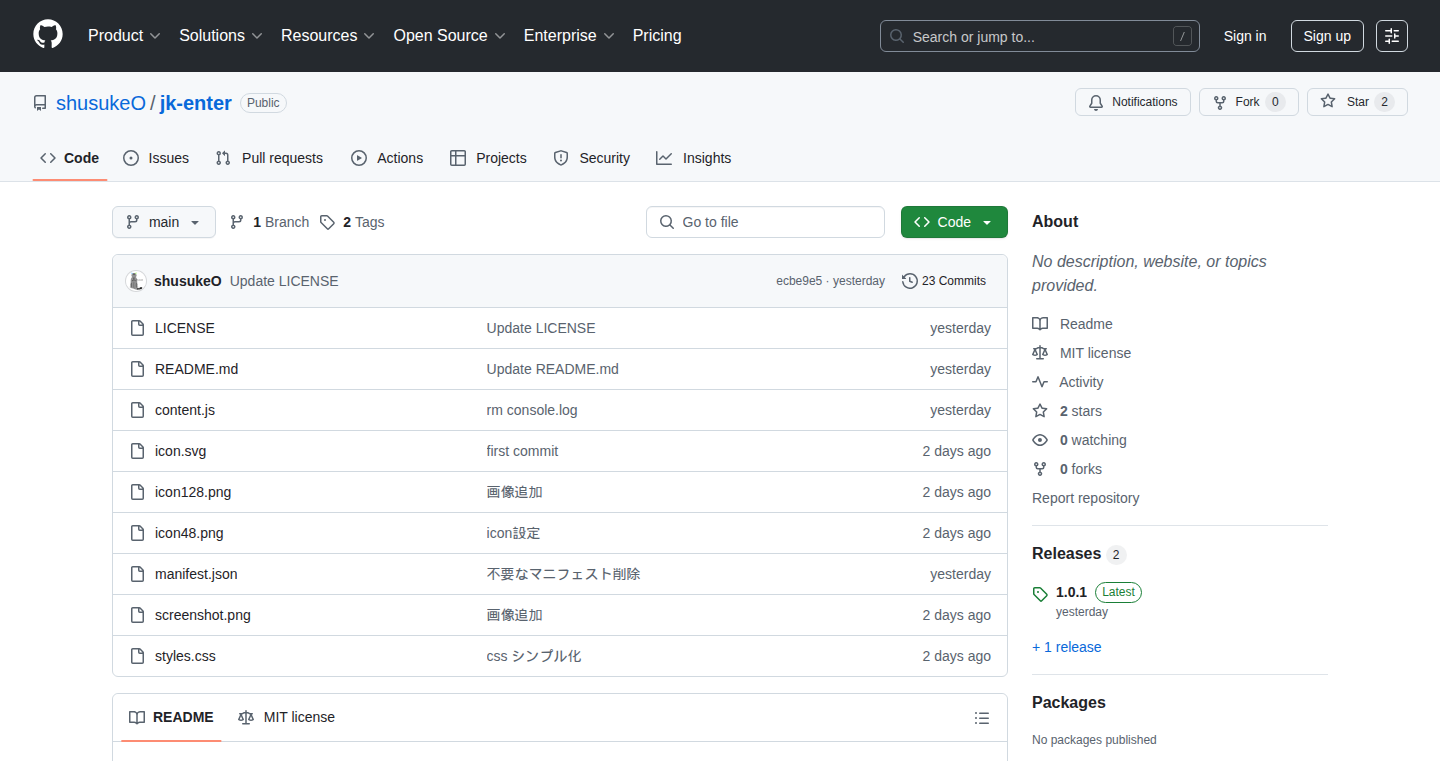
Author
hello_sh
Description
This Chrome extension brings the power of Vim, a popular text editor known for its efficient keyboard navigation, to your Google search results. It allows you to navigate search results using 'j' and 'k' keys (like going down and up) and open a result with 'Enter', saving you from constantly using your mouse. This is a clever solution to the problem of inefficiently navigating search results, especially for users who prefer keyboard-centric workflows. This extension is a testament to the power of user-focused, practical extensions that improve daily browsing.
Popularity
Points 1
Comments 0
What is this product?
This extension takes the keyboard-focused navigation style of Vim and applies it to Google search result pages. When you search something, the extension lets you use 'j' to move down the results, 'k' to move up, and 'Enter' to open a selected result. This is achieved by injecting Javascript code into the Google search page, which listens for these specific key presses and then manipulates the page's display and behavior. The innovation lies in its simplicity and the way it elegantly integrates a powerful keyboard navigation paradigm into everyday web browsing. So what's the big deal? You can navigate search results significantly faster and more efficiently without touching your mouse.
How to use it?
Install the Chrome extension and start searching on Google. After searching, you can immediately use 'j' and 'k' to navigate the search results, and press 'Enter' to open a selected result. This extension works automatically after installation. You don't need to configure anything, just install and start using it. It can be integrated with any Chrome browser, making it a useful tool for researchers, developers, and anyone who frequently uses search engines. So, you don't have to change anything in your workflow, just add the extension and instantly benefit.
Product Core Function
· Keyboard Navigation (j/k keys): The core function is enabling keyboard-based navigation through search results. The technical implementation involves intercepting keystrokes and dynamically highlighting the selected result. This is useful for users who prefer keyboard-centric browsing and want to avoid constant mouse use. So this helps you browse search results hands-free.
· Result Selection (Enter key): Pressing Enter opens the currently selected search result. The technical implementation likely involves identifying the selected link and simulating a click event. This is useful for quickly opening desired search results. So, this feature allows you to open the result quickly and efficiently.
· Auto-Scroll Functionality: This ensures that when moving through results, the selected item is always visible on the screen. This is technically achieved by detecting selection changes and automatically scrolling the page accordingly. This ensures a seamless user experience. So you don't lose track of where you are on the page.
Product Usage Case
· Researchers: Researchers can rapidly navigate through numerous search results to find relevant information. The keyboard-centric approach allows for quicker information gathering and analysis. So, if you are a researcher, this tool can greatly improve your search efficiency.
· Developers: Developers often use search engines to find documentation and solutions. This extension allows developers to efficiently browse and find information within search results without using the mouse. So, developers can accelerate their debugging and research by rapidly finding resources.
· Power Users: Anyone who frequently uses search engines for work or personal use can benefit from faster navigation and a more efficient workflow. It's for anyone who wants to optimize their internet searching. So, if you search a lot, this can save you a lot of time and make your online experience better.
40
VLM in 3D PC: Elevating 3D Perception with Few-Shot Learning
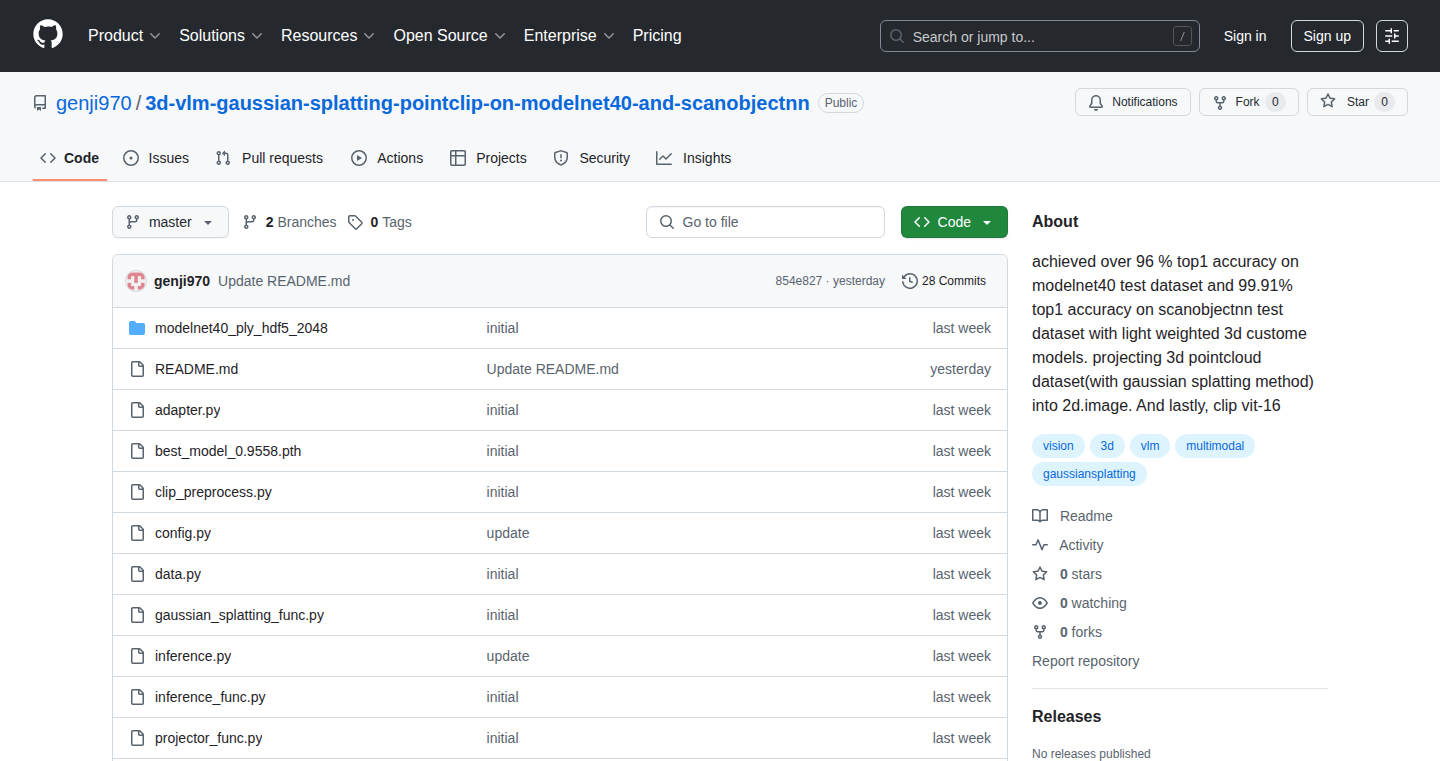
Author
genji970
Description
This project explores the use of Vision-Language Models (VLMs) in processing 3D point clouds, pushing the boundaries of 3D object recognition. It achieves impressive accuracy, especially in scenarios with limited training data (few-shot learning). The core innovation lies in applying VLM, which usually works with images, to 3D point clouds, enabling the model to understand the 3D world based on textual descriptions. This tackles the challenge of accurately identifying and classifying 3D objects, especially when data is scarce, leading to potential breakthroughs in fields like robotics and augmented reality. So this allows us to analyze 3D data in a smarter and more efficient way.
Popularity
Points 1
Comments 0
What is this product?
This project leverages Vision-Language Models (VLMs) - think of them as AI models that can understand both images and text. It adapts these models to analyze 3D point clouds, which are essentially collections of 3D coordinates representing objects. The innovation is in using VLMs to understand the spatial relationships and features in 3D data, achieving impressive accuracy, particularly with limited training data (few-shot learning). For example, instead of requiring thousands of examples of a chair, the model can identify a chair based on just a handful of examples along with the textual description "a chair." So this allows computers to 'see' and understand 3D objects much like humans do, using text to guide the understanding.
How to use it?
Developers can integrate this technology into applications that require 3D object recognition, such as robotics, autonomous vehicles, and augmented reality. The project provides insights into how to adapt VLMs for 3D data. One could potentially fine-tune the pre-trained models with their own 3D datasets and integrate them into their software. This opens the door for creating more intelligent systems that can understand and interact with the 3D world. So this provides a foundation to create applications where machines can see and understand objects in 3D with minimal training data.
Product Core Function
· 3D Object Recognition: Identifying and classifying objects in 3D point clouds with high accuracy. This is valuable for applications like robotics, where a robot needs to recognize and interact with objects in its environment. So this allows robots to accurately identify and interact with objects.
· Few-Shot Learning: The ability to learn from a small number of examples. This is crucial for scenarios where obtaining large labeled datasets is expensive or impractical. This reduces the need for vast amounts of training data. So this lets you train systems to recognize objects with a fraction of the usual data requirement.
· Vision-Language Integration: Using textual descriptions to guide the understanding of 3D data. This allows users to interact with and control the system using natural language, making it more accessible and intuitive. So this makes systems easier to use by allowing human-like language commands.
· Point Cloud Analysis: Analyzing 3D point cloud data for object detection and scene understanding. Useful for areas like 3D modeling and computer vision. So this opens new opportunities for analyzing 3D data for various applications.
Product Usage Case
· Robotics: A robot equipped with this technology can identify and grasp objects in a cluttered environment, even with limited prior knowledge. This significantly improves the robot's ability to interact with its surroundings. So this allows robots to act in unpredictable environments with greater efficiency.
· Augmented Reality (AR): In an AR application, the system could identify specific objects in the real world and overlay digital information on top of them. For example, recognizing a car and providing real-time information about its make and model. So this makes AR experiences more intelligent and context-aware.
· Autonomous Vehicles: The system can be used for environment perception and object detection, such as identifying pedestrians, vehicles, and traffic signs in a 3D environment. This enhances the safety and efficiency of self-driving systems. So this can improve the accuracy of the surrounding detection of self-driving cars.
· 3D Modeling: Used in the creation of 3D models from real-world scans, allowing for the quick and accurate reconstruction of objects and environments. So this significantly simplifies and accelerates the process of creating 3D models.
41
Metaexodus: Production Metabase Migration Utility
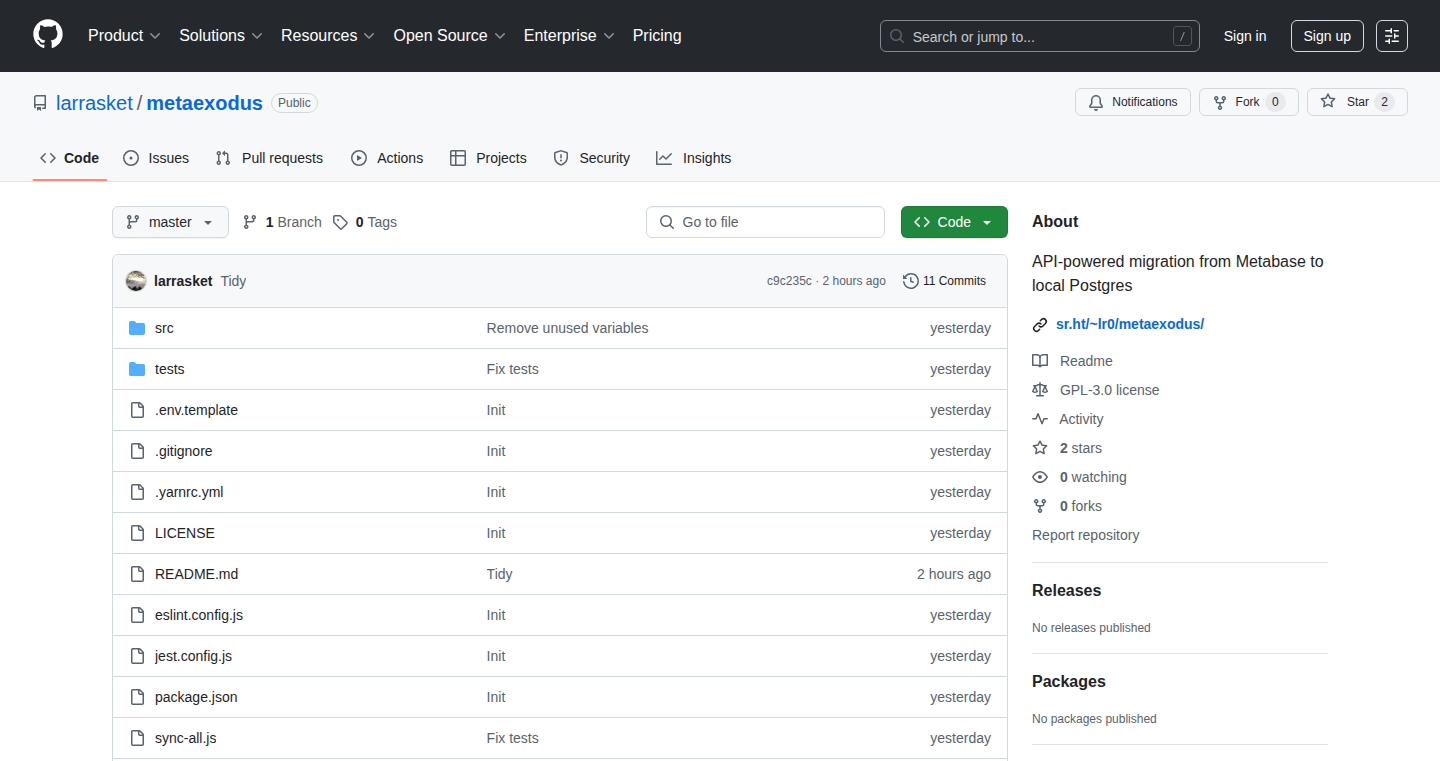
Author
lr0
Description
Metaexodus is a command-line utility designed to smoothly migrate your production Metabase instance to a local PostgreSQL database for development or testing purposes. It simplifies the often complex process of data migration by handling the export, transformation, and import of your Metabase data, including dashboards, questions, and user settings. The technical innovation lies in its automation of this process, reducing manual effort and the potential for errors when setting up a local development environment reflecting your production data.
Popularity
Points 1
Comments 0
What is this product?
Metaexodus automates the process of migrating your Metabase instance. It takes data from your live Metabase (which often uses a cloud-hosted database) and transfers it to a local PostgreSQL database on your computer. This involves several steps: exporting the data, transforming it to fit PostgreSQL's structure, and finally importing it. The innovation is that this process is automated, saving developers from manual data manipulation and potential errors. So what? This allows developers to safely test changes and new features locally, using a realistic copy of their production data.
How to use it?
Developers use Metaexodus through their terminal (command line). They provide the connection details for their production Metabase instance and their local PostgreSQL instance. Metaexodus then handles the data transfer. This is useful in several scenarios, such as when debugging issues, developing new dashboards, or testing Metabase upgrades. By typing a single command, you get a perfect replica of your production data in your local environment for safe experimentation. So what? This simplifies development and testing, allowing developers to work with realistic data without affecting the live production system.
Product Core Function
· Data Export from Production Metabase: This functionality extracts all relevant data from your live Metabase instance. This is often the first and most critical step. Application: It's used to capture all dashboards, questions, and settings for the migration. So what? Provides the foundation for a complete, local copy of your data.
· Data Transformation for PostgreSQL Compatibility: The utility adjusts the data structure to align with PostgreSQL's requirements. This includes converting data types and ensuring compatibility. Application: Necessary to make the data fit correctly into the local PostgreSQL database. So what? Ensures the data imported correctly into a local database.
· Data Import into Local PostgreSQL: This function loads the transformed data into your local PostgreSQL instance, creating a local replica. Application: Allows developers to have a copy of the production data on their local machine for testing and development. So what? Enables developers to test new features safely.
· Command-Line Interface (CLI): Offers a simple way for developers to initiate and manage the migration process through the terminal. Application: Makes the tool user-friendly and easy to integrate into development workflows. So what? Enables quick and easy data migration with minimal setup.
Product Usage Case
· Testing New Dashboard Features: A developer can migrate their production Metabase data to their local machine, then test how new dashboard features render with real-world data, ensuring that the features behave correctly before deployment. So what? Guarantees the reliability of new dashboard enhancements.
· Debugging Production Issues: When a bug occurs in the production environment, developers can migrate a snapshot of the production data locally, replicate the issue, and debug it without affecting live users. So what? Enables quick and efficient bug fixing.
· Developing New Metabase Questions: A developer can create and test new questions and data exploration queries locally, using real data from their production system. This reduces the risk of errors in the production environment. So what? Facilitates safe data analysis and query development.
· Evaluating Metabase Upgrades: Before upgrading the production Metabase instance, developers can migrate the production data locally and test the upgrade to ensure data integrity and functionality compatibility. So what? Minimizes risks associated with software upgrades.
42
Remote Server Sentinel: Daily Top 10 Installations
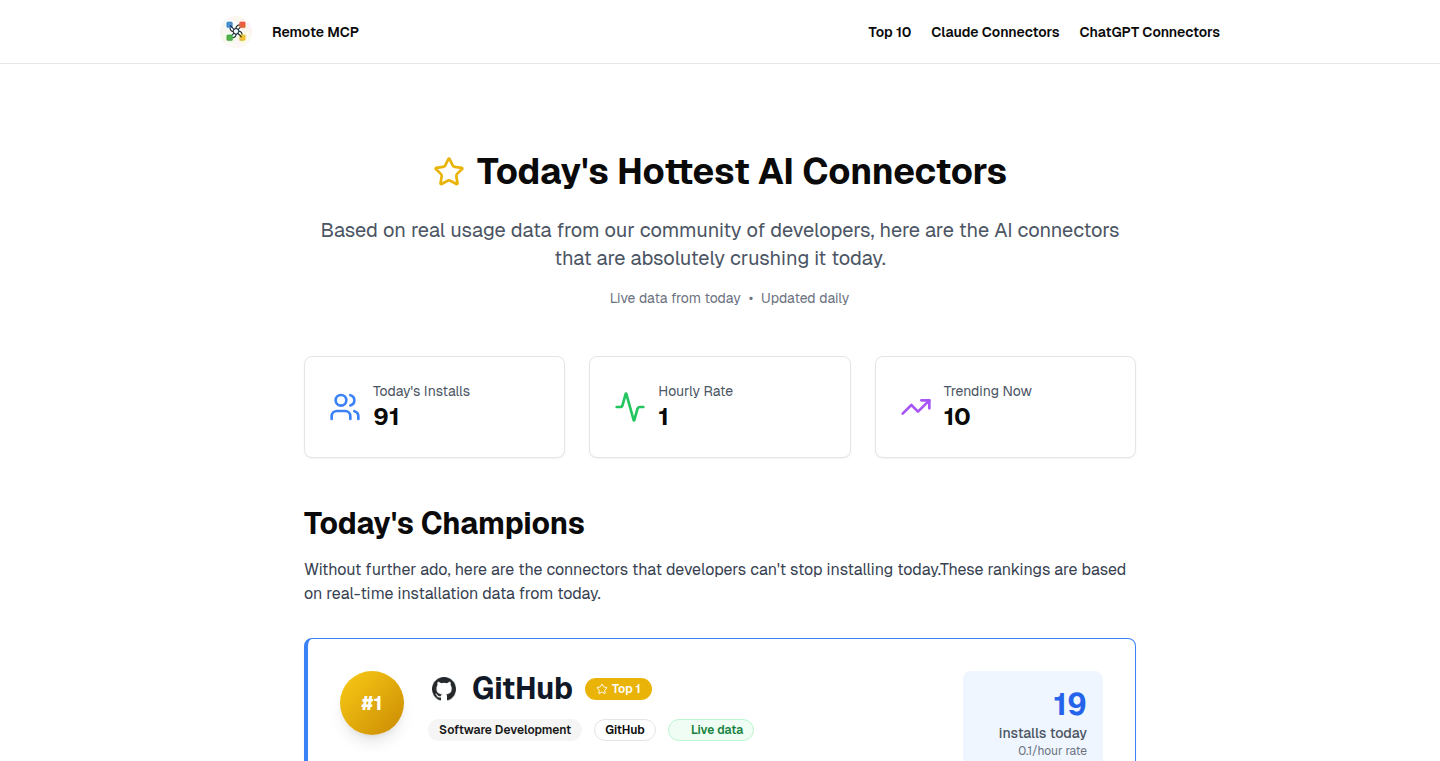
Author
joshwarwick15
Description
This project monitors and identifies the top 10 most installed Remote MCP Servers/AI Connectors each day. It leverages a data aggregation and analysis pipeline to track installation patterns. The technical innovation lies in its automated data collection, real-time analysis, and the ability to identify emerging trends in server and AI connector usage. It solves the problem of gaining visibility into frequently used remote server technologies and AI integrations, providing developers with valuable insights for technology adoption and security assessment.
Popularity
Points 1
Comments 0
What is this product?
This project is like a daily report card for remote server installations. It works by automatically collecting data from various sources about the installation of remote server applications (like Remote MCP Servers or AI Connectors). The core technology involves an automated system that gathers data, analyzes it to find the top 10 most installed servers, and presents this information in an easy-to-understand format. The innovative aspect is its ability to track these installations in real-time, giving a glimpse into what remote server technologies are currently popular. So what? This helps you understand which technologies are trending and how they're being used.
How to use it?
Developers can use this project to get a quick overview of the most popular remote server technologies and AI connectors. This can be very useful for software development, security analysis, or even just staying up-to-date on what's new. The project may offer an API or data feed that can be integrated into existing monitoring tools or dashboards. For example, you might integrate it into a security monitoring system to watch out for potentially vulnerable servers or use the data to benchmark the popularity of your own server solution. So what? You'll have access to a 'pulse' of what's happening with remote servers, without having to manually search for it.
Product Core Function
· Daily Data Aggregation: The project gathers installation data from a variety of sources, such as public registries or usage statistics. This enables a comprehensive view of server technology adoption. So what? This allows you to see a broad picture of trends, rather than just a few isolated examples.
· Real-time Analysis: It processes the collected data in real-time, identifying trends and patterns as they emerge. This provides developers with up-to-the-minute insights into server usage. So what? This provides a timely view of the technology landscape, letting you react to changes promptly.
· Top 10 Identification: The core function is to pinpoint and rank the top 10 most installed remote servers or AI connectors each day. This focuses attention on the most significant and widely used technologies. So what? You can quickly see which technologies are 'hot' and understand their usage patterns.
· Reporting and Visualization: The project probably provides a way to present the top 10 list, possibly through a simple dashboard or API. This ensures that the findings are accessible and easily digestible. So what? The project turns raw data into usable knowledge, making it easy to stay informed.
Product Usage Case
· Security Auditing: A security team can use the project's output to identify the most common remote servers in use. This helps them prioritize their security efforts, focusing on the servers most likely to be targeted by attackers. For instance, if a particular server type is frequently installed and known to have security vulnerabilities, the team can proactively assess the risks. So what? You can proactively assess and address the most critical security threats.
· Technology Adoption: A developer deciding which server technology to adopt for a new project can use the list to assess the current trends. If a particular server is gaining traction, it might be a good choice. Conversely, a declining server might be less attractive. This helps developers make more informed technology choices. So what? You can make better decisions about which server technologies to use for your next project.
· Market Research: Companies developing or offering remote server software can use the project's insights to monitor their competitors' market share and understand overall market dynamics. The data can also inform product development roadmaps. So what? You can get a competitive edge by understanding the broader market trends.
43
Permitta: Simplified Access Control for Go Applications
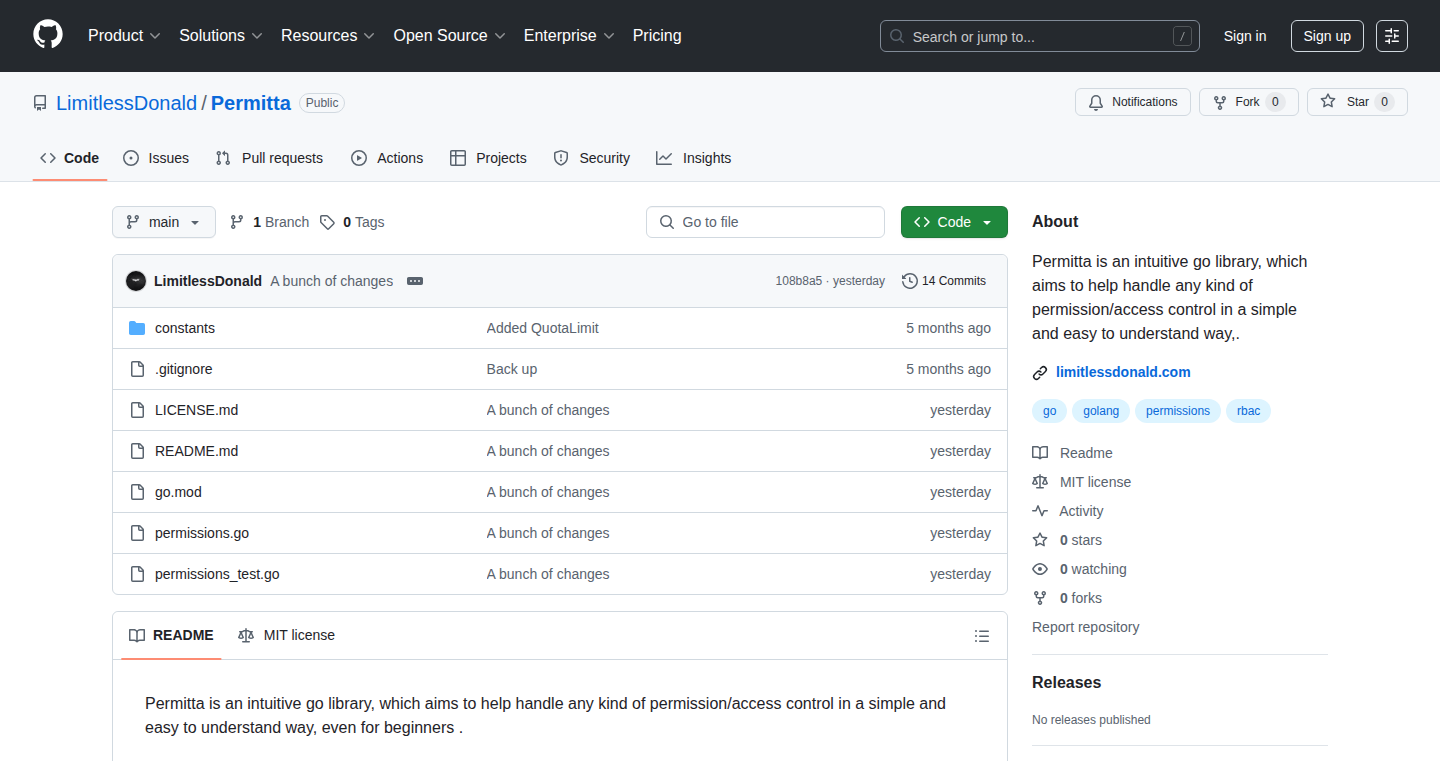
Author
LimitlessDonald
Description
Permitta is a Go library designed to simplify permission and access control management within applications. It provides an intuitive approach to handling complex scenarios, inspired by the Linux permission system, but extended for modern application needs. The library focuses on enabling developers to easily manage create, read, update, delete, and execute (CRUDE) operations with various constraints, such as time-based limits, quotas, and entity-based permissions. The core innovation lies in its user-friendly design, eliminating the need for complex database queries and enabling developers to define intricate permission rules concisely. This simplifies the development process and reduces the potential for security vulnerabilities related to access control.
Popularity
Points 1
Comments 0
What is this product?
Permitta is a Go library that makes it easy to control who can do what in your application. Think of it as a simplified way to manage 'permissions.' It allows you to define rules about what users can create, read, update, delete, or execute (the CRUDE operations) and sets limits on how often they can do those things. It’s inspired by how Linux handles file permissions, but it is adapted for modern application requirements. So, instead of needing complicated code, you can express permission rules in a simple way. The key innovation is its focus on user-friendliness and efficiency, making it easier for both beginners and experienced developers to implement secure access controls.
How to use it?
Developers can integrate Permitta into their Go applications by importing the library and using its functions to define and check permissions. For example, you could set rules that allow a user to update a specific item only a certain number of times per hour. You would define the permission rules in your code, and then, before any user action, your application checks those rules using Permitta. This library is particularly useful for applications that manage user data, require different access levels, or handle sensitive information. You can integrate it into any Go project where you want to control what users can access or do within the application.
Product Core Function
· CRUDE Operations Permissions: The library allows you to define granular permissions for Create, Read, Update, Delete, and Execute actions. This enables fine-grained control over user actions. So this helps you decide what each user is allowed to do, ensuring that only authorized actions are performed.
· Time-Based Limits: Permitta supports setting time-based restrictions on permissions, such as the start and end times for accessing certain resources. Developers can restrict access to resources based on time intervals (e.g., per minute, per hour, per day, etc.) or custom durations. This feature is useful for enforcing time-sensitive rules, like temporary access privileges or scheduled operations. This ensures that access is granted only when needed, enhancing security and control.
· Quota Limits: Permitta allows for setting quota limits on resources, specifying how many instances of a particular resource can exist at any given time. This prevents overuse of resources. So, you can make sure that a user cannot create more than a defined number of something, preventing resource abuse or exceeding service limits.
· Batch Limits: Developers can set batch limits to control how many operations can be performed at once. This feature can mitigate the impact of mass operations. This is helpful for preventing performance issues and ensuring that resources are not overwhelmed by a single user.
· Entity-Based Permissions: Permitta supports defining permissions based on entities such as users, roles, groups, domains, and organizations. Developers can use this to create role-based access control systems. This is helpful when you need to organize access based on user groups, making it easier to manage permissions and adapt to the organizational structure.
· Permission Verification Against Usage: The library allows the developers to verify permissions against resource usage, which can be stored in any database. The benefit is that you can monitor the users' activities. You would know when permissions are used and not used, which helps monitor any system issues or abuses.
· Custom Permission Order: Developers can define the order in which permissions are checked based on entities (e.g., org -> domain -> group -> role -> user). This allows for flexible permission inheritance models. This is helpful for setting up complex, nested permission systems. It gives you control over how permissions cascade down through your application, allowing you to make sure that different organizational levels' permissions are respected.
Product Usage Case
· SaaS Application Development: In a SaaS application, Permitta can be used to manage different access levels for various user roles (e.g., free, basic, premium). For example, you could restrict the number of documents a free user can create or limit the features they can access. This helps create a scalable and secure platform that can meet the demands of different users and the needs of the developers to sell a specific product.
· E-commerce Platform: An e-commerce platform could use Permitta to control access to product management features. An administrator might have permission to create, read, update, and delete products, whereas a salesperson might only have read and update access. This helps ensure that only authorized personnel can manage the inventory and avoid the risk of unauthorized product changes.
· Data Management System: In a data management system, Permitta could be utilized to manage access to sensitive data. You could define rules that allow only specific users or roles to view or modify certain data based on their responsibilities. This supports the protection of the data privacy.
· API Authorization: Using Permitta to define authorization rules for API endpoints. For instance, you could limit the number of API calls a user can make within a specific timeframe, preventing overuse or abuse. This improves API security and resource control.
· Content Management System (CMS): Implementing a CMS where different user roles (editors, authors, administrators) have varying levels of access to content creation, editing, and publishing functions. Permitta can be used to enforce these access controls, ensuring that only authorized users can perform sensitive actions. The benefit is the ability to protect data and improve the security of the platform.
44
AlphaDec: Timezone-Agnostic Chronological Time Format

Author
firasd
Description
AlphaDec introduces a new way to represent time that is independent of timezones and can be sorted chronologically as simple strings. The core idea is to divide the year into 26 periods (A-Z), then subdivide further using numbers and letters, resulting in human-readable timestamps like '2025_O2H5_389232'. This tackles the problem of inconsistent time formatting and makes time-based data easier to manage, query, and understand for both humans and AI.
Popularity
Points 1
Comments 0
What is this product?
AlphaDec is a time format that encodes Universal Time Coordinated (UTC) timestamps into strings that can be sorted directly, making it easy to compare and order events in time. It divides the year into 26 periods, providing a broader view of the year quickly. This is innovative because it simplifies complex timestamp comparisons and is designed to be both human-readable and suitable for machine processing. So, this makes it easier to analyze and work with time data.
How to use it?
Developers can use AlphaDec to represent timestamps in databases, log files, and APIs. They can integrate AlphaDec into their projects by converting UTC timestamps into the AlphaDec format. For example, in a database, you could use the AlphaDec formatted string as a prefix for database keys, enabling efficient time-based queries. AlphaDec supports implementations in JavaScript and PHP. So, you can use it to organize and search your data efficiently.
Product Core Function
· Chronological Sorting: Convert timestamps into strings that sort in chronological order. This enables easy comparison of events without the need for specialized date/time functions. So, you can instantly understand the order of events.
· Time Range Queries: Truncating an AlphaDec timestamp allows for querying a time range (e.g., '2024_M' finds events in a specific period). This simplifies time-based data filtering and analysis. So, you can quickly narrow down data by time period.
· Human-Readable Format: AlphaDec is designed to be easily understood, allowing for quick identification of the year and approximate time within the year. So, you can quickly glance at a timestamp and understand when it happened.
· LLM-Friendly: AlphaDec is suitable for use with large language models for log analysis and time-based reasoning. So, this can improve the ability of AI to understand events.
· Timezone-Agnostic: Because AlphaDec represents UTC time, it is independent of timezones, avoiding the complexities of time zone conversions. So, this simplifies the process of dealing with time-related data from different geographical locations.
Product Usage Case
· Database Key Prefixes: In a database storing time-series data (like sensor readings or financial transactions), AlphaDec can be used as a prefix for primary keys. This allows for efficient indexing and querying based on time, improving the performance of time-based searches. So, you can create a fast, time-based database.
· Log File Analysis: When analyzing log files, AlphaDec can be used to format timestamps. Its sortability allows for easier chronological analysis of log entries. Truncating the time string to specific periods allows for filtering logs by year, month, or even shorter periods. So, you can easily understand your log information.
· API Responses: APIs that deal with time-sensitive data can use AlphaDec to format timestamps in API responses. This provides a consistent and sortable format for clients, allowing them to easily sort and filter data based on time. So, you can build a robust API which is easy to understand and use for the client.
· AI Training: When training AI models to process time-series data, AlphaDec provides a standardized, easily parsable time format, improving the efficiency and accuracy of the models. So, this makes AI training easier.
45
Hypershack: A 4D VR Game Engine in JavaScript

Author
teemur
Description
Hypershack is a JavaScript-based game engine designed for exploring four-dimensional (4D) spaces in Virtual Reality (VR). It allows developers to define and visualize 4D objects and behaviors, enabling exploration and interaction within a four-dimensional environment. The project utilizes WebXR for browser-based VR experiences and includes a simple maze game demo to showcase the capabilities. The core innovation lies in its approach to rendering and navigating 4D spaces, providing a unique perspective for both educational exploration and experimental game development. This project tackles the challenge of representing and interacting with abstract concepts in an accessible manner, pushing the boundaries of spatial understanding and VR applications.
Popularity
Points 1
Comments 0
What is this product?
Hypershack is a game engine built with JavaScript that allows you to create and experience four-dimensional (4D) environments, primarily for VR headsets. The engine lets you define 4D shapes and their behaviors using JavaScript. Then, it renders these objects in a browser, enabling you to move and rotate through all four dimensions. This is achieved by using WebXR, which makes it compatible with VR headsets, allowing you to visualize these complex spaces. So, it helps create interactive 4D experiences, useful for both learning and exploring.
How to use it?
Developers can use Hypershack by writing JavaScript code to define 4D objects (like a 4D cube) and their interactions. They can then explore these spaces through a web browser. To get started, you'd likely need to set up your development environment with a code editor. You can then use the engine’s API to create and manipulate 4D objects, define their properties, and set up their interactions. The final step is to visualize your creation using a VR headset or a browser window. This project provides a platform for anyone interested in building interactive experiences beyond the usual three dimensions. So, if you want to develop 4D educational tools or explore abstract geometric concepts in a visually intuitive way, this is for you.
Product Core Function
· 4D Object Definition: Allows developers to define and manipulate 4D objects using JavaScript, defining the basic building blocks of your 4D environment. This enables the creation of complex shapes and structures, pushing the limits of the standard 3D visuals. It's useful for visualizing abstract mathematical concepts or unique game elements. So, this allows for the creation of complex, unusual shapes.
· 4D Interaction and Navigation: Enables movement and rotation through four dimensions, which means you can explore the 4D space in various ways. So, you can move and rotate objects in ways that are impossible in the real world. This is important for the user to understand the 4D spaces you create.
· WebXR Integration: Leverages WebXR to provide VR support within a web browser. This means you can experience 4D environments with a VR headset for a more immersive experience, enhancing the user’s sense of presence within the four-dimensional space. This is useful because it allows for accessible, cross-platform VR experiences.
· Browser-Based Exploration: Allows the exploration of 4D spaces in a web browser without a VR headset. This makes the project more accessible, letting anyone explore the created 4D environments on any device. This is useful for experimenting with 4D concepts and allows wider audience access.
· Game Engine Features: Provides basic game engine functionalities, such as input handling and rendering. This helps in designing interactive experiences, including games and simulations within the 4D space. Useful in creating 4D games, educational tools, and interactive visualizations.
Product Usage Case
· Educational Tool for Geometry: Create a 4D cube and allow users to explore its properties by slicing it in different ways. Students can then better understand higher-dimensional spaces. This allows students to visualize and grasp complex geometric concepts that are difficult to understand in 3D.
· VR Game Development: Create a maze game where players navigate a 4D maze to find gems, with the challenge increasing as players move through more complex levels. This opens up entirely new game mechanics and gameplay experiences. So, for any game developers that wants to try something new!
· Interactive Visualizations for Data Science: Visualize datasets with four or more dimensions, where each dimension can represent a different attribute of the data. Users can then interact with these visualizations to see how different variables relate to each other. This allows for better data insights and easier pattern identification.
· Architectural Design and Modeling: Allowing architects to visualize and walk through complex structures with 4D elements. This might represent how a building changes over time or interact with its environment. This would provide a new way of creating buildings.
· Scientific Simulations: Building simulations for scientific applications where time or other additional dimensions are essential. For example, allowing scientists to visualize and interact with simulations that represent changing environmental conditions. So, scientists can study complex, dynamic systems.
46
Moirai Labs: On-Chain Analytics for Ethereum dApps
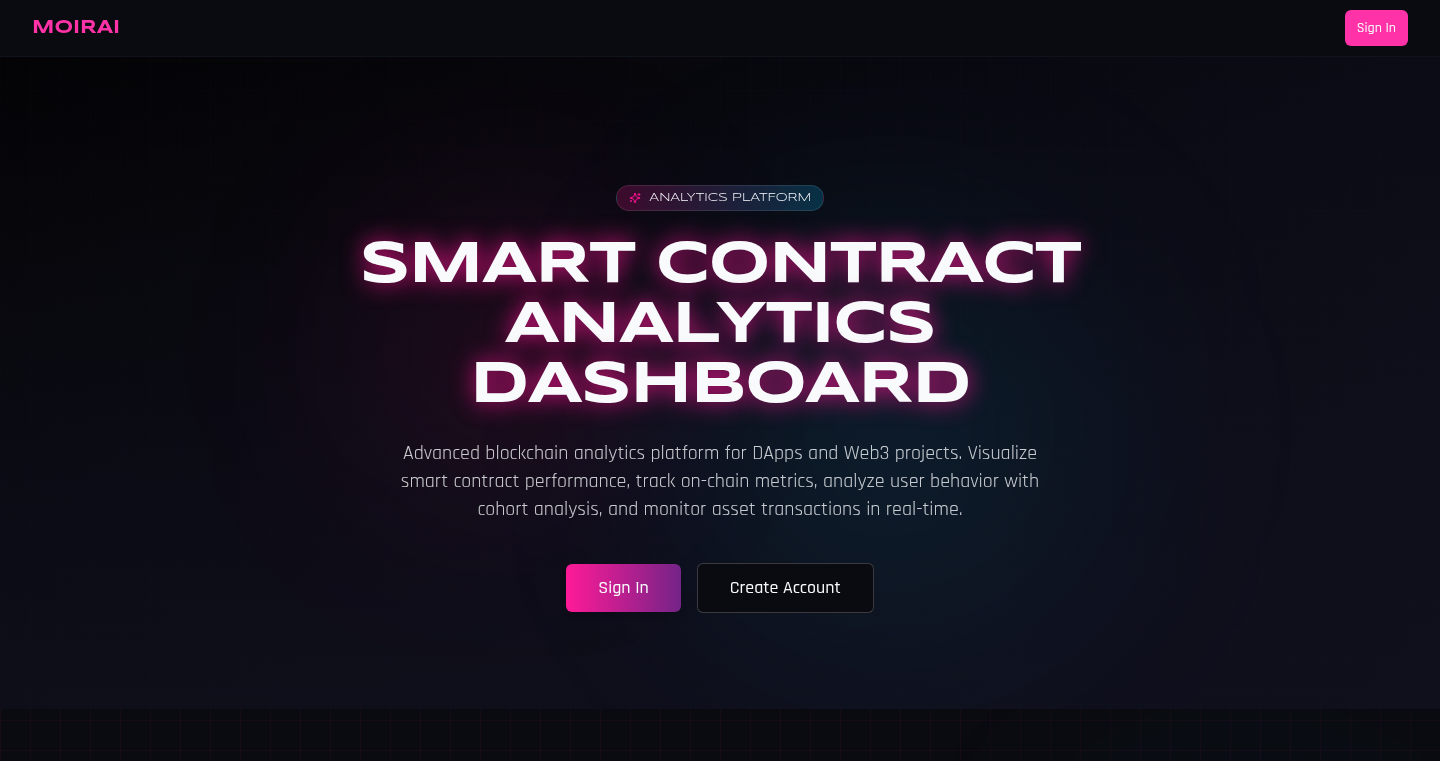
Author
Victorius
Description
Moirai Labs is a free tool that provides product analytics specifically for Ethereum smart contracts. It's similar to popular web analytics platforms like Mixpanel or Amplitude, but instead of tracking website user behavior, it tracks the activity happening inside decentralized applications (dApps) on the Ethereum blockchain. This allows developers to understand how users are interacting with their dApps, monitor key metrics like daily/monthly active users, and identify potential issues like failed transactions or high gas usage. The tool analyzes on-chain data, providing valuable insights into dApp performance and user engagement.
Popularity
Points 1
Comments 0
What is this product?
This project analyzes the data publicly available on the Ethereum blockchain. It uses a combination of technologies to: 1. Fetch data: It pulls transaction data from the blockchain. 2. Process data: This involves parsing transaction logs to understand what actions users are taking within a dApp. 3. Aggregate data: It calculates key metrics such as daily active users (DAU), monthly active users (MAU), and tracks method usage. 4. Present data: It displays this information in charts and reports. The innovation lies in providing a user-friendly interface to access and interpret complex blockchain data, removing the need for developers to build their own data infrastructure. So this tool helps you understand how your dApp is performing.
How to use it?
Developers can use Moirai Labs by entering the address of their smart contract. The tool then starts tracking activity associated with that contract. You can then view dashboards showing key metrics and create custom reports. Integration is straightforward: just provide your contract address. There's no need to connect a wallet to use the service. You can export the data for further analysis. This is useful for understanding user behavior within your dApp and identifying areas for improvement. So you can easily track your dApp's performance.
Product Core Function
· Track DAU/MAU: The tool calculates and displays Daily Active Users (DAU) and Monthly Active Users (MAU), providing a clear picture of user engagement over time. This enables developers to monitor the overall health of their dApp and understand user growth. So you can know how many users are actually using your dApp.
· Monitor method usage: Moirai Labs tracks the frequency of each function (method) call within the smart contract. This helps developers understand which features users are using most frequently and identify potential bottlenecks or underutilized features. So you can figure out what your users are actually doing with your dApp.
· Cohort analysis: The tool allows users to analyze cohorts, groups of users who share a common characteristic. This enables developers to analyze how groups of users are behaving over time. So you can observe behavior changes for specific groups.
· Monitor failed transactions: The tool tracks the number of failed transactions, which can highlight potential problems with the dApp's user experience or smart contract logic. So you can find and fix problems your users are having.
· Gas usage monitoring: It monitors the gas costs associated with transactions, helping developers optimize their smart contracts and reduce transaction fees for users. So you can save users money and optimize your code.
· Token balance monitoring: Track token balances to better understand user token holdings and distribution across your dApp. So you can get insights into your token economy.
· Export reports and charts: The tool allows users to export the data in a variety of formats. This allows developers to perform more advanced data analysis.
· No wallet connection needed: The tool doesn't require users to connect their wallets, making the analytics accessible and user-friendly. So it's easy to get started and use.
Product Usage Case
· DeFi Project: A DeFi project uses Moirai Labs to track DAU/MAU, monitor failed transactions, and understand which smart contract functions are most frequently used. This data helps them identify UX issues, optimize gas costs, and improve user retention. So this helps a DeFi app improve their product.
· NFT Marketplace: An NFT marketplace uses the tool to track the volume of transactions, monitor token transfers, and analyze user behavior related to buying, selling, and trading NFTs. This data helps them understand user behavior and identify features that drive engagement. So this can help an NFT project improve their business.
· Dapp Development: A dapp developer uses Moirai Labs to gain insights into the user adoption and the on-chain behaviour of users of their dapp. So this helps developers to better understand their target group.
· Data Analysis: A data analyst uses the tool to gather data on the usage of various dApps. They export and use the data to create insightful reports. So this can help create better market research.
47
FishSonar: Real-Time Crypto 'Fish' Detector

Author
swampus
Description
FishSonar is an open-source real-time scanner that identifies potentially dubious trading activities, often referred to as 'fishy' trades, on the Binance cryptocurrency exchange (specifically for the BTCUSDT pair). It's like a poker-inspired heads-up display (HUD) for the crypto market, highlighting questionable trades, impulsive moves, and clusters of weak hands. The project leverages Go programming language and follows a Clean Architecture approach, providing a REST API for easy integration. It avoids the complexity of a database and complex setup, focusing on simplicity and real-time analysis.
Popularity
Points 1
Comments 0
What is this product?
FishSonar works by analyzing the real-time order flow data on Binance. It looks for specific patterns and behaviors that suggest unusual or potentially manipulative trading activities. These patterns are classified into archetypes like 'THICC' (large trades), 'SLEEPY' (delayed reactions), 'DUMB' (ill-timed trades), and 'LEVERAGE' (high-risk positions). The project's core innovation lies in its ability to quickly identify and visualize these patterns, offering a unique perspective on market dynamics. It provides a simple REST API, allowing developers to integrate the data into their own tools or dashboards. So what does this mean for you? It provides a fun and accessible way to see what's happening in the crypto market, like a live feed of potentially questionable moves that gives you a feel for the market, and potentially identifying trading risks.
How to use it?
Developers can use FishSonar by simply running the Go application and connecting to its REST API. The API provides real-time data on detected 'fishy' trades, along with their archetypes. This data can then be integrated into various applications, such as live streams, custom dashboards, or automated trading bots. You can integrate it into your own tools to monitor market activity and spot potential risks. The API offers a straightforward way to access the data, making it easy for developers to experiment and build custom solutions. So, if you're a developer, you can use the API to build your own trading dashboards, create alerts, or even develop bots to identify and react to unusual market movements.
Product Core Function
· Real-time detection of suspicious ('fishy') trades: This is the core functionality, identifying trades that exhibit patterns of unusual behavior. This allows you to see potential risks and market inefficiencies as they happen.
· Classification of 'fish' archetypes: The project categorizes suspicious trades into different archetypes (e.g., THICC, SLEEPY, DUMB, LEVERAGE). This classification provides context and helps understand the nature of the suspicious activity. This provides a clearer view of what is happening in the market.
· REST API: The project exposes a REST API, allowing developers to easily access the data and integrate it into their own applications. This makes it simple to create custom dashboards, alerts, or trading tools.
· Ease of use: The project is designed to be easy to run and use, with no complex setup or configuration required. You can get started quickly and without any hassle. It simplifies the use process, making it accessible to a wider audience.
Product Usage Case
· Building a real-time crypto market dashboard: A developer can use the FishSonar API to create a custom dashboard that displays the identified 'fishy' trades alongside other market data. This provides a more intuitive and informative way to monitor market activity. It helps you understand the market's behavior and identify potential opportunities or risks.
· Creating alerts for suspicious trading activity: Developers can use the API to set up alerts that notify them when specific types of 'fishy' trades are detected. This allows them to react quickly to potential market anomalies. It empowers you to react quickly to avoid risks or explore new opportunities.
· Analyzing historical trading data: Although FishSonar focuses on real-time analysis, the API data can be stored and used to analyze historical trading patterns, helping to identify potential market trends and risks. It gives you a deeper understanding of the market over time.
48
EventHorizonDB: A Purpose-Built Event Sourcing Database
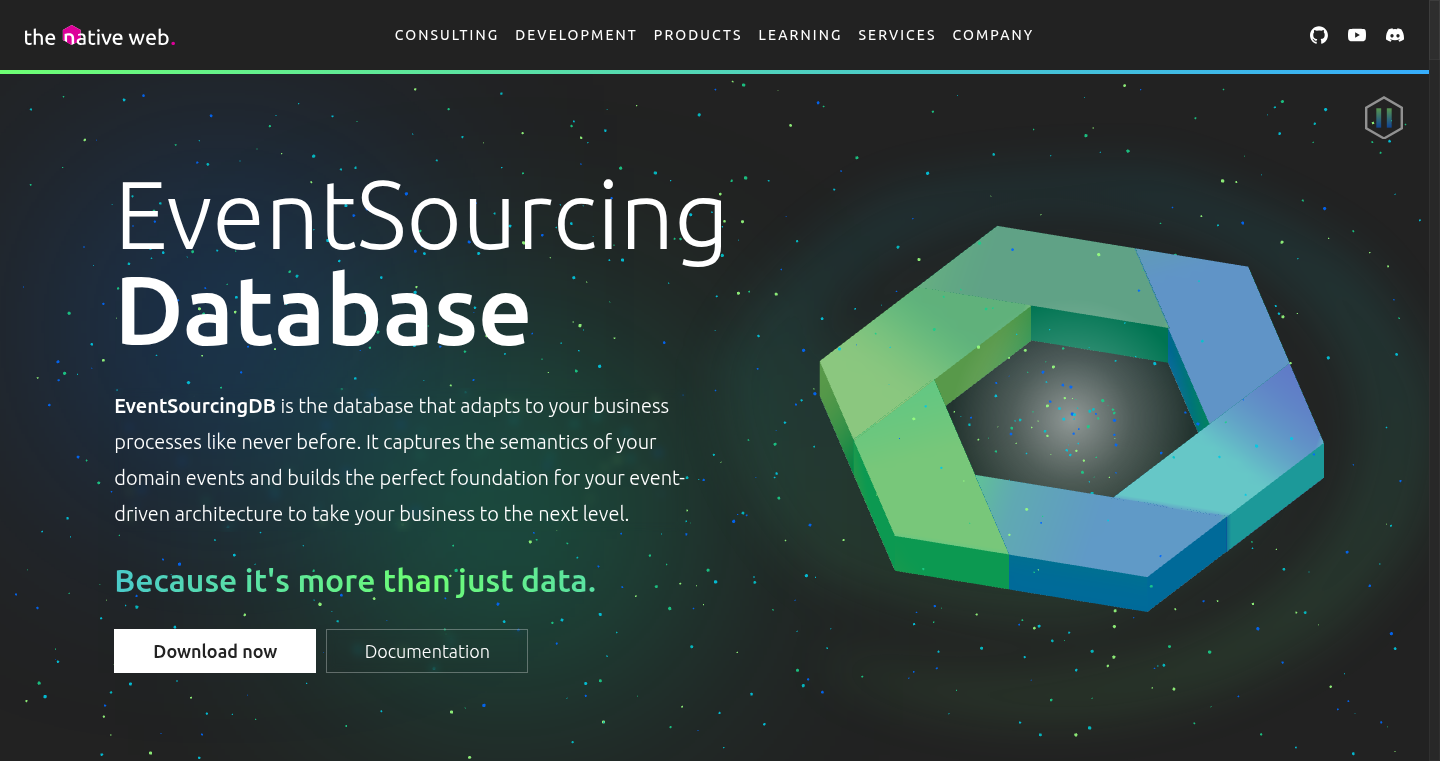
Author
goloroden
Description
EventHorizonDB is a database specifically designed for Event Sourcing. Instead of storing the current state of data, it records every event that changes the data. This approach offers benefits like perfect audit trails, easy debugging, and the ability to reconstruct the state of your application at any point in time. The innovation lies in optimizing storage and retrieval for event streams, offering a specialized solution compared to using general-purpose databases for Event Sourcing.
Popularity
Points 1
Comments 0
What is this product?
EventHorizonDB is a database that's built from the ground up for Event Sourcing. Think of it like a detailed ledger that tracks every single change to your data. Instead of just storing the latest version of your information, it keeps a record of every action that happened. This means you can go back in time, see exactly how your data evolved, and understand the reasons behind every decision. The innovation here is to provide a database that is highly efficient and optimized for storing and querying these event streams, making Event Sourcing simpler and faster.
How to use it?
Developers can use EventHorizonDB as the primary data store for applications that benefit from Event Sourcing, like financial systems, audit logs, or any system where understanding the history of data is critical. You'd integrate it into your application by writing code to publish events (changes to data) to the database and code to read and rebuild the current state from these events. So you’d use it by feeding it the actions, and it would store the entire timeline.
Product Core Function
· Event Storage: Efficiently stores a stream of events. This is vital because it means data is saved fast and makes it easier to track every change. This is super useful for keeping detailed records of everything that happens in your application.
· Event Retrieval: Allows you to quickly retrieve event streams, which is crucial for reconstructing the current state of your system or querying historical data. The quick access speeds up troubleshooting and provides insights.
· Optimized Querying: Specialized query capabilities tailored for event data, enabling efficient searching and analysis of event streams. This lets you extract valuable insights from the stored events more easily.
· Atomic Operations: Ensures that updates to event streams are atomic, preventing data corruption and maintaining data integrity. This guarantees that all events are stored together, avoiding inconsistencies.
Product Usage Case
· Auditing Systems: EventHorizonDB can be used to build systems that need a complete audit trail, allowing you to track every action performed on data. For example, in a financial system, it can track every transaction, which helps comply with regulations and makes debugging easier.
· Real-time Analytics: With the help of EventHorizonDB, developers can build applications that provide real-time analytics by processing event streams. For example, in an e-commerce platform, you can analyze user behavior as events occur, such as clicks, purchases, and product views.
· Debugging and Troubleshooting: Developers can use Event Sourcing with EventHorizonDB to go back in time to understand the state of your application at any point. This enables easy debugging of issues and faster troubleshooting.
49
VoiceAgentMeet: AI-Powered Video Meetings with Integrated Voice and Avatar Agents

Author
imightbekyle
Description
VoiceAgentMeet is a video conferencing application that allows developers to integrate and demonstrate their AI-powered voice agents and avatars directly within a meeting. It leverages open-source technologies like LiveKit for the core video meeting functionality, and customizes it to allow users to bring their own AI voice and avatar agents into the video call. This solves the problem of showcasing voice AI agents in a real-time, interactive, and personalized way, bridging the gap between development and client demonstration.
Popularity
Points 1
Comments 0
What is this product?
This project integrates AI voice and avatar agents into a video conferencing platform. Think of it as a customizable video call system, but instead of just seeing faces, you can interact with AI. The core innovation lies in allowing developers to easily plug in their own voice agents (think Siri or Alexa, but custom-built) and avatars (virtual representations of themselves or characters) into the video call. This is achieved by using LiveKit, a powerful open-source framework for real-time communication, and customizing it to support the integration of AI agents. So, this is a platform to present and test your voice AI agents directly with clients, showing them in action in a realistic meeting scenario.
How to use it?
Developers can integrate their AI voice agents and avatars into the VoiceAgentMeet application. This involves setting up the AI agent's backend (using examples provided or their own code) to handle voice interaction and avatar rendering. The application is built using NextJS for the frontend, allowing for easy customization and integration. Developers can then share the meeting link with clients to demo their agents. This provides a dynamic, interactive demonstration environment, improving the client experience and making it easier to showcase the capabilities of the AI agent. Developers can use the application to troubleshoot issues, receive feedback, and refine their agent's performance. Imagine this as a playground where the developers can bring the AI agents to real-life meetings instead of just demoing the models.
Product Core Function
· Integrated Video Conferencing: This is the base of the application, which uses LiveKit to provide a reliable and customizable video meeting platform. This enables real-time audio and video communication between users and AI agents. So, it's a base for everything else.
· AI Agent Integration: The core of the value proposition, this allows developers to connect their voice agents and avatars to the video conference, enabling interaction with clients. This allows users to present AI agents in a visual and auditive way.
· Backend Agent Examples: The project provides example backends for voice and avatar integration. This helps developers get started quickly by providing templates and guidance on how to integrate their AI agents. This helps accelerate the development process, reducing the time and effort required to get their agents up and running.
· Real-time interaction: Clients can directly interact with the AI agents during the meetings, giving instant feedback and allowing developers to fine-tune the experience on the spot. So, you don't have to tell the client the agent's voice; they can actually hear the agent and interact with it.
Product Usage Case
· AI Development Demo: Developers can use VoiceAgentMeet to showcase their AI voice agents to clients, allowing them to experience the agent's capabilities in a real-time meeting setting. Clients can ask questions, give commands, and get immediate responses from the agent, which helps to show the AI agent's features.
· Voice Agent Testing & Debugging: VoiceAgentMeet provides a platform for testing and debugging AI voice agents. Developers can run tests with live client interaction, allowing for quick feedback and improvement of agent performance. This will improve the agent's performance and its ability to respond to various prompts.
· Virtual Presentation: AI developers can create virtual presentations and demonstrations by using AI avatars within the meeting. They can use avatars to present information, engage with clients and enhance the client experience.
50
QwikHost Review Extractor
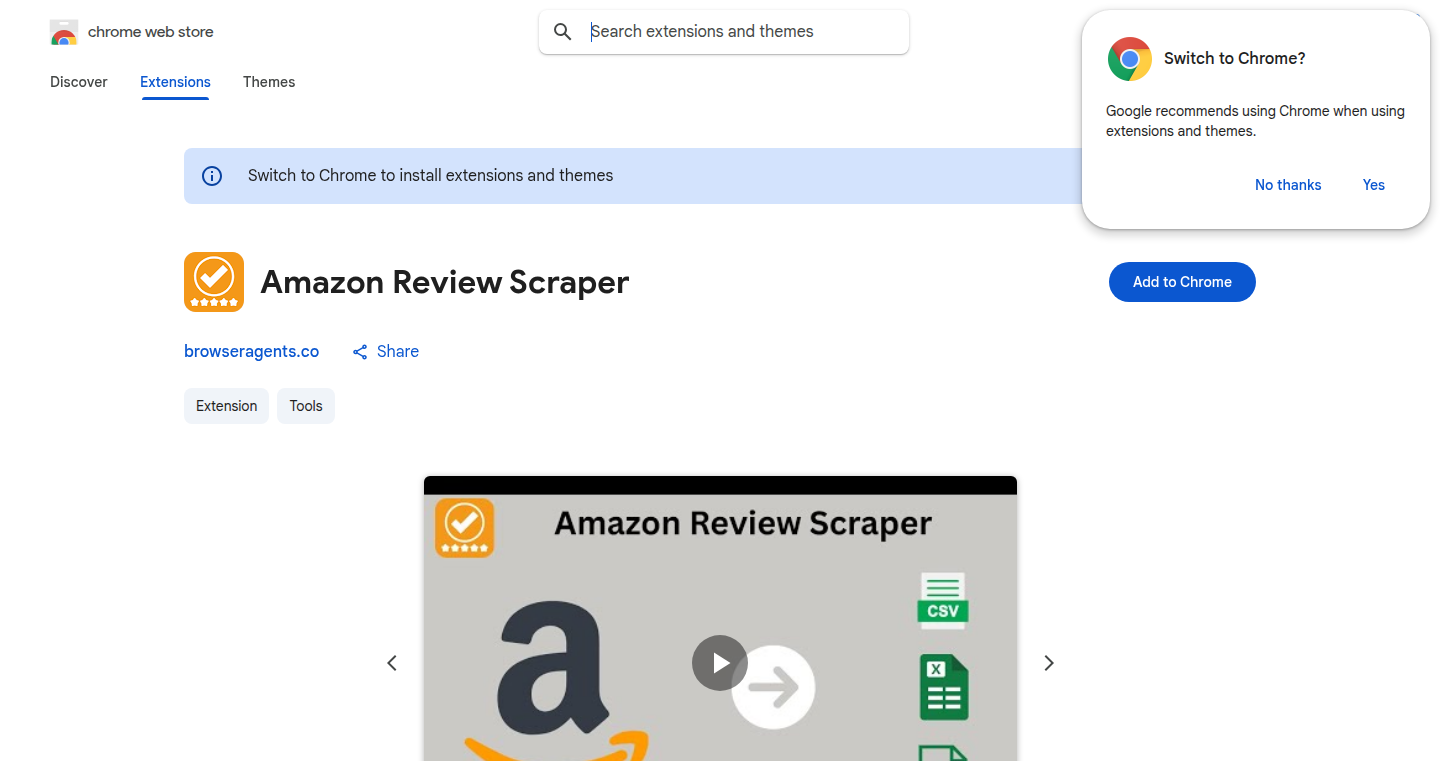
Author
qwikhost
Description
This project is a one-click Amazon review scraper that lets you extract product reviews and export them in CSV, JSON, or Excel formats. The key innovation lies in its automated scraping capabilities, enabling users to quickly gather large datasets of reviews for product research and analysis. It solves the problem of manually collecting and organizing customer feedback, saving time and effort for anyone wanting to understand what customers think about a product.
Popularity
Points 1
Comments 0
What is this product?
This tool uses web scraping technology to automatically collect data from Amazon product pages. Web scraping is like a bot that goes through a website and copies the information you need. In this case, it grabs all the customer reviews for a given product. It then converts this raw data into structured formats like CSV (Comma Separated Values), JSON (JavaScript Object Notation), and Excel files. The innovation is in its simplicity and automation: you give it a product URL, and it gives you the reviews in a usable format. So this is useful because you don't have to manually copy-paste reviews anymore, saving you hours.
How to use it?
Developers can use this tool by either manually entering a product URL or integrating it into their existing workflow using the exported data. You could, for example, import the CSV file into a data analysis program like R or Python with pandas, or use the JSON data within your own web application. This could involve setting up automated processes to monitor product sentiment over time or to compare reviews across different products. So this means you can easily build your own analysis tools or integrate reviews into your existing projects.
Product Core Function
· Automated Review Scraping: Automatically extracts customer reviews from Amazon product pages. This is useful because it drastically reduces the time needed to collect customer feedback.
· Data Export in Multiple Formats (CSV, JSON, Excel): Provides flexibility in how you can use the extracted data. CSV is great for spreadsheets, JSON for programmatic use, and Excel for easy organization. This allows for easier data processing and analysis in different tools.
· One-Click Operation: Makes it simple to use, even for non-technical users. No need to write complex scripts or understand the intricacies of web scraping. This democratizes access to customer feedback, allowing anyone to analyze reviews.
· Product Research: Collects reviews for comparison across products, helping in understanding customer preferences and making informed decisions. This allows businesses to better understand their competition and improve their own products.
· Competitive Analysis: Gathers competitor product reviews for sentiment analysis, and feature comparison. This means you can stay one step ahead of your competitors by understanding what customers like and dislike about their products.
Product Usage Case
· E-commerce Businesses: An e-commerce business can use this to collect reviews of its own products and its competitors' products to understand customer sentiment and identify areas for improvement or new feature development. This helps optimize marketing strategies and product development efforts, ultimately boosting sales.
· Market Research: Market researchers can use the tool to analyze reviews for various products in a specific category. This provides valuable insights into market trends, customer preferences, and competitor analysis. This can help identify new market opportunities and inform product development.
· Product Management: Product managers can track customer reviews to gauge the success of a product, understand customer pain points, and identify areas for enhancement. This supports data-driven decision-making, resulting in better product offerings.
· Sentiment Analysis: Developers could feed the extracted review data into a Natural Language Processing (NLP) model to determine the overall sentiment (positive, negative, neutral) expressed in the reviews. This lets you understand the overall customer perception of a product without reading every review. This information can then be used to improve marketing campaigns or make product adjustments.
51
CD Interest Calculator: Your Financial Clarity Companion

Author
kuzej
Description
This project is a web-based Certificate of Deposit (CD) interest calculator. It's designed to help users easily understand and compare CD interest rates, compounding frequencies, and terms, without needing to navigate complex bank websites or spreadsheets. It stands out by prioritizing user privacy, performing all calculations locally in the browser, and offering visual aids to understand the growth of investments over time. It includes features like reverse rate calculation and tax impact analysis.
Popularity
Points 1
Comments 0
What is this product?
This project is a web application that calculates the interest earned on Certificates of Deposit (CDs). The core of the project involves implementing the compound interest formula, but it goes beyond a simple calculation. It provides a user-friendly interface where users can input their CD details (initial deposit, interest rate, compounding frequency, and term) and instantly see the projected earnings. The innovation lies in its focus on user experience, including clear visualizations of the investment growth over time, the ability to easily compare different CD options, and the crucial aspect of complete privacy, with all calculations happening directly in the user's browser. This eliminates the need to trust external servers with personal financial data, providing peace of mind.
How to use it?
Users can access the calculator through a web browser. Simply input the required information about your CD, such as the initial deposit, interest rate, compounding frequency (daily, monthly, quarterly, or annual), and the term (length of the CD). The calculator then instantly displays the total interest earned, along with a visual representation of the investment's growth over time. It also offers features like reverse rate calculation, where you can input a target amount and the calculator determines the required interest rate, and tax impact analysis, allowing you to factor in taxes and see the actual take-home earnings. You can integrate this tool into any personal finance planning workflow, whenever you need to evaluate a CD investment. For example, as a developer, you could embed this calculator into your own personal finance applications.
Product Core Function
· Compound Interest Calculation: This is the fundamental function of the tool. It accurately calculates the total interest earned on a CD based on the provided parameters. This is valuable because it removes the need for manual calculations or complex spreadsheets, saving users time and reducing the risk of errors. So this is useful because you don't need to be a math expert to understand how your money is growing.
· Visualizations of Investment Growth: The tool provides charts or graphs to illustrate how the CD investment grows over time. This allows users to see the power of compounding and easily compare different scenarios. This is valuable because visual aids make it easier to understand and compare different investment options. So this is useful because it makes complex financial concepts easy to understand.
· Reverse Rate Calculation: This feature allows users to input a target amount and the calculator determines the required interest rate needed to achieve that amount. This adds a layer of planning capability. This is valuable because it helps users set financial goals and understand what interest rates are needed to achieve them. So this is useful because it helps you plan and set financial goals.
· Tax Impact Analysis: The tool can factor in taxes to show the actual take-home earnings from a CD. This is important because it allows users to see the true financial impact of their investment. This is valuable because it provides a more realistic view of the investment's return. So this is useful because it helps you understand the real value of your investment after taxes.
· Privacy-Focused Design: All calculations are performed locally in the user's browser, ensuring that no sensitive financial data is transmitted or stored on servers. This is valuable because it guarantees user privacy and data security. So this is useful because you can use the tool without worrying about your personal information.
Product Usage Case
· Comparing CD Options: A user is considering two CDs: one with a higher interest rate but a shorter term, and another with a lower rate but a longer term. Using the calculator, they can input the details of each CD and easily compare the projected earnings over the respective terms, visualized through charts, and choose the most beneficial option. This is valuable because it streamlines the process of evaluating different investment options.
· Financial Planning: A user wants to save a specific amount of money within a certain timeframe. Using the reverse rate calculation feature, they can input their target amount and time frame, and the calculator will determine the interest rate needed to achieve their goal. This assists in personal finance planning.
· Tax Planning: An investor wants to understand the after-tax returns of a CD. By inputting their tax bracket into the calculator, they can see how taxes will impact their earnings and make informed decisions. This enables investors to make better decisions by considering the impact of taxes.
52
PrivacyCard: Your Data, Your Control – A Browser-First Digital Business Card
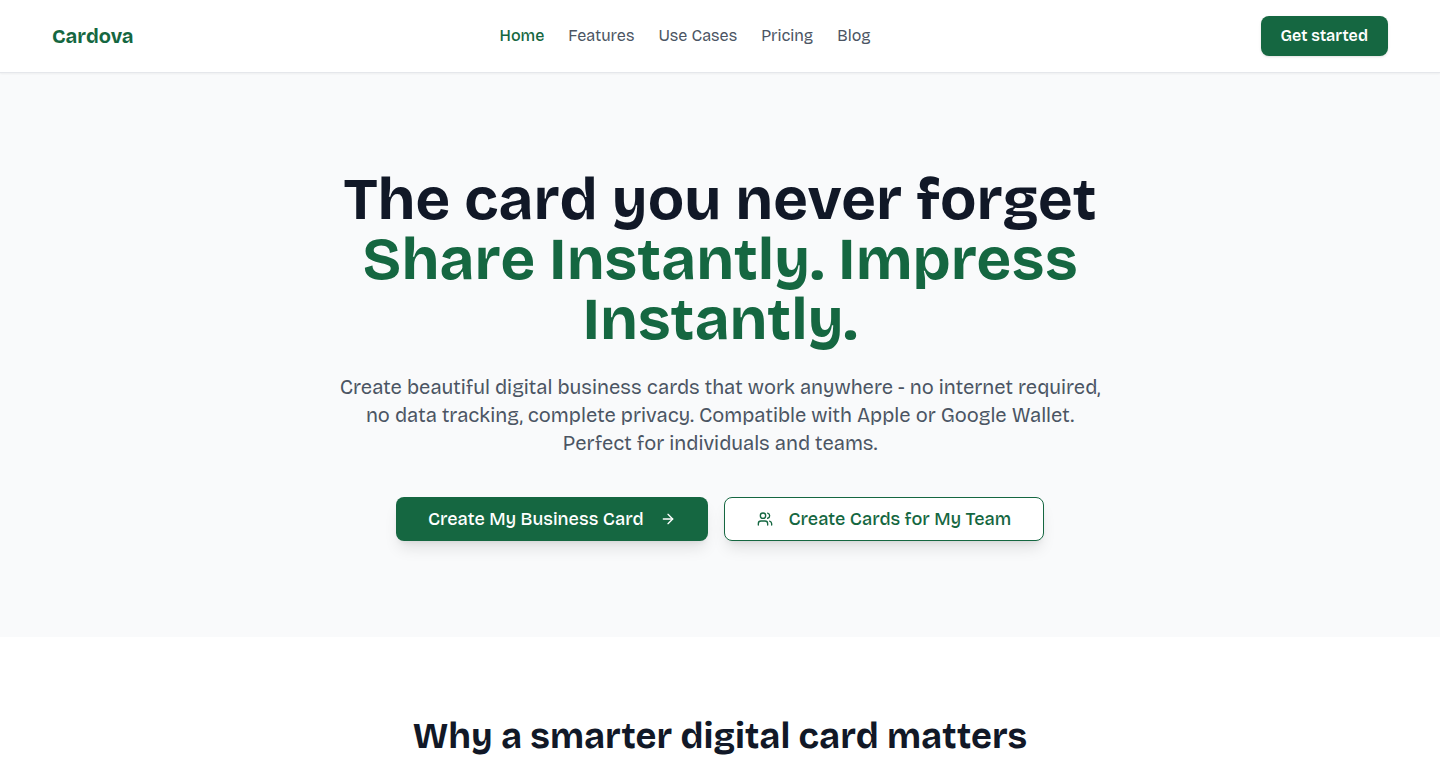
Author
0xjovin
Description
PrivacyCard is a digital business card platform built with a strong focus on user privacy. Unlike many existing platforms that store your personal data on their servers, PrivacyCard processes almost everything within your web browser. It uses a clever mix of browser-side processing and a minimal server-side setup (a simple Vercel cloud function for Apple Wallet integration). This innovative approach ensures your data stays under your control and minimizes the risk of data breaches. The trade-off? Editing your card is limited, as no data is stored for editing. This addresses the problem of digital card platforms storing your personal information, giving you more control over your digital identity.
Popularity
Points 1
Comments 0
What is this product?
PrivacyCard is a digital business card that prioritizes your privacy. It works by processing your card data directly in your web browser. When you create a card, your personal information is processed and handled by your browser instead of a central database. Only your email is used for account creation. It cleverly uses a Vercel cloud function to add the card to your Apple Wallet. So, why is this important? Because it prevents your data from being stored on someone else's servers. This gives you more control over your data and makes it less vulnerable to potential data leaks. So this means it doesn't save your data somewhere else, it keeps it on your device, so no one else can get it.
How to use it?
Developers can use PrivacyCard by leveraging the provided platform to generate and manage their digital business cards. The platform could provide APIs or tools for integrating with other applications or services. You could use it to share your contact information quickly and securely. Imagine you're at a conference: instead of handing out paper cards, you can share your digital card via a link or a QR code. This reduces paper waste and is much more convenient. The Apple Wallet integration allows users to save the card on their devices. This gives you a way to quickly share your info, without worrying about privacy issues. It focuses on keeping the data local, so you're in control. So for developers it offers a way to create a privacy-focused digital card.
Product Core Function
· Browser-Side Processing: The core functionality is processing your business card data directly within your web browser. This means your information stays on your device, keeping it secure from potential server-side data breaches. So this means your personal information is stored on your computer, not someone else's, so it's safer.
· Minimal Server-Side Interaction: The project uses a cloud function (like Vercel) only for Apple Wallet integration. The key is the minimal server-side operation, designed specifically to offer a balance of functionality while minimizing data storage on the server. So you get features like adding to Apple Wallet, without compromising privacy.
· Privacy-Focused Design: Privacy is the guiding principle. It uses browser-side processing, eliminating the need to store user data. This approach minimizes the potential attack surface and gives users full control over their data. So this means they're really committed to your privacy.
Product Usage Case
· Conference Networking: At a conference, you can share your PrivacyCard link with new contacts. The recipients can quickly view your card and save it to their phone, all while ensuring their data isn't stored on a third-party server. This is more secure way to exchange information.
· Personal Use: Share your PrivacyCard easily with colleagues or friends using a QR code. Since no data is stored in the cloud, you have increased control. So it's an easy and safe way to share your contact details.
· Developer Portfolios: Developers can link to their PrivacyCard from their portfolios or resumes. This allows potential employers or clients to access their contact information easily, while they are in control of their data.